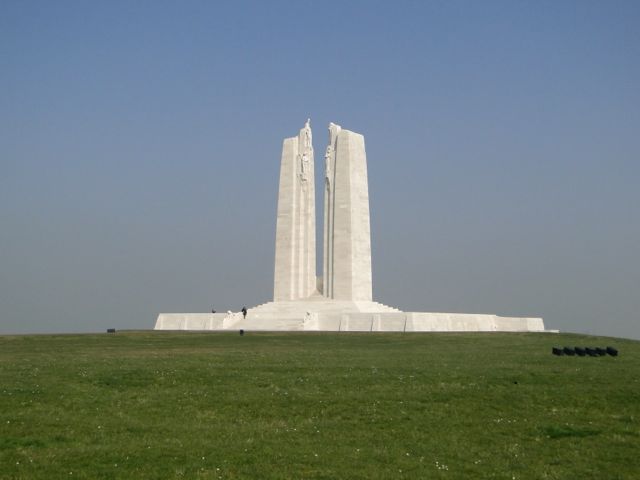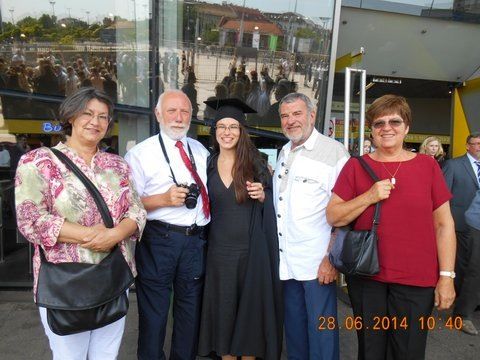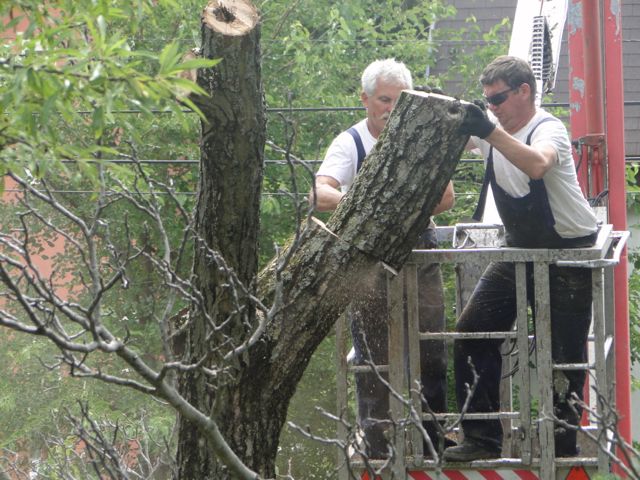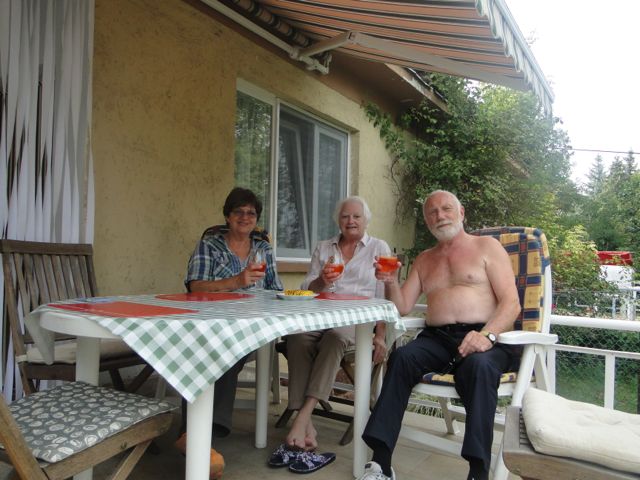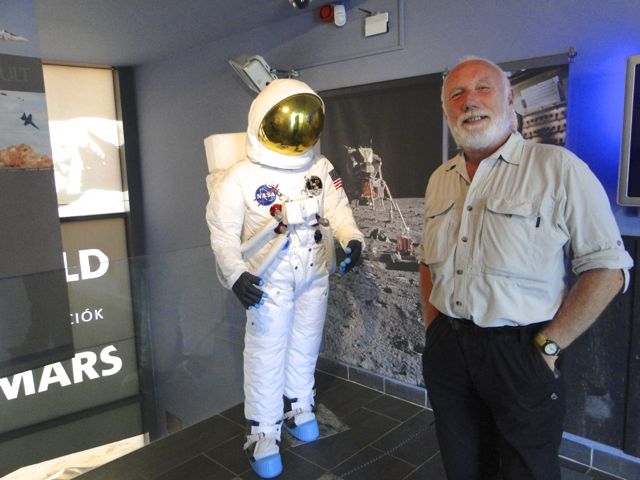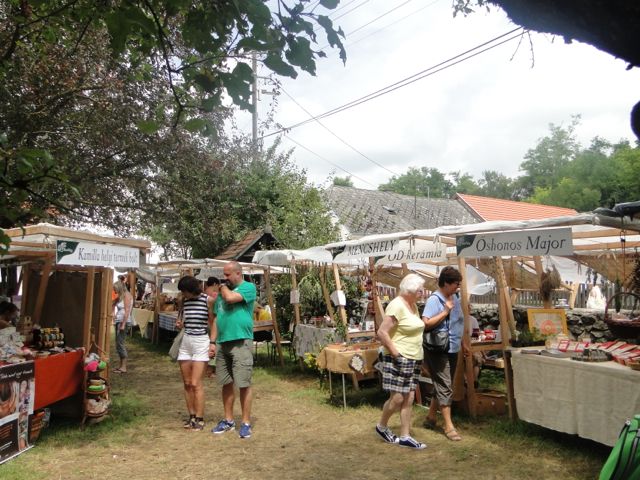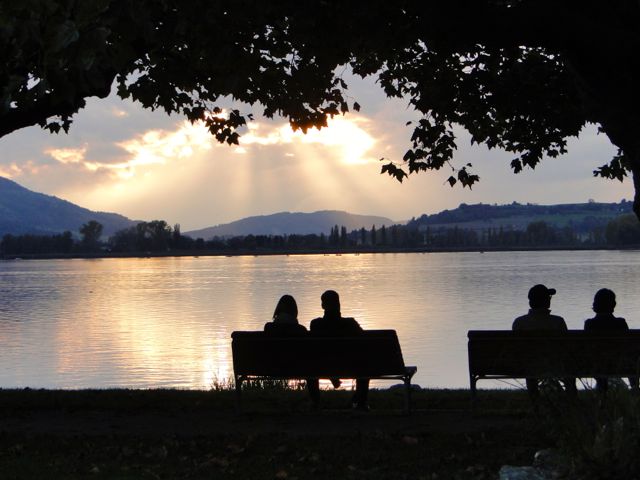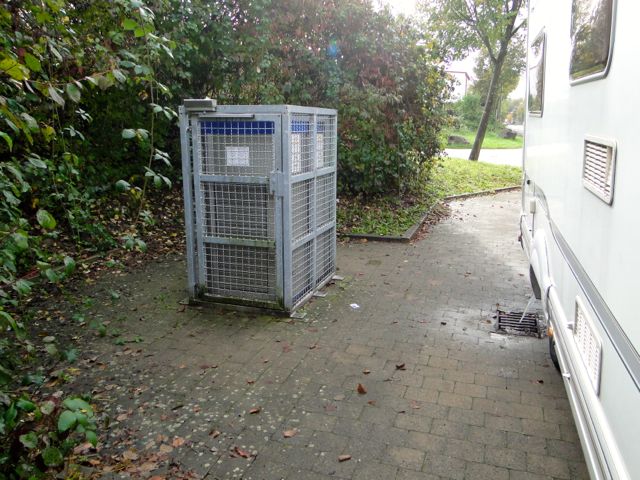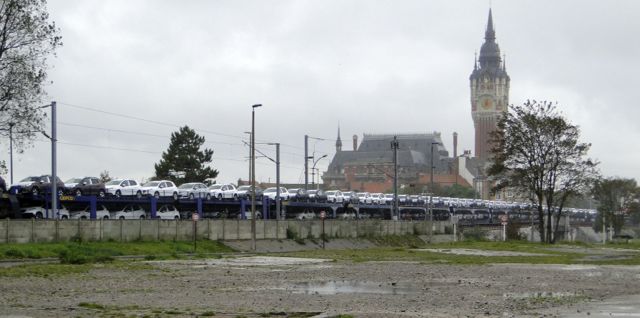THROUGH FRANCE TO SICILY, 2014
Tuesday 11 March 2014
We arrived at Dover to be told that the Calais ferry was delayed by one hour and were given the option to take the Dunkirk ferry which was just boarding.
The crossing was calm but foggy and we only saw one other ship in the distance all the way across the channel.
Just for the change of scene we did not park up at the Dunkirk car park but drove to the Aire in Calais; there are three “chip shops” in the adjoining car park. The Aire was almost full with around 50 MHs when we arrived. We had fish and chips for dinner, but they do not compare well against Whitby fish and chips!
During the night the ships entering and leaving Calais were very noisy and the weather was very cold.
We arrived at Dover to be told that the Calais ferry was delayed by one hour and were given the option to take the Dunkirk ferry which was just boarding.
The crossing was calm but foggy and we only saw one other ship in the distance all the way across the channel.
Just for the change of scene we did not park up at the Dunkirk car park but drove to the Aire in Calais; there are three “chip shops” in the adjoining car park. The Aire was almost full with around 50 MHs when we arrived. We had fish and chips for dinner, but they do not compare well against Whitby fish and chips!
During the night the ships entering and leaving Calais were very noisy and the weather was very cold.
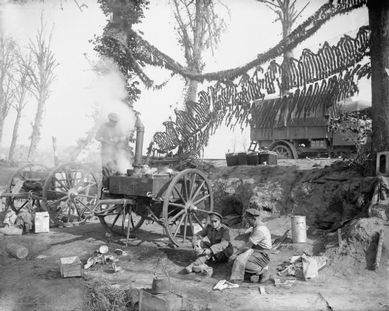 KOYLI Field Kitchen 1917.
KOYLI Field Kitchen 1917.
Wednesday 12 March 2014
Family History
Thank goodness for gas heating because the morning was very cold indeed. After breakfast it was back up the road to Dunkirk and the motorway towards Lille. It was foggy all the way.
From the motorway we headed for the Vieux-Berquin to Neuf-Berquin road where Ian’s grandfather, Fred, was involved in a battle during WW1.
Fred was a coal miner at Denby Grange Colliery near Wakefield. He joined the army on 3rd March 1915 at Wakefield, aged 33, and was posted to the 12th Battalion (Miners Pioneers) of the King's Own Yorkshire Light Infantry.
In 1918 the 31st Division fought at The Battle of St Quentin; The Battle of Bapaume; The First Battle of Arras; The Battle of Estaires; The Battle of Hazebrouck; The Defence of Nieppe Forest; The attack at La Becque; The capture of Vieux Berquin; The Battle of Ypres (1918); The action of Tieghem.
Family History
Thank goodness for gas heating because the morning was very cold indeed. After breakfast it was back up the road to Dunkirk and the motorway towards Lille. It was foggy all the way.
From the motorway we headed for the Vieux-Berquin to Neuf-Berquin road where Ian’s grandfather, Fred, was involved in a battle during WW1.
Fred was a coal miner at Denby Grange Colliery near Wakefield. He joined the army on 3rd March 1915 at Wakefield, aged 33, and was posted to the 12th Battalion (Miners Pioneers) of the King's Own Yorkshire Light Infantry.
In 1918 the 31st Division fought at The Battle of St Quentin; The Battle of Bapaume; The First Battle of Arras; The Battle of Estaires; The Battle of Hazebrouck; The Defence of Nieppe Forest; The attack at La Becque; The capture of Vieux Berquin; The Battle of Ypres (1918); The action of Tieghem.
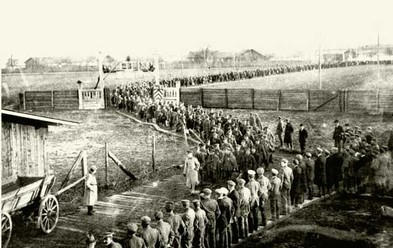 Prisoners in Limburg POW camp.
Prisoners in Limburg POW camp.
The 12th Battalion was noted for its stand against the German advance on the Somme on April 13th 1918 at La Couronne. The Battalion spent the first week of April 1918 at Cambligneul, improving its infantry and rifle skills after months of pioneer duties.
On April 10th they moved in buses to Vieux Berquin in the Bailleul sector. The next day the Division put the pioneer battalion in the front line astride the Caestre – Estaires Road with 19 officers and 510 men with the task of forming a defensive line to prevent the German's continued advance. The next day it was realized they were rather too far forward, so the Battalion moved back to form a defence based on the cross roads at La Couronne. That was where they spent the night of 12th April digging in. At 8.30 a.m. on the 13th April machine gun fire intensified on their trenches and an attack immediately developed. On the left of the cross roads the 12th Battalion beat off four attacks, but the trenches on the right were less well dug and the men of the battalion there had to fall back. This exposed their right flank and at about 01:30 pm the enemy took advantage of this and attacked, from house to house, down the village and broke the 12th Battalion's line.
Under pressure the whole battalion now pulled back to La Becque Farm but discovered this was covered by enemy machine guns, so they withdrew further back to some posts held by the Australians (1st Aus Div) in the Rue Du Bois. They spent the night of the 13th April in those posts and were then withdrawn in the early morning of the 14th April. Of the 19 officers and 510 men who went into action the 12th Battalion lost 12 officers and 263 other ranks killed or wounded.
On the morning of April 14th Fred did not answer his name at roll call. No one had seen him killed. He was reported: "Missing 13.4.1918".
Later, the Red Cross reported he was a prisoner of war at Limburg POW Camp.
On April 10th they moved in buses to Vieux Berquin in the Bailleul sector. The next day the Division put the pioneer battalion in the front line astride the Caestre – Estaires Road with 19 officers and 510 men with the task of forming a defensive line to prevent the German's continued advance. The next day it was realized they were rather too far forward, so the Battalion moved back to form a defence based on the cross roads at La Couronne. That was where they spent the night of 12th April digging in. At 8.30 a.m. on the 13th April machine gun fire intensified on their trenches and an attack immediately developed. On the left of the cross roads the 12th Battalion beat off four attacks, but the trenches on the right were less well dug and the men of the battalion there had to fall back. This exposed their right flank and at about 01:30 pm the enemy took advantage of this and attacked, from house to house, down the village and broke the 12th Battalion's line.
Under pressure the whole battalion now pulled back to La Becque Farm but discovered this was covered by enemy machine guns, so they withdrew further back to some posts held by the Australians (1st Aus Div) in the Rue Du Bois. They spent the night of the 13th April in those posts and were then withdrawn in the early morning of the 14th April. Of the 19 officers and 510 men who went into action the 12th Battalion lost 12 officers and 263 other ranks killed or wounded.
On the morning of April 14th Fred did not answer his name at roll call. No one had seen him killed. He was reported: "Missing 13.4.1918".
Later, the Red Cross reported he was a prisoner of war at Limburg POW Camp.
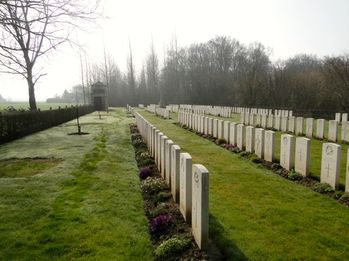 Commonwealth War Graves Commission Cemetery at Aval Wood.
Commonwealth War Graves Commission Cemetery at Aval Wood.
We followed the approximate route of the “pull back” to Rue Du Bois. There was a narrow dirt track between a farm and the forest. Just 200 yards up the track was a Commonwealth War Graves Commission Cemetery called Aval Wood Cemetery. It was a very sobering experience to stand on the very spot that must surely have contained the bodies of some of Fred’s mates.
On our way to Arras we stopped at a beautiful CWGC cemetery for Indians and another for Portuguese at Neuve-Chapelle (N 50° 34.509', E 2° 46.511')
We found the free Aire at Arras with no problems and after lunch we meandered into the town. In the centre are two “Place” (Squares) which are very attractive and built in a traditional flemish style. We also took a lift to the top of the Town Hall bell tower which afforded wonderful views of the town and surrounding countryside... the fog was burning off by now. In fact it was a warm day, 23°C.
On our way to Arras we stopped at a beautiful CWGC cemetery for Indians and another for Portuguese at Neuve-Chapelle (N 50° 34.509', E 2° 46.511')
We found the free Aire at Arras with no problems and after lunch we meandered into the town. In the centre are two “Place” (Squares) which are very attractive and built in a traditional flemish style. We also took a lift to the top of the Town Hall bell tower which afforded wonderful views of the town and surrounding countryside... the fog was burning off by now. In fact it was a warm day, 23°C.
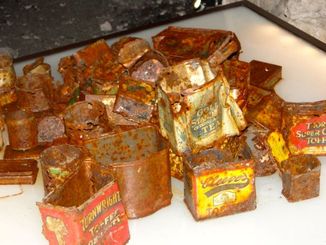 Bully Beef tins in Wellington Quarry.
Bully Beef tins in Wellington Quarry.
Thursday 13 March 2014
Secret tunnels
From the aire to the Wellington Quarry is a 45 minute walk. It is not really a quarry but a shallow mine for limestone. The locals had used the stone for building over many years. In 1916 the New Zealand soldiers dug a complex of tunnels and galleries to link the different quarries. These led to near the German lines. More than 20,000 British soldiers were gathered together in this secret location. On the morning of 9 April 1917 the emerged just meters from the front line as part of the Arras Offensive.
The guided tour is very informative and describes daily life of the soldiers as well as the big picture.
Many “authorities” claim that the soldiers were lions led by donkeys”.
When one realizes that before WW1 war had been a matter of grouping at one end of a field with the enemy opposite them. Then using short range artillery and cavalry alongside the infantry the battle commenced and was over in quick time.
Visiting places such as Arras make you realize what a difficult job it was for the Generals. They had to learn new techniques, new weapons and a lot of imagination. For example, the tunnels at Wellington quarry, the use of the new novelty, the airplane, balloons, long range artillery, tanks, fantastic logistics. Yes, they made some amazing blunders but they also adopted, adapted and improved many new ideas.
Secret tunnels
From the aire to the Wellington Quarry is a 45 minute walk. It is not really a quarry but a shallow mine for limestone. The locals had used the stone for building over many years. In 1916 the New Zealand soldiers dug a complex of tunnels and galleries to link the different quarries. These led to near the German lines. More than 20,000 British soldiers were gathered together in this secret location. On the morning of 9 April 1917 the emerged just meters from the front line as part of the Arras Offensive.
The guided tour is very informative and describes daily life of the soldiers as well as the big picture.
Many “authorities” claim that the soldiers were lions led by donkeys”.
When one realizes that before WW1 war had been a matter of grouping at one end of a field with the enemy opposite them. Then using short range artillery and cavalry alongside the infantry the battle commenced and was over in quick time.
Visiting places such as Arras make you realize what a difficult job it was for the Generals. They had to learn new techniques, new weapons and a lot of imagination. For example, the tunnels at Wellington quarry, the use of the new novelty, the airplane, balloons, long range artillery, tanks, fantastic logistics. Yes, they made some amazing blunders but they also adopted, adapted and improved many new ideas.
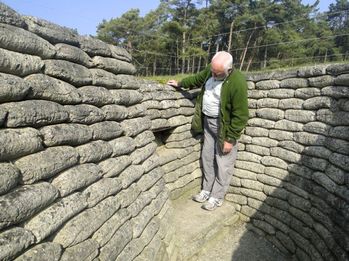 Ian inspects trenches at Vimy Ridge.
Ian inspects trenches at Vimy Ridge.
Friday 14 March 2014
Vimy Ridge
Thick fog. But we had a quick cleaning session and then made our way to Vimy Ridge.
The Canadian Memorial is memorable and commemorates the death of 11,285 soldiers lost on French soil in the Great War. The 107 hectare (264 acre) site overlooking the Pas de Calais coal basin and had been held by the Germans since the start of hostilities. From there they had been able to shell Arras and the surrounding area with ease.
On 10 April 1917 Canadian troops fighting as part of the British Army captured Vimy Ridge. The memorial’s white pylons and sculptured figures mark a defining moment in the history of Canada.
On our way south towards Bapaume we passed many other war cemeteries.
We attempted to find an Aire in Bapaume but it certainly was not where the coordinates said. So we drove on to Peronne and found a campsite open.
Vimy Ridge
Thick fog. But we had a quick cleaning session and then made our way to Vimy Ridge.
The Canadian Memorial is memorable and commemorates the death of 11,285 soldiers lost on French soil in the Great War. The 107 hectare (264 acre) site overlooking the Pas de Calais coal basin and had been held by the Germans since the start of hostilities. From there they had been able to shell Arras and the surrounding area with ease.
On 10 April 1917 Canadian troops fighting as part of the British Army captured Vimy Ridge. The memorial’s white pylons and sculptured figures mark a defining moment in the history of Canada.
On our way south towards Bapaume we passed many other war cemeteries.
We attempted to find an Aire in Bapaume but it certainly was not where the coordinates said. So we drove on to Peronne and found a campsite open.
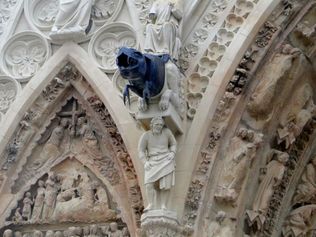 Fine masonry at Reims Cathedral.
Fine masonry at Reims Cathedral.
Saturday 15 March 2014
We left the campsite with the intention of visiting the local castle. The plan was abandoned when we found the street was an open market. So we headed for Reims. Not taking toll roads is a good way to see France. The roads are not too busy and the countryside is very open.
Luckily the Aire was exactly where the SatNav said and soon we were established and ready for a walk. The first job was to visit the cathedral of Notre Dame; a gothic building started in 1211. To be honest it is quite a structure but rather gloomy inside. There are some wonderful stained glass windows but the modern ones look like somebody simply assembled any bit of glass the could find... in any order.
After that we had a roam around the town and found the Town Hall and Mars Gate dating from Roman times.
In the evening Ian made some chunky potato wedges to accompany the meal.
Delicious and easy, thanks to James Martin’s recipe.
We left the campsite with the intention of visiting the local castle. The plan was abandoned when we found the street was an open market. So we headed for Reims. Not taking toll roads is a good way to see France. The roads are not too busy and the countryside is very open.
Luckily the Aire was exactly where the SatNav said and soon we were established and ready for a walk. The first job was to visit the cathedral of Notre Dame; a gothic building started in 1211. To be honest it is quite a structure but rather gloomy inside. There are some wonderful stained glass windows but the modern ones look like somebody simply assembled any bit of glass the could find... in any order.
After that we had a roam around the town and found the Town Hall and Mars Gate dating from Roman times.
In the evening Ian made some chunky potato wedges to accompany the meal.
Delicious and easy, thanks to James Martin’s recipe.
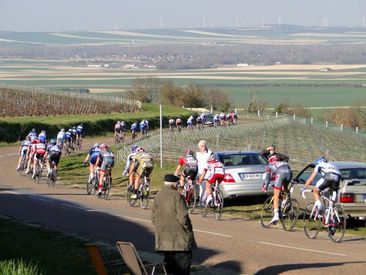 Cycle race passing through Montgueux.
Cycle race passing through Montgueux.
Sunday 16 March 2014
France Passion
In the morning Judit went to the art gallery but it was closed. Ian stayed in the MH to write notes, etc. During that time a team of cleaners came to tidy up the car park with pressure washers. This meant that Ian had to use 6 kettles of water to clean the dirty spray from the back of Bessy.
The journey south was very pleasant with wide rolling countryside and a sun in the sky. The aim was to stay near Troyes and we found a France Passion site at Montgueux. While waiting for the owners to come home we were able to watch a cycle race through the village.
What a strange spectator sport. The crowd gathered in anticipation before many cars and vans shot by closely followed by the group of riders. They flashed past on the downhill leg of the race. All told, within 2 minutes the event was over and every one went home. A sort of premature circulation.
Later the lady of the house arrived and we bought a bottle of VERY fizzy cider and a bottle of champagne.
France Passion
In the morning Judit went to the art gallery but it was closed. Ian stayed in the MH to write notes, etc. During that time a team of cleaners came to tidy up the car park with pressure washers. This meant that Ian had to use 6 kettles of water to clean the dirty spray from the back of Bessy.
The journey south was very pleasant with wide rolling countryside and a sun in the sky. The aim was to stay near Troyes and we found a France Passion site at Montgueux. While waiting for the owners to come home we were able to watch a cycle race through the village.
What a strange spectator sport. The crowd gathered in anticipation before many cars and vans shot by closely followed by the group of riders. They flashed past on the downhill leg of the race. All told, within 2 minutes the event was over and every one went home. A sort of premature circulation.
Later the lady of the house arrived and we bought a bottle of VERY fizzy cider and a bottle of champagne.
 Old centre of Troyes.
Old centre of Troyes.
Monday 17 March 2014
Quite foggy again but soon cleared as we drove downhill to the city of Troyes. Luckily there was space in the station car park. €6.4 for 2 hours.
The old centre of Troyes has a centre that full of the finest half-timbered houses ad Gothic churches. Many of the 16th Century buildings really do lean and in some streets the houses almost touch.
Interestingly the “troy ounce” used for measuring gold bullion came from here. It was the standard of exchange in Troyes in the 12th and 13th Centuries.
After a burst around the city... temperature 10°C... we drove to Dijon.
The route was really very pleasant because once again we specified no toll roads and the sun was now shining.
On arrival in Dijon we easily found the Camping Du Lac. But it is only open from 31 March to October. Luckily there is an Aire alongside with the barrier raised and half a dozen lucky motorhomers using the free electricity.
Quite foggy again but soon cleared as we drove downhill to the city of Troyes. Luckily there was space in the station car park. €6.4 for 2 hours.
The old centre of Troyes has a centre that full of the finest half-timbered houses ad Gothic churches. Many of the 16th Century buildings really do lean and in some streets the houses almost touch.
Interestingly the “troy ounce” used for measuring gold bullion came from here. It was the standard of exchange in Troyes in the 12th and 13th Centuries.
After a burst around the city... temperature 10°C... we drove to Dijon.
The route was really very pleasant because once again we specified no toll roads and the sun was now shining.
On arrival in Dijon we easily found the Camping Du Lac. But it is only open from 31 March to October. Luckily there is an Aire alongside with the barrier raised and half a dozen lucky motorhomers using the free electricity.
 Market in the centre of Dijon.
Market in the centre of Dijon.
Tuesday 18 March 2014
No mustard
From the camp you can follow a path alongside the river towards the centre of Dijon. It’s a pleasant walk of about 2 Km through parkland before hitting the traffic.
We amused ourselves by following the small brass plates set in the pavement to guide tourists on a route around the city. Judit enjoyed herself photographing every building in site while Ian ambled along behind. At the tourist info office we found that most places are closed Monday and Tuesday and that Dijon mustard is not made in Dijon but a nearby town in a giant factory.
Ian ate an “American” for lunch while Judit had a standard kebab. An American is 4 small burgers and salad in a pitta bread. Although the morning temperature is not wonderful (around 10°C) the daytime temperature is a very pleasant 24°C in the motorhome with doors and windows open.
No mustard
From the camp you can follow a path alongside the river towards the centre of Dijon. It’s a pleasant walk of about 2 Km through parkland before hitting the traffic.
We amused ourselves by following the small brass plates set in the pavement to guide tourists on a route around the city. Judit enjoyed herself photographing every building in site while Ian ambled along behind. At the tourist info office we found that most places are closed Monday and Tuesday and that Dijon mustard is not made in Dijon but a nearby town in a giant factory.
Ian ate an “American” for lunch while Judit had a standard kebab. An American is 4 small burgers and salad in a pitta bread. Although the morning temperature is not wonderful (around 10°C) the daytime temperature is a very pleasant 24°C in the motorhome with doors and windows open.
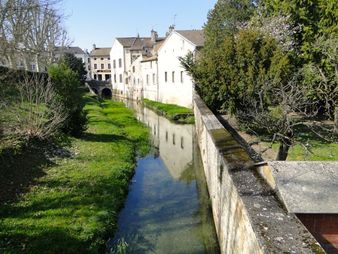 Part of the moat around Beaune city walls.
Part of the moat around Beaune city walls.
Wednesday 19 March 2014
Today we had a very short run to Beaune where there is an interesting walled centre to the town. The route passed Nuit Saint George and other Burgundy vineyards.
The campsite at Beaune is just a few hundred yards from the centre and is well appointed. We therefore did a bit of shopping, website updating and generally relaxing.
Thursday 20 March 2014
Custard
After doing yet another load of washing we walked the few hundred yards into the town of Beaune. It is really rather attractive and very pleasant to walk around. The centre is very compact. There is no shortage of restaurants and it was difficult to decide which one would provide our first French meal. Restaurant Dame Tartine was the winner.
We settled for the set menu where we could have a main course and a dessert or coffee or cheese for €11.50.
Judit chose escalope of veal with veg and deep fried sliced potatoes (there must be a posh name for these). Ian had a slice of gammon (translated as Little Salty) on a plate of lentils. Dessert was half a pear poached in red wine with almonds or “Opera with Creme Anglais”. This was a slice of cake with custard.
The whole meal was well presented and quite tasty, but with the addition of two glasses of cheap red wine and a coffee cost almost €40. Not a cheap working man’s lunch!
Today we had a very short run to Beaune where there is an interesting walled centre to the town. The route passed Nuit Saint George and other Burgundy vineyards.
The campsite at Beaune is just a few hundred yards from the centre and is well appointed. We therefore did a bit of shopping, website updating and generally relaxing.
Thursday 20 March 2014
Custard
After doing yet another load of washing we walked the few hundred yards into the town of Beaune. It is really rather attractive and very pleasant to walk around. The centre is very compact. There is no shortage of restaurants and it was difficult to decide which one would provide our first French meal. Restaurant Dame Tartine was the winner.
We settled for the set menu where we could have a main course and a dessert or coffee or cheese for €11.50.
Judit chose escalope of veal with veg and deep fried sliced potatoes (there must be a posh name for these). Ian had a slice of gammon (translated as Little Salty) on a plate of lentils. Dessert was half a pear poached in red wine with almonds or “Opera with Creme Anglais”. This was a slice of cake with custard.
The whole meal was well presented and quite tasty, but with the addition of two glasses of cheap red wine and a coffee cost almost €40. Not a cheap working man’s lunch!
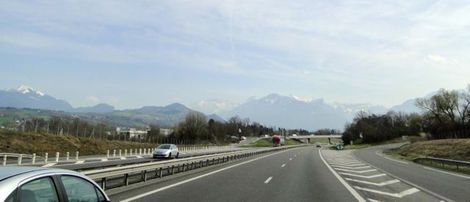 Promise of good views of the Alps.
Promise of good views of the Alps.
Friday 21 March 2014
Into the Alps
We paid our bill and left the Beaune Municipal campsite and went to ALDI, just up the road. Not quite as good as a LIDL but useful. Then we headed south for Bourg en Bresse. They seem to make a big thing of the local hens. Must look that up some time.
We stopped for lunch next to the Bourg en Bresse Municipal campsite; which was closed. From this point on we decided to give the GPS a free rein. If we took non-toll roads our onward journey through the alps would take hours longer than with the toll. In this way we arrived at the Aire at St Pierre en Faucigny.
Luckily there was an ATM just yards away as we will definitely need diesel tomorrow (Petrol stations seem to be closed on Sundays in France). Near the ATM is a row of shops and a charming young man helped us. Past the shops is a lovely small park next to a chateau. Swans on the lake, fish in the lake and an aviary alongside with many colourful birds. All told a lovely little place, except for the fact we are parked next to a level crossing and get the noise of cars plus the noise of trains. Such is life.
Into the Alps
We paid our bill and left the Beaune Municipal campsite and went to ALDI, just up the road. Not quite as good as a LIDL but useful. Then we headed south for Bourg en Bresse. They seem to make a big thing of the local hens. Must look that up some time.
We stopped for lunch next to the Bourg en Bresse Municipal campsite; which was closed. From this point on we decided to give the GPS a free rein. If we took non-toll roads our onward journey through the alps would take hours longer than with the toll. In this way we arrived at the Aire at St Pierre en Faucigny.
Luckily there was an ATM just yards away as we will definitely need diesel tomorrow (Petrol stations seem to be closed on Sundays in France). Near the ATM is a row of shops and a charming young man helped us. Past the shops is a lovely small park next to a chateau. Swans on the lake, fish in the lake and an aviary alongside with many colourful birds. All told a lovely little place, except for the fact we are parked next to a level crossing and get the noise of cars plus the noise of trains. Such is life.
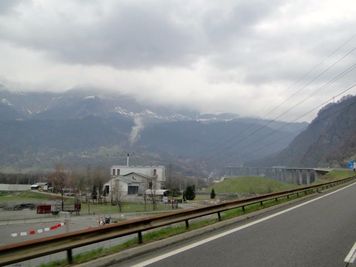 Very overcast in the Mont Blanc region.
Very overcast in the Mont Blanc region.
Saturday 22 March 2014
Into Italy
Low cloud and rain ruined any chance of seeing the peaks of Mont Blanc and the Alps. But first we drove to the nearby town of Amancy where there is a Supermarche selling cheaper diesel and then to the toll road to take us to Mont Blanc tunnel. The drive is impressive through the valleys and along high viaducts clinging to cliff faces. At one point our carriageway was on the left which was a bit alarming at first.
At the tunnel we paid €56.10... the 10 cents must be very important! The traffic is held up at the toll booths until there is 200m vehicle separation. This gave the impression of light traffic. We were through the 11 Km tunnel and into Italy in no time.
On the Italian side we set the SatNav to “Avoid toll roads”... we’ve paid too much already. It meant that we passed through some lovely old towns and villages looking very alpine. Sadly it was raining even harder on the Italian side. It must have looked magnificent in the Aosta valley but we contented ourselves looking at the many castles on hilltops.
We stopped for a snack in the sosta (Aire) at Verres. It was a small car with a dump and a tap and almost full with lorries spending their weekend off the roads.
We turned south-east at Ivrea. The road around the center is one-way and cobbled. Now the countryside is flat and fertile... and the rain stopped. The drive was pleasant and soon we arrived at Casale Monferrato where the internet data shows a sosta. But the coordinates took us to a scruffy back street with no facilities at all.
In the large city square we found a Tourist Information office and they confirmed there is no sosta but we were to use the large car park next to the fortress.
Into Italy
Low cloud and rain ruined any chance of seeing the peaks of Mont Blanc and the Alps. But first we drove to the nearby town of Amancy where there is a Supermarche selling cheaper diesel and then to the toll road to take us to Mont Blanc tunnel. The drive is impressive through the valleys and along high viaducts clinging to cliff faces. At one point our carriageway was on the left which was a bit alarming at first.
At the tunnel we paid €56.10... the 10 cents must be very important! The traffic is held up at the toll booths until there is 200m vehicle separation. This gave the impression of light traffic. We were through the 11 Km tunnel and into Italy in no time.
On the Italian side we set the SatNav to “Avoid toll roads”... we’ve paid too much already. It meant that we passed through some lovely old towns and villages looking very alpine. Sadly it was raining even harder on the Italian side. It must have looked magnificent in the Aosta valley but we contented ourselves looking at the many castles on hilltops.
We stopped for a snack in the sosta (Aire) at Verres. It was a small car with a dump and a tap and almost full with lorries spending their weekend off the roads.
We turned south-east at Ivrea. The road around the center is one-way and cobbled. Now the countryside is flat and fertile... and the rain stopped. The drive was pleasant and soon we arrived at Casale Monferrato where the internet data shows a sosta. But the coordinates took us to a scruffy back street with no facilities at all.
In the large city square we found a Tourist Information office and they confirmed there is no sosta but we were to use the large car park next to the fortress.
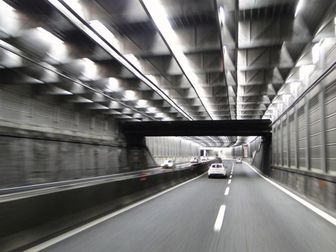 One of the better tunnels under Genoa.
One of the better tunnels under Genoa.
Sunday 23 March 2014
A miserable wet and windy day, all day. So the first part of our day was off motorways to Alessandria. We went past a so-called sosta but it was just a drain in a very full car park next top a block of flats.
After Alessandria we took the toll road to avoid having to cross the mountain passes. According to the SatNav we would also save one hour.
The route took us past/through Genoa. It may be historic but it looked a dump from the viaducts we passed over. From just north of Genoa until we left the motorway was either tunnels or viaducts. Mile after mile of gloomy, under-maintained tunnels with water dripping off the walls. Rather like a coal mine really.
Our plan was to park on the sea front at Rapallo. The town was very busy and narrow and we could not find an entrance to the car park. It was full anyway. So we went four kilometers west to a sosta we found on the internet. We did find it. It was nothing more than a drain at the side of a crowded road. Forget that.
Back to the toll road and off again for Deiva Marina. Suddenly there was peace and quiet and no high rise buildings. The ACSI site was closed but we spotted another one across the river, Camping Valdeiva. At least we have electric, and wifi but for €23 a night. The young lady in reception spoke beautiful English and encouraged us to visit 5 small car-less villages tomorrow. Watch this space.
A miserable wet and windy day, all day. So the first part of our day was off motorways to Alessandria. We went past a so-called sosta but it was just a drain in a very full car park next top a block of flats.
After Alessandria we took the toll road to avoid having to cross the mountain passes. According to the SatNav we would also save one hour.
The route took us past/through Genoa. It may be historic but it looked a dump from the viaducts we passed over. From just north of Genoa until we left the motorway was either tunnels or viaducts. Mile after mile of gloomy, under-maintained tunnels with water dripping off the walls. Rather like a coal mine really.
Our plan was to park on the sea front at Rapallo. The town was very busy and narrow and we could not find an entrance to the car park. It was full anyway. So we went four kilometers west to a sosta we found on the internet. We did find it. It was nothing more than a drain at the side of a crowded road. Forget that.
Back to the toll road and off again for Deiva Marina. Suddenly there was peace and quiet and no high rise buildings. The ACSI site was closed but we spotted another one across the river, Camping Valdeiva. At least we have electric, and wifi but for €23 a night. The young lady in reception spoke beautiful English and encouraged us to visit 5 small car-less villages tomorrow. Watch this space.
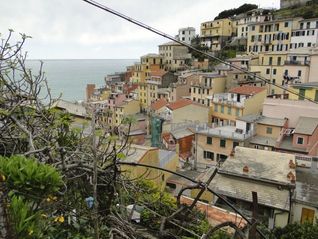 Riomaggiore.
Riomaggiore.
Monday 24 March 2014
Five Lands
Today was an adventure. We went to Cinque Terre. "The Five Lands" comprises five villages: Monterosso al Mare, Vernazza, Corniglia, Manarola, and Riomaggiore. The coastline, the five villages, and the surrounding hillsides are all part of the Cinque Terre National Park and is a UNESCO World Heritage Site.
A kind German camper with a car took us to the station where we attempted, unsuccessfully, to pay for tickets with the automatic machine; there is no ticket office. So, we walked about 300 meters through the village to a Tabac where a man sold us our tickets. Back to the station to validate our tickets in the machines near the entrance.
The train was really good and soon we were bombing through tunnels again to the furthest village Riomaggiore.
Most of the action in Riomaggiore is on the main street, Via Colombo, where there is an assortment of cafes, bars, restaurants, and of course, gelaterie.
The main feature of all the villages is the terracing because the villages are each built in a narrow ravine. That means there are lots of sneaky passages and many, many steps. Riomaggiore was the best place for us because of the extensive, for a village, alleyways and secret corners. It also had a fast food outlet; a local guy selling burgers, sausages and fish and chips. All the food outlets in the other villages were selling pasta or pizza at silly prices.
To return we bought a “40 kilometer ticket”. This allowed us to get on and off at the other four villages as long as we did not take more than six hours.
The busiest village was Manarola. We could not understand why because the village consisted of one main street and expensive eateries.
Five Lands
Today was an adventure. We went to Cinque Terre. "The Five Lands" comprises five villages: Monterosso al Mare, Vernazza, Corniglia, Manarola, and Riomaggiore. The coastline, the five villages, and the surrounding hillsides are all part of the Cinque Terre National Park and is a UNESCO World Heritage Site.
A kind German camper with a car took us to the station where we attempted, unsuccessfully, to pay for tickets with the automatic machine; there is no ticket office. So, we walked about 300 meters through the village to a Tabac where a man sold us our tickets. Back to the station to validate our tickets in the machines near the entrance.
The train was really good and soon we were bombing through tunnels again to the furthest village Riomaggiore.
Most of the action in Riomaggiore is on the main street, Via Colombo, where there is an assortment of cafes, bars, restaurants, and of course, gelaterie.
The main feature of all the villages is the terracing because the villages are each built in a narrow ravine. That means there are lots of sneaky passages and many, many steps. Riomaggiore was the best place for us because of the extensive, for a village, alleyways and secret corners. It also had a fast food outlet; a local guy selling burgers, sausages and fish and chips. All the food outlets in the other villages were selling pasta or pizza at silly prices.
To return we bought a “40 kilometer ticket”. This allowed us to get on and off at the other four villages as long as we did not take more than six hours.
The busiest village was Manarola. We could not understand why because the village consisted of one main street and expensive eateries.
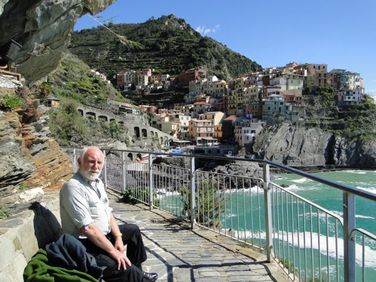 Ian rests in Manarola.
Ian rests in Manarola.
We missed out the village of Corniglia because from the station you have to ascend nearly 400 steps to get to the village. We’d already climbed hundreds of steps and felt that enough was enough.
Having done them all, except Corniglia, we arrived at the station. The campsite lady said we should telephone and she would pick us up in the camp mini-bus. However we had forgotten our mobile. We guessed there would be a telephone at the post office near where we had bought our tickets in the morning. No.
The man in the shop said there was a public phone near the station !
Back we went again and found it but we could not make it accept our money. As we walked back to the station a local bus appeared. The driver told us to go to a Tabac to get our tickets. Off we went again but it was closed. However the bus was still there and the driver sold us a ticket. Why he could not do that in the first place we did not know.
So finally we returned to camp, exhausted with cramping thighs and calf muscles. It was a good day out.
Having done them all, except Corniglia, we arrived at the station. The campsite lady said we should telephone and she would pick us up in the camp mini-bus. However we had forgotten our mobile. We guessed there would be a telephone at the post office near where we had bought our tickets in the morning. No.
The man in the shop said there was a public phone near the station !
Back we went again and found it but we could not make it accept our money. As we walked back to the station a local bus appeared. The driver told us to go to a Tabac to get our tickets. Off we went again but it was closed. However the bus was still there and the driver sold us a ticket. Why he could not do that in the first place we did not know.
So finally we returned to camp, exhausted with cramping thighs and calf muscles. It was a good day out.
Tuesday 25 March 2014
It’s a a gloomy start again and the weather report does not promise much better.
We chatted with a German couple and gave them some advice about the Cinque Terre trip and then we moved on to Lucca using the toll road. If we had used the free roads it would take one hour longer on twisting mountain roads. This way we became like moles again; dashing through tunnel after tunnel.
Lucca looked OK from the main road but we were disappointed at the lack of parking so made our way to LIDL to get some food for our slimming day. Lucca has an interesting looking town centre but having to pay €10 to park a motorhome we moved on to Pisa... off motorway.
We arrived at the large parking for motorhomes in the east of the city. The gateman took our €15 for parking and electricity and showed us to a pitch. There are about 100 pitches. We got the feeling that the place belongs to Pisa’s Motorhome Association and maybe they store the vehicles here and subsidise the cost by charging visitors to park. Maybe wrong.
Anyway we decided that it was too late to start roaming around looking for leaning towers and had a relaxing session.
It’s a a gloomy start again and the weather report does not promise much better.
We chatted with a German couple and gave them some advice about the Cinque Terre trip and then we moved on to Lucca using the toll road. If we had used the free roads it would take one hour longer on twisting mountain roads. This way we became like moles again; dashing through tunnel after tunnel.
Lucca looked OK from the main road but we were disappointed at the lack of parking so made our way to LIDL to get some food for our slimming day. Lucca has an interesting looking town centre but having to pay €10 to park a motorhome we moved on to Pisa... off motorway.
We arrived at the large parking for motorhomes in the east of the city. The gateman took our €15 for parking and electricity and showed us to a pitch. There are about 100 pitches. We got the feeling that the place belongs to Pisa’s Motorhome Association and maybe they store the vehicles here and subsidise the cost by charging visitors to park. Maybe wrong.
Anyway we decided that it was too late to start roaming around looking for leaning towers and had a relaxing session.
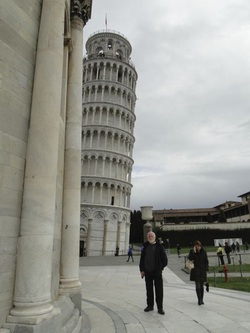 Ian poses at the tower.
Ian poses at the tower.
Wednesday 26 March 2014
It really leans
It is a bit of a treck from the sosta to the city centre (about 2.6 Km) but the old town is really worth visiting. The streets are narrow and there are many narrow passages and alleys. Around every corner there is a new type of architecture to admire. Around noon we came to the tower. Sitting there, from left to right, was the Baptistry, the Duomo and then the Tower. By the way, the tower really does lean at quite an alarming angle.
All three looking magnificent, but the place is very busy with tourists. The Japanese seem to favour plimsolls and face masks.
The Baptistry is quite plain inside but has an interesting islamic floor for some reason. It also has an amazing echo which was demonstrated by the custodian every half hour.
After a good meander and lots of photos we went back into the old town and had a good lunch.
It really leans
It is a bit of a treck from the sosta to the city centre (about 2.6 Km) but the old town is really worth visiting. The streets are narrow and there are many narrow passages and alleys. Around every corner there is a new type of architecture to admire. Around noon we came to the tower. Sitting there, from left to right, was the Baptistry, the Duomo and then the Tower. By the way, the tower really does lean at quite an alarming angle.
All three looking magnificent, but the place is very busy with tourists. The Japanese seem to favour plimsolls and face masks.
The Baptistry is quite plain inside but has an interesting islamic floor for some reason. It also has an amazing echo which was demonstrated by the custodian every half hour.
After a good meander and lots of photos we went back into the old town and had a good lunch.
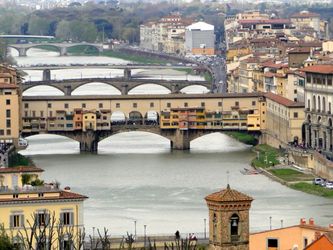 The classic view of Firenze.
The classic view of Firenze.
Thursday 27 March 2014
Art all the way
We said farewell to the nice gatekeeper and went to LIDL for a few groceries before finding the toll-free road to Firenze. Our first view of the enchanting city was from a car park on a hill. Every tourist bus seems to deliver it’s punters to this spot and we had difficulty parking, but the view was worth it.
Nearby was the Michelangelo campsite we needed. It was closed.
Then began a 90 minute drive around Firenza looking for a suitable place to stay. We had coordinates of five more places to stop but they were not to our liking. One was at a large villa on the east of the city but they wanted €26 plus taxes for a scruffy dirt car park. Plus it is up a long rough track which you have to walk down and up for the bus to town. Goodbye.
After roaming around Firenze all this time we gave up and headed for Siena. But on our way we passed a sign for a sosta and dived in.
Apart from a very tight entrance (7.5 meters was VERY tight) we found the place to be OK and there was a bus stop next door. The Number 11 cost us €2 each to the city centre.
Firenza really does have some stunning sites. Simply meandering is enough to satisfy the senses. We walked across the Ponte Vecchio bridge which has jewellers’ shops lining both sides. Only a short walk away is the square with the famous statue of David. Quite amazing, Michelangelo was a talented lad.
Another meander later and we came to the absolutely stunning green and white marble Duomo. The queue to enter was too long as there were as many tourists here as in Pisa.
The Orsanmichele Church was interesting as it started life as a grain store. There are still signs of the chutes for delivering the grain. There is also a very beautiful memorial (almost an altar) built to remind us that a painting on one of the pillars performed 5 miracles.
Another meander back to the Number 11 bus took us along streets lined which shops such as Gucci and other far too expensive shops. Apart from Omega they were all empty, and at prices like €1250 for a simple dress it’s not surprising.
Back at the sosta we enjoyed a nice pot of beef stew. Yummy.
Art all the way
We said farewell to the nice gatekeeper and went to LIDL for a few groceries before finding the toll-free road to Firenze. Our first view of the enchanting city was from a car park on a hill. Every tourist bus seems to deliver it’s punters to this spot and we had difficulty parking, but the view was worth it.
Nearby was the Michelangelo campsite we needed. It was closed.
Then began a 90 minute drive around Firenza looking for a suitable place to stay. We had coordinates of five more places to stop but they were not to our liking. One was at a large villa on the east of the city but they wanted €26 plus taxes for a scruffy dirt car park. Plus it is up a long rough track which you have to walk down and up for the bus to town. Goodbye.
After roaming around Firenze all this time we gave up and headed for Siena. But on our way we passed a sign for a sosta and dived in.
Apart from a very tight entrance (7.5 meters was VERY tight) we found the place to be OK and there was a bus stop next door. The Number 11 cost us €2 each to the city centre.
Firenza really does have some stunning sites. Simply meandering is enough to satisfy the senses. We walked across the Ponte Vecchio bridge which has jewellers’ shops lining both sides. Only a short walk away is the square with the famous statue of David. Quite amazing, Michelangelo was a talented lad.
Another meander later and we came to the absolutely stunning green and white marble Duomo. The queue to enter was too long as there were as many tourists here as in Pisa.
The Orsanmichele Church was interesting as it started life as a grain store. There are still signs of the chutes for delivering the grain. There is also a very beautiful memorial (almost an altar) built to remind us that a painting on one of the pillars performed 5 miracles.
Another meander back to the Number 11 bus took us along streets lined which shops such as Gucci and other far too expensive shops. Apart from Omega they were all empty, and at prices like €1250 for a simple dress it’s not surprising.
Back at the sosta we enjoyed a nice pot of beef stew. Yummy.
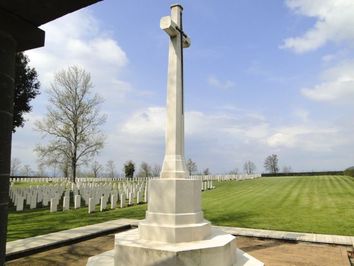 Bolsena CWGC Cemetery.
Bolsena CWGC Cemetery.
Friday 28 March 2014
War Graves
Onward to Siena without paying tolls. Let it be known that this part of Italy has some of the worst maintained roads in Europe. We now put Italy in top place and Belgium second.
At Siena we found a large car park outside the city. The fact that it was a good 2.5 km uphill to the centre and €20 for a motorhome made us look for another sosta. This was just the same but crowded with coaches. By the way coaches have to pay €115 a night.
Siena was not able to benefit from our presence and we drove on. Rome, here we come.
The views of the Tuscan countryside were lovely but again the roads were awful and we were worried about poor Bessy. Passing Lake Bolsena we found a small car park, just big enough for Bessy where there is a CWGC war cemetery. It is in a very lovely setting down a paved path towards the lake.
We finally made it at 15:00 to Happy Village and Camping north of Rome.
War Graves
Onward to Siena without paying tolls. Let it be known that this part of Italy has some of the worst maintained roads in Europe. We now put Italy in top place and Belgium second.
At Siena we found a large car park outside the city. The fact that it was a good 2.5 km uphill to the centre and €20 for a motorhome made us look for another sosta. This was just the same but crowded with coaches. By the way coaches have to pay €115 a night.
Siena was not able to benefit from our presence and we drove on. Rome, here we come.
The views of the Tuscan countryside were lovely but again the roads were awful and we were worried about poor Bessy. Passing Lake Bolsena we found a small car park, just big enough for Bessy where there is a CWGC war cemetery. It is in a very lovely setting down a paved path towards the lake.
We finally made it at 15:00 to Happy Village and Camping north of Rome.
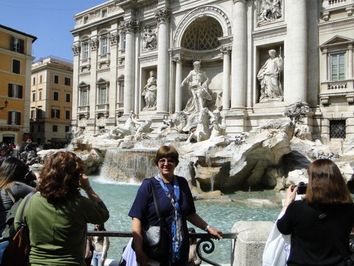 Judit at Trevi Fountain.
Judit at Trevi Fountain.
Saturday 29 March 2014
Roma
Early start today to catch the camp shuttle bus to the station at Prima Porte for the Rome train. All told from the camp to Rome takes one hour. But it’s worth it. Although we walked miles and miles and developed blisters it was wonderful.
First stop was Piazza del Popolo, a lovely square with twin churches and a large Egyptian column and several fountains, just a few meters from the station.
Not far away was the Spanish Steps which we ascended because Judit wanted to find the Museum and Galleria Borghese, but that became difficult so we went back down the steps and took the Metro to the Vatican. The €6 day ticket from Prima Porta covers the Metro as well.
St Peter’s Square is everything that is said about it; very grand and open and crowded. In fact the queue for the Basilica was almost round the whole square so we decided against waiting and walked on to Castel Sant Angelo, across the bridge to Piazza Navove. This is a charming square with fountains and a lovely church. They were having a 24-hour Confession session and we were invited in. Sadly photos not allowed because the church is beautiful inside.
Another stroll and we were at the Pantheon. It really is quite a lump of brick with an amazing dome. Well done you brickies; it’s superb inside.
Not too far away is Piazza Madama with some carefully curved fronted houses opposite the church. Unfortunately there was a funeral so we did not go in.
Onward to Trevi Fountain where the crowds were 30 deep and a hell of a lot of pushing and shoving. But once again, when you can see the fountain you realise why it is so well thought of.
Roma
Early start today to catch the camp shuttle bus to the station at Prima Porte for the Rome train. All told from the camp to Rome takes one hour. But it’s worth it. Although we walked miles and miles and developed blisters it was wonderful.
First stop was Piazza del Popolo, a lovely square with twin churches and a large Egyptian column and several fountains, just a few meters from the station.
Not far away was the Spanish Steps which we ascended because Judit wanted to find the Museum and Galleria Borghese, but that became difficult so we went back down the steps and took the Metro to the Vatican. The €6 day ticket from Prima Porta covers the Metro as well.
St Peter’s Square is everything that is said about it; very grand and open and crowded. In fact the queue for the Basilica was almost round the whole square so we decided against waiting and walked on to Castel Sant Angelo, across the bridge to Piazza Navove. This is a charming square with fountains and a lovely church. They were having a 24-hour Confession session and we were invited in. Sadly photos not allowed because the church is beautiful inside.
Another stroll and we were at the Pantheon. It really is quite a lump of brick with an amazing dome. Well done you brickies; it’s superb inside.
Not too far away is Piazza Madama with some carefully curved fronted houses opposite the church. Unfortunately there was a funeral so we did not go in.
Onward to Trevi Fountain where the crowds were 30 deep and a hell of a lot of pushing and shoving. But once again, when you can see the fountain you realise why it is so well thought of.
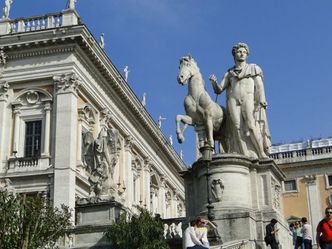 Campidoglio.
Campidoglio.
From there we walked down the Corso and were amazed at the size of the Vittorio Emanuelle II Monument. White marble everywhere.
To the left is the beginning of the ancient part of Rome where we photographed the Traiana Column and surroundings. Quite lovely. Nearby was the Forum and the Palatino.
By this time we were exhausted and dropped into a cafe for a Pizza and Calzone. The price of a pizza is about the same as the UK, but a 1/4 pint of beer costs €5... beware.
After lunch we meandered around the ruins until we came to the Coliseum. It seems they are rebuilding it because there is a lot of scaffolding. Nevertheless it is very imposing.
The nearby Constantine’s Arch is also undergoing renovation. We walked on to Circo Massimo and generally around the ruined area. There are great places for some good photos from that side. By the way, today was the first day we have had real sunshine and blue skies. Not too hot at 22°C.
On again to Campidoglio Square which was designed by Michelangelo. The square is surrounded by beautiful palaces and filled with a magnificent bronze statue and other large marbles.
It was getting near home time so we diverted to Santa Maria Maggiore, but we did not enter; we have paid enough to the church today. We caught the metro at the central station which, was very crowded, to our station. Just as we arrived our train was about to leave. Luckily we caught it and arrived back at Prima Porta in time to catch the camp shuttle bus.
Back at camp it was time for a shower and a couple of cool beers; we had earned them after walking over 16 Km (10 miles).
To the left is the beginning of the ancient part of Rome where we photographed the Traiana Column and surroundings. Quite lovely. Nearby was the Forum and the Palatino.
By this time we were exhausted and dropped into a cafe for a Pizza and Calzone. The price of a pizza is about the same as the UK, but a 1/4 pint of beer costs €5... beware.
After lunch we meandered around the ruins until we came to the Coliseum. It seems they are rebuilding it because there is a lot of scaffolding. Nevertheless it is very imposing.
The nearby Constantine’s Arch is also undergoing renovation. We walked on to Circo Massimo and generally around the ruined area. There are great places for some good photos from that side. By the way, today was the first day we have had real sunshine and blue skies. Not too hot at 22°C.
On again to Campidoglio Square which was designed by Michelangelo. The square is surrounded by beautiful palaces and filled with a magnificent bronze statue and other large marbles.
It was getting near home time so we diverted to Santa Maria Maggiore, but we did not enter; we have paid enough to the church today. We caught the metro at the central station which, was very crowded, to our station. Just as we arrived our train was about to leave. Luckily we caught it and arrived back at Prima Porta in time to catch the camp shuttle bus.
Back at camp it was time for a shower and a couple of cool beers; we had earned them after walking over 16 Km (10 miles).
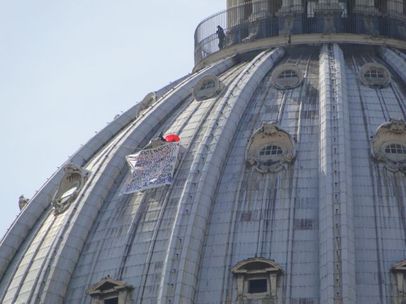 Despite massive security someone managed to make a protest on St Peter's dome.
Despite massive security someone managed to make a protest on St Peter's dome.
Sunday, 30 March 2014
Roma again
We woke early again to catch the 08:30 shuttle. The driver informed us it was now 09:30 as the clocks had been put forward, but he took us to the station anyway.
On the coach was a charming Argentinian family and we had a good long chat about travel and places to visit in the UK.
Today the Vatican Museum is free so we joined the queue. It was a long queue! It took us 1 hour and 40 minutes to reach the front with five minutes to spare before closing. We just made it. The people behind us did not.
The museum is fantastic. We skipped through the Egyptian halls as we’ve been lucky enough to visit Cairo. After that the halls and corridors were beautifully decorated. Through a hall of tapestries and on to the Cartographia Hall. The ceiling is amazing.
Through various halls painted by Rafael. Each one a wonder to behold.
There were some halls with modern art that people just dashed through on the way to the Cistine Chapel. What a crowd. Officially photos are not allowed and we had to be silent because it is a holy place. The custodian was the noisiest shouting though his loudspeaker at people. Once again Michelangelo surpassed himself. To be honest a pair of binoculars are needed to see the detail. It is quite a marvellous site that took only four years to complete.
Very soon we were ushered out because it was closing time. Sad really because the halls leading out were also very beautiful.
While waiting outside the toilets several people came up to Ian and crossed themselves. Ian began to wonder what had happened to him; maybe it was the beard. On looking around he realised the were crossing themselves at a very small image on a distant wall, in line with his head!
We still had time so nipped around the corner and stood in line for St Peters. Today the queue moved quickly and within 40 minutes we were in. Wow!
It’s big… and beautifully decorated. The sun was shining through a window and the sunbeam came down right on top of the altar.
The statues and paintings are excellent. Sadly it is difficult to photograph them because Japanese people pose in front of them.
We just had time to look around the ground floor before we had to dash across town to the station and then to Prima Porta for the shuttle back to camp.
Another wonderful day out.
Roma again
We woke early again to catch the 08:30 shuttle. The driver informed us it was now 09:30 as the clocks had been put forward, but he took us to the station anyway.
On the coach was a charming Argentinian family and we had a good long chat about travel and places to visit in the UK.
Today the Vatican Museum is free so we joined the queue. It was a long queue! It took us 1 hour and 40 minutes to reach the front with five minutes to spare before closing. We just made it. The people behind us did not.
The museum is fantastic. We skipped through the Egyptian halls as we’ve been lucky enough to visit Cairo. After that the halls and corridors were beautifully decorated. Through a hall of tapestries and on to the Cartographia Hall. The ceiling is amazing.
Through various halls painted by Rafael. Each one a wonder to behold.
There were some halls with modern art that people just dashed through on the way to the Cistine Chapel. What a crowd. Officially photos are not allowed and we had to be silent because it is a holy place. The custodian was the noisiest shouting though his loudspeaker at people. Once again Michelangelo surpassed himself. To be honest a pair of binoculars are needed to see the detail. It is quite a marvellous site that took only four years to complete.
Very soon we were ushered out because it was closing time. Sad really because the halls leading out were also very beautiful.
While waiting outside the toilets several people came up to Ian and crossed themselves. Ian began to wonder what had happened to him; maybe it was the beard. On looking around he realised the were crossing themselves at a very small image on a distant wall, in line with his head!
We still had time so nipped around the corner and stood in line for St Peters. Today the queue moved quickly and within 40 minutes we were in. Wow!
It’s big… and beautifully decorated. The sun was shining through a window and the sunbeam came down right on top of the altar.
The statues and paintings are excellent. Sadly it is difficult to photograph them because Japanese people pose in front of them.
We just had time to look around the ground floor before we had to dash across town to the station and then to Prima Porta for the shuttle back to camp.
Another wonderful day out.
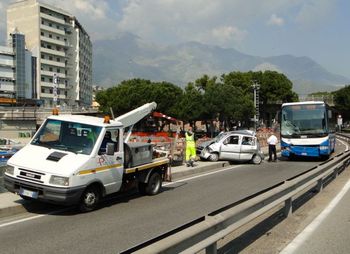 Accident near Naples.
Accident near Naples.
Monday 31 March 2014
Oops!
Another beautiful sunny morning after a cool start. Just a couple of hundred yards from the camp and we were on the motorway that runs around Rome; thank goodness.
South of Rome we left the Italian version of the M25 and drove south past Latina and towards Terracina. This was marked as a sosta but we could not find it. However next to the river mouth is a suitable car park next to a bar.
After a quick lunch there we continued along the coast past Sperlonga. The road was blocked there for a while until the Police cleared the accident. It looked like a coach had stuffed a small car into the wall... nasty.
Just north of Napoli we headed for a Night Stop we found on the internet. We made a mistake at one junction… going left instead of straight on. That led us through some very narrow twisty village roads with rush hour traffic coming the other way. The saying is “See Naples and die.” The modern version is “Drive in Naples and have a nervous breakdown”.
Finally we came to a dirt carpark/lay-by opposite some beach buildings. They were tidying them up for the season. We were 20 meters from the sea but impossible to see for high walls and rattan plants.
But we had a quiet night and it cost nothing
Oops!
Another beautiful sunny morning after a cool start. Just a couple of hundred yards from the camp and we were on the motorway that runs around Rome; thank goodness.
South of Rome we left the Italian version of the M25 and drove south past Latina and towards Terracina. This was marked as a sosta but we could not find it. However next to the river mouth is a suitable car park next to a bar.
After a quick lunch there we continued along the coast past Sperlonga. The road was blocked there for a while until the Police cleared the accident. It looked like a coach had stuffed a small car into the wall... nasty.
Just north of Napoli we headed for a Night Stop we found on the internet. We made a mistake at one junction… going left instead of straight on. That led us through some very narrow twisty village roads with rush hour traffic coming the other way. The saying is “See Naples and die.” The modern version is “Drive in Naples and have a nervous breakdown”.
Finally we came to a dirt carpark/lay-by opposite some beach buildings. They were tidying them up for the season. We were 20 meters from the sea but impossible to see for high walls and rattan plants.
But we had a quiet night and it cost nothing
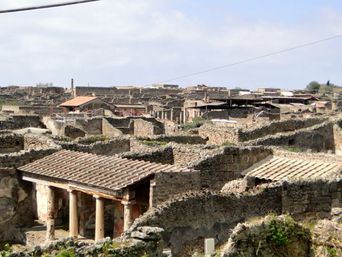 Good overview of Pompei.
Good overview of Pompei.
Tuesday 1 April 2014
Up Pompeii
The return to the motorway was easier in this direction and soon we were heading for the centre of Naples on a toll road. There was no way we were going to drive through the middle. It is clear that toll roads are a waste of time. Soon the traffic was backing up at the toll booths and blocking the road for other users. After a 10 minute wait it was our turn to pay €0.95.
After in a few miles there was another toll booth where we had to pay €2.60. Coming towards us we could see a queue of traffic about one mile long waiting for their turn at the toll booth. The pollution was very clear to see.
After one hour of driving we were at Pompei and straight into Camp Spartacus. The beauty of this site is its position directly opposite the main entrance to Pompei. It could not be more convenient.
After a quick sorting out we put our boots on our Roman blistered feet and “did” Pompei. Built around the 7th Century BC as a port it prospered until Vesuvius popped its cork in 79 AD and buried the city under ash. Now the ash has gone it is a wonderful experience to meander around the fairly well kept ruins of a Roman city.
Just like Athens, there are quite a lot of scaffolding structures but nobody working.
We enjoyed looking at some beautiful houses with paintings and statues, courtyards, shops, sport stadiums and temples, along with private houses, knocking shops and hot baths. It’s quite amazing and worth visiting.
We have been told that nearby Herculaneum is in much better condition and better maintained.
Up Pompeii
The return to the motorway was easier in this direction and soon we were heading for the centre of Naples on a toll road. There was no way we were going to drive through the middle. It is clear that toll roads are a waste of time. Soon the traffic was backing up at the toll booths and blocking the road for other users. After a 10 minute wait it was our turn to pay €0.95.
After in a few miles there was another toll booth where we had to pay €2.60. Coming towards us we could see a queue of traffic about one mile long waiting for their turn at the toll booth. The pollution was very clear to see.
After one hour of driving we were at Pompei and straight into Camp Spartacus. The beauty of this site is its position directly opposite the main entrance to Pompei. It could not be more convenient.
After a quick sorting out we put our boots on our Roman blistered feet and “did” Pompei. Built around the 7th Century BC as a port it prospered until Vesuvius popped its cork in 79 AD and buried the city under ash. Now the ash has gone it is a wonderful experience to meander around the fairly well kept ruins of a Roman city.
Just like Athens, there are quite a lot of scaffolding structures but nobody working.
We enjoyed looking at some beautiful houses with paintings and statues, courtyards, shops, sport stadiums and temples, along with private houses, knocking shops and hot baths. It’s quite amazing and worth visiting.
We have been told that nearby Herculaneum is in much better condition and better maintained.
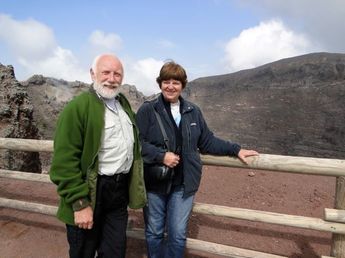 Ian and Judit at Vesuvio crater.
Ian and Judit at Vesuvio crater.
Wednesday 2 April 2014
Not today, please.
Up early, for us, today. We had to catch the 09:20 bus to Vesuvius. It was quite a ride because we used the motorway and then the back roads to get to the bottom of the mountain. Then it was a long slog up twisty narrow roads to the entrance near the top. It’s not narrow for cars but it is for a 45 seater coach.
At one point we stopped and picked up the stranded passengers from a tour bus that had broken down. They were keen to tell us that it was a Chinese bus.
At the final stop we bought our €10 tickets and started the slog up to the rim of the crater. With the thin air and out-of-date legs we were soon puffing like a train. The climb was worth it. The summit is 1,277 m (4,190 ft in real terms) high. We were above the clouds through the gaps we had wonderful views of Naples and surroundings.
The caldera/crater is very deep and thankfully looking peaceful, but here and there can be seen clouds of escaping gases... maybe just steam. It is possible to walk almost the whole way round the crater and thankfully there is a cafe for a coffee.
The walk down took less time but put some stress on old damaged knees. And then we had the coach ride down. These guys do not hang around.
Once back in Pompei we walked the streets looking for Carrefour supermarket. We had walked right past it as the sign was below the fence level... well done.
Not today, please.
Up early, for us, today. We had to catch the 09:20 bus to Vesuvius. It was quite a ride because we used the motorway and then the back roads to get to the bottom of the mountain. Then it was a long slog up twisty narrow roads to the entrance near the top. It’s not narrow for cars but it is for a 45 seater coach.
At one point we stopped and picked up the stranded passengers from a tour bus that had broken down. They were keen to tell us that it was a Chinese bus.
At the final stop we bought our €10 tickets and started the slog up to the rim of the crater. With the thin air and out-of-date legs we were soon puffing like a train. The climb was worth it. The summit is 1,277 m (4,190 ft in real terms) high. We were above the clouds through the gaps we had wonderful views of Naples and surroundings.
The caldera/crater is very deep and thankfully looking peaceful, but here and there can be seen clouds of escaping gases... maybe just steam. It is possible to walk almost the whole way round the crater and thankfully there is a cafe for a coffee.
The walk down took less time but put some stress on old damaged knees. And then we had the coach ride down. These guys do not hang around.
Once back in Pompei we walked the streets looking for Carrefour supermarket. We had walked right past it as the sign was below the fence level... well done.
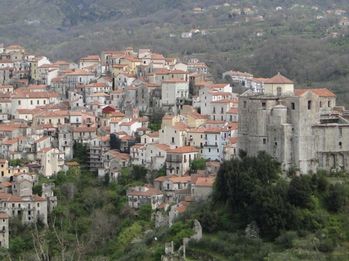 Picturesque town south of Naples.
Picturesque town south of Naples.
Thursday 3 April 2014
During a farewell chat with the staff at the camp they gave us some tips on places to stay in Sicily… Pineta Camp and Marsala.
The toll road out of Naples area is definitely the way to go south. It cost a fairly standard €2.10 and allowed us to zoom past the narrow streets and crazy traffic. It seemed just a short time before we were on non-paying roads which avoided the Amalfi Coast. It may be beautiful but not for the driver as the roads are narrow and winding on cliff edges. Plus we know there are more narrow, busy, chaotic roads to come.
We stopped for lunch in a car park in Praia a Mare. Lunch was salad because it was one of the days on our new 5:2 diet. Not sure if anything is happening but Ian thinks his belt is half-a-notch tighter!
In the car park was another motorhomer called Luigi. He said the car park was a good night stop. He also showed us how to make the street-side water tap work; fumble in the grass for the stop cock.
We thanked Luigi and continued south towards another internet-found Night Stop in the Amantea area. It was nothing more than a patch of dirt bridging the gap where the road ended and another began. Why are the Italian suggested stops so rubbish?
We moved on to the Pizzo area. A narrow road through a wood led to the beach where we found a closed campsite and an open bar/cafe. We shared an espresso with the cafe owner and he said it was OK to stay the night outside.
Today’s journey has taken us through some wonderful scenery. The mountains were snow-capped, the sky dotted with small fluffy clouds and the sea on our right was calm and blue.
Well, it was until about 15:00 when the wind picked up putting white tops on the waves and blowing us around a lot.
During a farewell chat with the staff at the camp they gave us some tips on places to stay in Sicily… Pineta Camp and Marsala.
The toll road out of Naples area is definitely the way to go south. It cost a fairly standard €2.10 and allowed us to zoom past the narrow streets and crazy traffic. It seemed just a short time before we were on non-paying roads which avoided the Amalfi Coast. It may be beautiful but not for the driver as the roads are narrow and winding on cliff edges. Plus we know there are more narrow, busy, chaotic roads to come.
We stopped for lunch in a car park in Praia a Mare. Lunch was salad because it was one of the days on our new 5:2 diet. Not sure if anything is happening but Ian thinks his belt is half-a-notch tighter!
In the car park was another motorhomer called Luigi. He said the car park was a good night stop. He also showed us how to make the street-side water tap work; fumble in the grass for the stop cock.
We thanked Luigi and continued south towards another internet-found Night Stop in the Amantea area. It was nothing more than a patch of dirt bridging the gap where the road ended and another began. Why are the Italian suggested stops so rubbish?
We moved on to the Pizzo area. A narrow road through a wood led to the beach where we found a closed campsite and an open bar/cafe. We shared an espresso with the cafe owner and he said it was OK to stay the night outside.
Today’s journey has taken us through some wonderful scenery. The mountains were snow-capped, the sky dotted with small fluffy clouds and the sea on our right was calm and blue.
Well, it was until about 15:00 when the wind picked up putting white tops on the waves and blowing us around a lot.
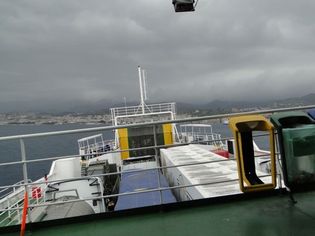 First one way...
First one way...
Friday 4 April 2014
Rocking and rolling
It seems to be taking ages to get to our objective in Sicily so we plodded on towards the ferry. There were lots of road works on the motorway and several junctions were closed. However we soon found very clear signs for the ferry and left the motorway for the port.
It did not look right and a friendly port worker told us that the port in Reggio Calabria was only for commercial traffic, we should go to Villa San Giovanni. This was the place where the junctions had been closed but luckily the were open on the northbound carriageway.
By now the weather was deteriorating with very low cloud hiding all the hills in Sicily and the wind was having a good puff.
It certainly was as we crossed on the ferry because we were soon rolling dramatically about 15° to port and then another 15° to starboard. Plus we were pitching quite a lot as well. Judit stayed on the open deck for the 35 minute crossing.
Rocking and rolling
It seems to be taking ages to get to our objective in Sicily so we plodded on towards the ferry. There were lots of road works on the motorway and several junctions were closed. However we soon found very clear signs for the ferry and left the motorway for the port.
It did not look right and a friendly port worker told us that the port in Reggio Calabria was only for commercial traffic, we should go to Villa San Giovanni. This was the place where the junctions had been closed but luckily the were open on the northbound carriageway.
By now the weather was deteriorating with very low cloud hiding all the hills in Sicily and the wind was having a good puff.
It certainly was as we crossed on the ferry because we were soon rolling dramatically about 15° to port and then another 15° to starboard. Plus we were pitching quite a lot as well. Judit stayed on the open deck for the 35 minute crossing.
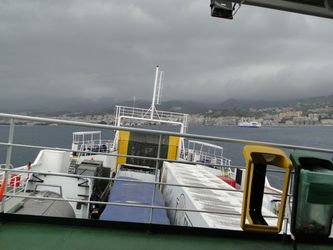 ... then the other.
... then the other.
Messina is not so much a big city as a long city. The traffic on the road south was horrendous with vehicles pushing in from all angles and then scooters nipping through the gaps.
The old saying is, “See Naples and die.” Ian made a new saying, “Drive in Messina and have a nervous breakdown”.
We really should have paid for the toll road because even outside Messina the roads were narrow and congested. The road works could have been better signed. We came to a section that was dug up. The diversion was one car wide, 5 meters up to the right, 10 meters to the left and then another 5 meters left (and all of it 2.5 meters wide) down a steep hill before turning right back onto the road. Bessy is 2.34 meters wide and 7.5 meters long!
At Roccalumera we turned left onto the sea front and found the road much wider and quieter. And enough space to stop for lunch. Ian decided enough was enough and we drove another 8 km to a camp we had visited on our way to Malta some years ago.
At Camp La Focetta Siculo we were welcomed by the young owner, Silvio, and were soon settling down for a rest. By this time the wind was really up and rain in the air. We could have parked next to the sea but the noise was horrendous so we parked well into the camp.
We have decided to stay here for the weekend as the forecast is raining and overcast and quite unpleasant.
The old saying is, “See Naples and die.” Ian made a new saying, “Drive in Messina and have a nervous breakdown”.
We really should have paid for the toll road because even outside Messina the roads were narrow and congested. The road works could have been better signed. We came to a section that was dug up. The diversion was one car wide, 5 meters up to the right, 10 meters to the left and then another 5 meters left (and all of it 2.5 meters wide) down a steep hill before turning right back onto the road. Bessy is 2.34 meters wide and 7.5 meters long!
At Roccalumera we turned left onto the sea front and found the road much wider and quieter. And enough space to stop for lunch. Ian decided enough was enough and we drove another 8 km to a camp we had visited on our way to Malta some years ago.
At Camp La Focetta Siculo we were welcomed by the young owner, Silvio, and were soon settling down for a rest. By this time the wind was really up and rain in the air. We could have parked next to the sea but the noise was horrendous so we parked well into the camp.
We have decided to stay here for the weekend as the forecast is raining and overcast and quite unpleasant.
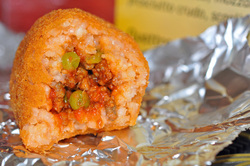 Arancino. Very tasty.
Arancino. Very tasty.
7 April to 12 May 2014
Camp Luminoso is really very smart indeed. Stan, the resident Brit, is very conscientious and is continually repairing and/or maintaining the site.
We met some nice folk at the camp and enjoyed the company of Justine and Lynne, and also Peter and another Lynne.
With a month’s stay planned we also had time for a few repairs such as the Pilot Seat. It needed a few nuts and bolts tightening, the gas cooker auto-ignition had packed up on one burner, the door had become very squeaky, and the Omni-Step was broken (probably thanks to the Turks in Mardin). We must chat up some folks in Hungary and see if they can do a bit of welding for us. Judit also spent a long time giving Bessy a valeting. We hope the use of the cleaning fluids and scouring pads was not too vigorous.
During that period we also helped Peter with a tow-ball problem. It was hanging by a thread and he had to tow a caravan home. Luckily after we had removed the rear bodywork he was able to find a man to weld it back together again. Clearly a Toyota design fault.
Having seen the narrow village, and town, streets we decided to rent a car. Stan took us to Ragusa to pick up a superb Fiat 500. With that we zoomed all over the area. We found Inspector Montalbano’s house and various other sites seen on the TV programme. Old Ragusa is lovely and here we ate our first Arancino. It’s a sort of meaty filling surrounded by rice and breadcrumbs. Very tasty. The other versions are a bit tasteless with “chewing gum” cheese inside.
Camp Luminoso is really very smart indeed. Stan, the resident Brit, is very conscientious and is continually repairing and/or maintaining the site.
We met some nice folk at the camp and enjoyed the company of Justine and Lynne, and also Peter and another Lynne.
With a month’s stay planned we also had time for a few repairs such as the Pilot Seat. It needed a few nuts and bolts tightening, the gas cooker auto-ignition had packed up on one burner, the door had become very squeaky, and the Omni-Step was broken (probably thanks to the Turks in Mardin). We must chat up some folks in Hungary and see if they can do a bit of welding for us. Judit also spent a long time giving Bessy a valeting. We hope the use of the cleaning fluids and scouring pads was not too vigorous.
During that period we also helped Peter with a tow-ball problem. It was hanging by a thread and he had to tow a caravan home. Luckily after we had removed the rear bodywork he was able to find a man to weld it back together again. Clearly a Toyota design fault.
Having seen the narrow village, and town, streets we decided to rent a car. Stan took us to Ragusa to pick up a superb Fiat 500. With that we zoomed all over the area. We found Inspector Montalbano’s house and various other sites seen on the TV programme. Old Ragusa is lovely and here we ate our first Arancino. It’s a sort of meaty filling surrounded by rice and breadcrumbs. Very tasty. The other versions are a bit tasteless with “chewing gum” cheese inside.
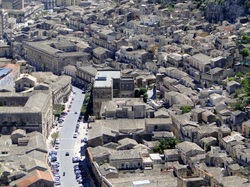 Modica from the top.
Modica from the top.
At Easter we did the Hungarian thing and hid Easter eggs for each other to find. We even went so far as to paint our own eggs.
With the car we visited Donnafugata which is an old house with gardens in a lovely setting. Spoilt a bit by the heavy rain and high winds.
Probably the best run out was to the Roman Villa at Piazza Armerina. Once off the main road the signs could have been better but we eventually found the place. It really is superb. The villa had been covered by mud from the local river for centuries before being discovered and cleaned up. Clearly the walls are not too high and there was no roof, other than the modern one, but the layout and mosaics are outstanding. This is a must-see place.
Another highlight was a visit to Modica where we climbed step after step through the back streets of the town before being rewarded with wonderful views over the valley and the street plan below.
Modica is famous for chocolate in the original form in that it is quite rough textured, but still tasty.
With the car we visited Donnafugata which is an old house with gardens in a lovely setting. Spoilt a bit by the heavy rain and high winds.
Probably the best run out was to the Roman Villa at Piazza Armerina. Once off the main road the signs could have been better but we eventually found the place. It really is superb. The villa had been covered by mud from the local river for centuries before being discovered and cleaned up. Clearly the walls are not too high and there was no roof, other than the modern one, but the layout and mosaics are outstanding. This is a must-see place.
Another highlight was a visit to Modica where we climbed step after step through the back streets of the town before being rewarded with wonderful views over the valley and the street plan below.
Modica is famous for chocolate in the original form in that it is quite rough textured, but still tasty.
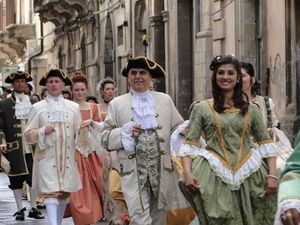 Baroque walking in Noto.
Baroque walking in Noto.
Our longest run out was to Siracusa to see more ancient Greek ruins. It was a little disappointing because the amphitheatre had been boarded over and a stage was being built for some sort of event. People paid a lot of money to see the amphitheatre. The nearby quarry was the highlight of the site complete with a very large cave belonging to one ancient God or another.
Leaving the Greek site we drove through the mad traffic to the old town. It is very pleasant indeed with a beautiful cathedral and attractive back streets.
On our return journey we stopped at Noto which is a baroque town. The architecture is stunning. That alone is a good reason to visit. However while meandering through the streets we heard the deep thud of drums. To our surprise the locals were holding a festival. The best explanation was “a Baroque walk”, whatever that meant.
A procession of people dressed in “Baroque” clothing stretched for a good kilometer through the town. In various places were groups of flag tossers and drummers. It was all very spectacular and we watched it until the speeches started before heading back to Luminoso.
Leaving the Greek site we drove through the mad traffic to the old town. It is very pleasant indeed with a beautiful cathedral and attractive back streets.
On our return journey we stopped at Noto which is a baroque town. The architecture is stunning. That alone is a good reason to visit. However while meandering through the streets we heard the deep thud of drums. To our surprise the locals were holding a festival. The best explanation was “a Baroque walk”, whatever that meant.
A procession of people dressed in “Baroque” clothing stretched for a good kilometer through the town. In various places were groups of flag tossers and drummers. It was all very spectacular and we watched it until the speeches started before heading back to Luminoso.
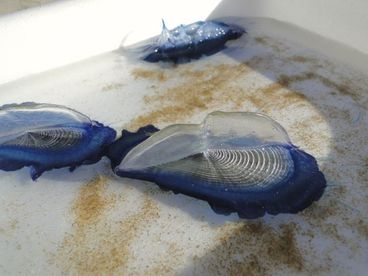 By the wind sailor or Velella velella.
By the wind sailor or Velella velella.
The car was returned after one week and we relaxed in the camp area. During our stay the weather has been sunny but windy. The wind and waves would bring a certain jellyfish onto the beach. Not a few, but thousands and thousands. They are beautiful little creatures with a lovely deep blue “skirt”.
We eventually found that they are called Velella velella. The common names are sea raft, by-the-wind sailor, purple sail, little sail, or simply Velella. Most are less than about 7 cm long. They are usually deep blue in colour, but their most obvious feature is a small stiff sail that catches the wind and propels them over the surface of the sea.
Velella velella are carnivorous. They catch their prey, generally plankton, by means of tentacles that hang down in the water. Though the toxins are effective against their prey,Velella is harmless to humans with a sting that is almost non-existent.
We eventually found that they are called Velella velella. The common names are sea raft, by-the-wind sailor, purple sail, little sail, or simply Velella. Most are less than about 7 cm long. They are usually deep blue in colour, but their most obvious feature is a small stiff sail that catches the wind and propels them over the surface of the sea.
Velella velella are carnivorous. They catch their prey, generally plankton, by means of tentacles that hang down in the water. Though the toxins are effective against their prey,Velella is harmless to humans with a sting that is almost non-existent.
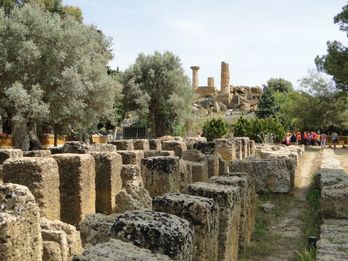 Valley of the Temples.
Valley of the Temples.
Monday 12 May 2014
We said our farewells to Peter, Lynne and Stan of course. We really can recommend Camp Luminoso.
First stop was the Conad supermarket because there is an ATM in the entrance and then off to the Valley of the Temples. It was a 90 minute drive. One problem with Italian roads is the excess of crash barriers. There is nowhere to pull off for a quick cuppa.
Strangely the Valley of the Temples is on a hill. Work that one out. The beautiful archeological site is split down the middle by a main road and we had trouble finding a car park. Eventually we got there and found that it costs €5 a day for motorhomes and €3 for cars. But it has toilets and is next to the entrance to the western part of the site. There are two temples here and a mock up of a statue of Hercules. Next to Hercules is Hardcastle Gate. We know that Earnshaw is the Great Yorkshire God; was Hardcastle a Great Greek God?
It later transpired after we crossed the road and entered the eastern part of the site that Alexander Hardcastle was an English Army Captain who retired to the area and, in brief, rescued the site from ruination before the Italians knocked it all down and used the stone for building a harbour somewhere. Well done Hardcastle. He did a great job and the site is a “must see” as far as we are concerned.
Apart from three lovely temples we saw a wonderful moment when a party of junior school children spotted a bronze statue of Icarus. The young boys could not believe the size of his willy and they all crowded round to give it a good polishing. Of course the young girls stood well back and kept very quiet.
The car park made a good Night Stop and in the morning we paid our €10... but the site entrance had been free.
We said our farewells to Peter, Lynne and Stan of course. We really can recommend Camp Luminoso.
First stop was the Conad supermarket because there is an ATM in the entrance and then off to the Valley of the Temples. It was a 90 minute drive. One problem with Italian roads is the excess of crash barriers. There is nowhere to pull off for a quick cuppa.
Strangely the Valley of the Temples is on a hill. Work that one out. The beautiful archeological site is split down the middle by a main road and we had trouble finding a car park. Eventually we got there and found that it costs €5 a day for motorhomes and €3 for cars. But it has toilets and is next to the entrance to the western part of the site. There are two temples here and a mock up of a statue of Hercules. Next to Hercules is Hardcastle Gate. We know that Earnshaw is the Great Yorkshire God; was Hardcastle a Great Greek God?
It later transpired after we crossed the road and entered the eastern part of the site that Alexander Hardcastle was an English Army Captain who retired to the area and, in brief, rescued the site from ruination before the Italians knocked it all down and used the stone for building a harbour somewhere. Well done Hardcastle. He did a great job and the site is a “must see” as far as we are concerned.
Apart from three lovely temples we saw a wonderful moment when a party of junior school children spotted a bronze statue of Icarus. The young boys could not believe the size of his willy and they all crowded round to give it a good polishing. Of course the young girls stood well back and kept very quiet.
The car park made a good Night Stop and in the morning we paid our €10... but the site entrance had been free.
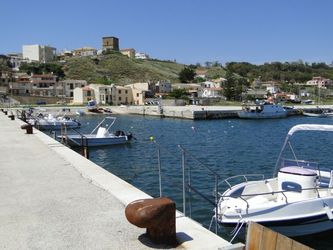 Porto Palo.
Porto Palo.
Tuesday 13 May 2014
Today we went to see Eric Lea or Ericlea as the Italians call it. It’s a small Greek ruined town complete with amphitheatre. It’s fairly interesting but not impressive The stone seats of the amphitheatre are very worn away and it is now covered with scaffolding. But if you are over 65 the entrance is free. Judit and I must look very young because we always have to show our passports to prove that we are old and crumbly. On the road out we met a Swiss Motorhomer and he told us not to bother going down to the sea front because it is one big campsite that charges €20 a night with a minimum of three nights. Instead we headed for Porto Palo. On the way we saw brown “tourist” signs for a thermal something or other. As soon as we left the main road the signs vanished and we found ourselves in the town of Secca Grande complete with narrow crowded streets. Italian drivers are bad and the parking is worse... enough said.
Porto Palo is a small untidy village on the coast but it has a big harbour with acres of flat concrete. But someone on the local council doesn’t like motorhomers as there are signs everywhere forbidding motorhome parking. We moved along the beach and found a bit of bare earth next to a “No Motorhome” road and bedded down there.
While sitting outside we were chatted up by a German couple. The husband clearly loves the EU but hates the Greeks because they do not like Angela Merkel. They come from Munich!
Just a few hundred meters away is Vittorio Restaurant featured on the BBC programme “Sicily Unpacked”. It may be good but their website makes it look very expensive so we ate corned beef instead. Yummy.
Today we went to see Eric Lea or Ericlea as the Italians call it. It’s a small Greek ruined town complete with amphitheatre. It’s fairly interesting but not impressive The stone seats of the amphitheatre are very worn away and it is now covered with scaffolding. But if you are over 65 the entrance is free. Judit and I must look very young because we always have to show our passports to prove that we are old and crumbly. On the road out we met a Swiss Motorhomer and he told us not to bother going down to the sea front because it is one big campsite that charges €20 a night with a minimum of three nights. Instead we headed for Porto Palo. On the way we saw brown “tourist” signs for a thermal something or other. As soon as we left the main road the signs vanished and we found ourselves in the town of Secca Grande complete with narrow crowded streets. Italian drivers are bad and the parking is worse... enough said.
Porto Palo is a small untidy village on the coast but it has a big harbour with acres of flat concrete. But someone on the local council doesn’t like motorhomers as there are signs everywhere forbidding motorhome parking. We moved along the beach and found a bit of bare earth next to a “No Motorhome” road and bedded down there.
While sitting outside we were chatted up by a German couple. The husband clearly loves the EU but hates the Greeks because they do not like Angela Merkel. They come from Munich!
Just a few hundred meters away is Vittorio Restaurant featured on the BBC programme “Sicily Unpacked”. It may be good but their website makes it look very expensive so we ate corned beef instead. Yummy.
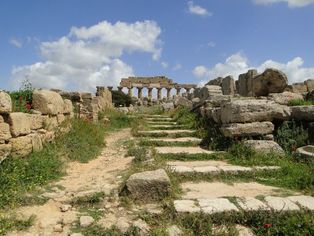 Selinunte.
Selinunte.
Wednesday 14 May 2014
Selinunte is an ancient Greek city only a few miles from our Night Stop at Porto Palo. The site covers 270 hectares (about one square mile) which is three times larger than the site at Paestum. In total there are seven temples. Temples E is the most impressive and has been partially rebuilt. The exciting thing is you can actually walk inside the temple, unlike anywhere else we’ve been.
Today’s high winds are a blessing because it kept us cool during the long walks around the site. It really is worth spending some time here and it was late afternoon before we found a quiet spot in the village of Tre Fontane. It’s a small car park and here we met a German motorhomer called Peter. He advised us where not to park because sometimes a “market van” has a favoured spot. From here we have a wonderful view of the massive flat beach and can look back along the coast to places we’ve visited.
Later in the day we were pestered by an illegal immigrant. From his sign language it was clear that he came from across the sea from North Africa. When these people arrive in Italy they must finally realise what a gigantic mistake they have made. They are not welcomed at all.
Europe should be making videos of these people and showing the the people in Africa the truth of what can be expected if they arrive here.
Selinunte is an ancient Greek city only a few miles from our Night Stop at Porto Palo. The site covers 270 hectares (about one square mile) which is three times larger than the site at Paestum. In total there are seven temples. Temples E is the most impressive and has been partially rebuilt. The exciting thing is you can actually walk inside the temple, unlike anywhere else we’ve been.
Today’s high winds are a blessing because it kept us cool during the long walks around the site. It really is worth spending some time here and it was late afternoon before we found a quiet spot in the village of Tre Fontane. It’s a small car park and here we met a German motorhomer called Peter. He advised us where not to park because sometimes a “market van” has a favoured spot. From here we have a wonderful view of the massive flat beach and can look back along the coast to places we’ve visited.
Later in the day we were pestered by an illegal immigrant. From his sign language it was clear that he came from across the sea from North Africa. When these people arrive in Italy they must finally realise what a gigantic mistake they have made. They are not welcomed at all.
Europe should be making videos of these people and showing the the people in Africa the truth of what can be expected if they arrive here.
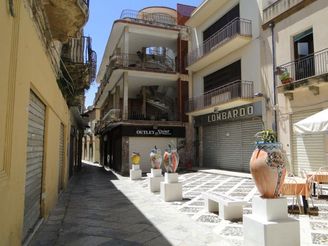 Back street in Mazara.
Back street in Mazara.
Tuesday 15 May 2014
As a follow-on from Selinunte we left Tre Fontane and drove just a few kilometers to the quarry where the stone was extracted for Selinunte. To be honest, it’s not that exciting but there are one or two examples of how the large cylinders were extracted for making the columns of the temples. It must have been very hard work carving them out in cylindrical form with just hammer and chisel.
Today is one of our diet days (5:2 diet) so we called in LIDL again for some ingredients. Tonight is Mexican Potato Bake and it is delicious and filling.
In case anyone is interested I have moved my belt one notch. Not a lot, but every little helps.
Finally we have found olive groves along the road to Mazara del Vallo. It’s not far and quite pleasant. When we arrived at our target, the harbour, we could not miss the fairground. Plus quite a lot of Tunisians drinking beer... bad boy muslims. Then we had to cope with a few down-and-outs trying to make us pay for a parking ticket. They did have tickets but they looked more like raffle tickets so were told to bugger off.
We locked up and left Bessy while we had a short walk around town. The harbour is quite interesting with some shipbuilding going on, but the back alleys were more interesting with large flat cobbles and a lot of tiles on the walls. They looked like images of local history. One feature was a part destroyed church but there were no notices explaining why.
We did find out why our mobile will only work on emergency calls. It appears that Orange do not have a presence in Italy.
Back at the harbour we decided to move on to a quieter small car park near the brand new promenade. We didn’t fancy listening to the fairground all night. However after 17:00 our little car park was throbbing with cars and people. It looks like people park here and either go for a “power walk” along the new promenade or go to a bar across the road.
The whole beach area is littered with broken bottles, empty tomato cans and old nappies. We saw one guy drinking a beer in his parked car. Then the window opened and he lobbed his bottle out before driving off. Civilization. Hopefully it will be quieter later.
As a follow-on from Selinunte we left Tre Fontane and drove just a few kilometers to the quarry where the stone was extracted for Selinunte. To be honest, it’s not that exciting but there are one or two examples of how the large cylinders were extracted for making the columns of the temples. It must have been very hard work carving them out in cylindrical form with just hammer and chisel.
Today is one of our diet days (5:2 diet) so we called in LIDL again for some ingredients. Tonight is Mexican Potato Bake and it is delicious and filling.
In case anyone is interested I have moved my belt one notch. Not a lot, but every little helps.
Finally we have found olive groves along the road to Mazara del Vallo. It’s not far and quite pleasant. When we arrived at our target, the harbour, we could not miss the fairground. Plus quite a lot of Tunisians drinking beer... bad boy muslims. Then we had to cope with a few down-and-outs trying to make us pay for a parking ticket. They did have tickets but they looked more like raffle tickets so were told to bugger off.
We locked up and left Bessy while we had a short walk around town. The harbour is quite interesting with some shipbuilding going on, but the back alleys were more interesting with large flat cobbles and a lot of tiles on the walls. They looked like images of local history. One feature was a part destroyed church but there were no notices explaining why.
We did find out why our mobile will only work on emergency calls. It appears that Orange do not have a presence in Italy.
Back at the harbour we decided to move on to a quieter small car park near the brand new promenade. We didn’t fancy listening to the fairground all night. However after 17:00 our little car park was throbbing with cars and people. It looks like people park here and either go for a “power walk” along the new promenade or go to a bar across the road.
The whole beach area is littered with broken bottles, empty tomato cans and old nappies. We saw one guy drinking a beer in his parked car. Then the window opened and he lobbed his bottle out before driving off. Civilization. Hopefully it will be quieter later.
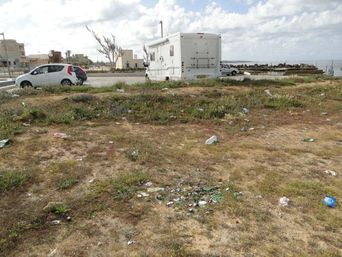 Some of the rubbish in Mazara.
Some of the rubbish in Mazara.
Friday 16 May 2014
Wrong. It did not quieten down until after 02:00. We had two cars parked alongside playing dunga-dunga music and doing Italian talking. In other words all shouting at once to each other. Then one guy thought he would wake us up by rocking Bessy. He was suitably surprised when my window blind shot down and I gave him a withering look.
Just two hours later a thunder storm started and we were pelted with hail for about an hour. It’s no wonder that I had no qualms about emptying the cassette down a drain.
At least there was a tap just a few yards away. People had been drinking from it so we guessed it was OK to top up our tank.
Even in the morning people were jogging or power walking on the promenade and the bar was doing good business selling thimbles full of espresso.
We planned to follow Lonely Planet’s guide and find a Marsala wine place along the road to Marsala. Lots to choose from with the promise of a tour and a tasting. Wrong again. We saw none, zero, zilch. Just a miserable ribbon development all the way to Marsala where we had to cope with more atrocious driving and parking to find the road to Erice.
Ian has decided that we have been in enough towns in Sicily. We will visit Palermo and that’s it; no more feeling like you are a lone B-17 bomber over Germany.
Wrong. It did not quieten down until after 02:00. We had two cars parked alongside playing dunga-dunga music and doing Italian talking. In other words all shouting at once to each other. Then one guy thought he would wake us up by rocking Bessy. He was suitably surprised when my window blind shot down and I gave him a withering look.
Just two hours later a thunder storm started and we were pelted with hail for about an hour. It’s no wonder that I had no qualms about emptying the cassette down a drain.
At least there was a tap just a few yards away. People had been drinking from it so we guessed it was OK to top up our tank.
Even in the morning people were jogging or power walking on the promenade and the bar was doing good business selling thimbles full of espresso.
We planned to follow Lonely Planet’s guide and find a Marsala wine place along the road to Marsala. Lots to choose from with the promise of a tour and a tasting. Wrong again. We saw none, zero, zilch. Just a miserable ribbon development all the way to Marsala where we had to cope with more atrocious driving and parking to find the road to Erice.
Ian has decided that we have been in enough towns in Sicily. We will visit Palermo and that’s it; no more feeling like you are a lone B-17 bomber over Germany.
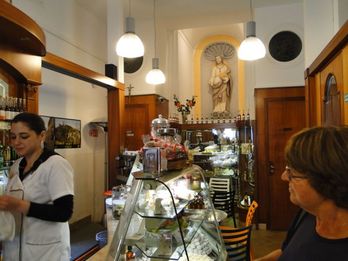 Cake shop in Erice.
Cake shop in Erice.
Once we left Marsala we could see Erice on top of the 750 meter mountain (2,460 ft), but first we wanted to see Whitaker’s Island. He was another Englishman who built a museum on the small island along with beautiful gardens full of tastefully placed archeological artifacts. The car park is also said to be a good Night Stop. However when we got there the dirt car park was packed solid with tourist coaches. It was so packed it is hard to imagine how they managed to get out; so we didn’t go in. We parked just a few hundred yards along on a dirt lay-by. Just as we were pondering what to do we were hit by another massive thunderstorm and being pelted by hailstones the size of marbles. After an hour it stopped and we decided to move on before getting bogged down in the mud. To reach Erice the road winds steeply up the mountain but only 9 hairpin bends with dramatic views over the surrounding countryside.
Luckily we found a good parking area alongside five other motorhomes near one of the city gates. After a lunch we went to explore.
The town is a medieval tangle of streets and cobbled piazzas. It has a history of worshipping the cult of Venus It is certainly quaint but the centre is full of shops selling things you never wanted. We did, however, buy some cakes in a bakers... complete with a life size statue of St John inside. The locals claim that on a clear day it is possible to see Tunisia from the town. The distance to the Tunisian shore is about 175 Km. However from a height above sea level of 1000 meters it is only possible to see 160 Km. Another local myth destroyed.
The only disturbance we had in the night was a wedding party driving to the gate to take a few photos and then peace at last.
Luckily we found a good parking area alongside five other motorhomes near one of the city gates. After a lunch we went to explore.
The town is a medieval tangle of streets and cobbled piazzas. It has a history of worshipping the cult of Venus It is certainly quaint but the centre is full of shops selling things you never wanted. We did, however, buy some cakes in a bakers... complete with a life size statue of St John inside. The locals claim that on a clear day it is possible to see Tunisia from the town. The distance to the Tunisian shore is about 175 Km. However from a height above sea level of 1000 meters it is only possible to see 160 Km. Another local myth destroyed.
The only disturbance we had in the night was a wedding party driving to the gate to take a few photos and then peace at last.
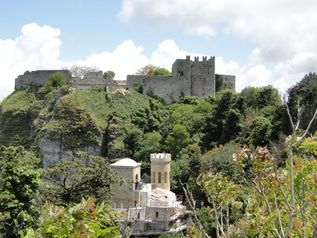 A view in Erice.
A view in Erice.
Saturday 17 May 2014
Early in the morning after a very peaceful night we were surprised to see that we were actually above the few clouds that were around. The drive down was just as spectacular as the upward run. First job was to find a supermarket and here the Garmin let us down. There was no supermarket or anything remotely like one. We headed north again and this time we looked for LPG (or GPL as they call it in Italy). Once again no luck but we did find another “Famila” supermarket that had some nice looking liver. The road north towards San Vito Lo Capo was lovely as there were now some real mountains and hills to look at. We’d spent a month in the south surrounded by poly-tunnels in what should have been called “Polythenia” as Magbaz called it.
Soon we were at Camp La Pineta, which means “The Pines”. We were advised to visit here by the man at Camp Spartacus in Pompei. He was not wrong as it is a very pleasant place with lots of shade, situated at the foot of a magnificent cliff face of Mount Monaco. Very nice indeed.
We spent the rest of the day cleaning up and washing, plus sorting out a backlog of emails while sitting in the bar... the only place with internet. However it was reasonably fast and we managed one SKYPE to Charlotte but no answer from Richard.
Dinner was lovely, delicious Hungarian liver. and Dauphinoise potatoes.
Early in the morning after a very peaceful night we were surprised to see that we were actually above the few clouds that were around. The drive down was just as spectacular as the upward run. First job was to find a supermarket and here the Garmin let us down. There was no supermarket or anything remotely like one. We headed north again and this time we looked for LPG (or GPL as they call it in Italy). Once again no luck but we did find another “Famila” supermarket that had some nice looking liver. The road north towards San Vito Lo Capo was lovely as there were now some real mountains and hills to look at. We’d spent a month in the south surrounded by poly-tunnels in what should have been called “Polythenia” as Magbaz called it.
Soon we were at Camp La Pineta, which means “The Pines”. We were advised to visit here by the man at Camp Spartacus in Pompei. He was not wrong as it is a very pleasant place with lots of shade, situated at the foot of a magnificent cliff face of Mount Monaco. Very nice indeed.
We spent the rest of the day cleaning up and washing, plus sorting out a backlog of emails while sitting in the bar... the only place with internet. However it was reasonably fast and we managed one SKYPE to Charlotte but no answer from Richard.
Dinner was lovely, delicious Hungarian liver. and Dauphinoise potatoes.
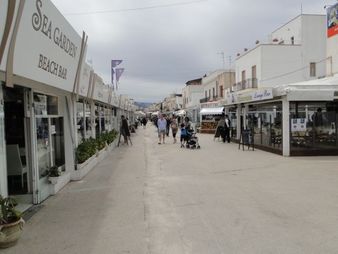 San Vito lo Capo.
San Vito lo Capo.
Sunday 18 May 2014
Once again we had a really peaceful night and woke up at 09-45 !
After breakfast we donned our boots and went for a walk around the town. It’s not far but we walked non-stop for two hours. The town is quite touristy and has a lovely beach. There are lots of restaurants but they are not cheap. For example a starter of King Prawn Cocktail was €18. King Prawn cooked in oil, lemon, salt, pepper and parsley was €25. A portion of chips came to €3.50. The Tourist Menu looked more hopeful but Mussel soup, Cous Cous with fish, and grilled sausages was €15.
Back to camp for a good old fashioned fry-up... it is Sunday after all.
In the afternoon we tried to call Pat on SKYPE but it broke up all the time so we emailed her son Matthew. Hopefully the message will get through.
Evening meal should be OK as well because Judit is baking some large spuds and we found and some meat on sticks. It smells good.
Interestingly we can find a dozen different types of tomato but only one sort of potato which is like a large “new potato”. The range of pasta in the shops is amazing when you think it is basically flour and water. Alongside the pasta is another long set of shelves of tinned tomato. It may be heretical to say it but I think we have a better variety of food in England. There is only one sort of food available in Italy and that’s Italian... no Chinese, no Indian, no Moroccan, no English, no Hungarian, just pasta and tomatoes. On the coast there is fish but it is damned expensive and not a patch on a good serving of Scarborough Woof in Whitby. In tourist areas you can find pizza everywhere but a good homemade one is better. There seems to be some sort of campaign in the UK to sell us Italian food as if it is better than anything we make at home. It’s not true.
Once again we had a really peaceful night and woke up at 09-45 !
After breakfast we donned our boots and went for a walk around the town. It’s not far but we walked non-stop for two hours. The town is quite touristy and has a lovely beach. There are lots of restaurants but they are not cheap. For example a starter of King Prawn Cocktail was €18. King Prawn cooked in oil, lemon, salt, pepper and parsley was €25. A portion of chips came to €3.50. The Tourist Menu looked more hopeful but Mussel soup, Cous Cous with fish, and grilled sausages was €15.
Back to camp for a good old fashioned fry-up... it is Sunday after all.
In the afternoon we tried to call Pat on SKYPE but it broke up all the time so we emailed her son Matthew. Hopefully the message will get through.
Evening meal should be OK as well because Judit is baking some large spuds and we found and some meat on sticks. It smells good.
Interestingly we can find a dozen different types of tomato but only one sort of potato which is like a large “new potato”. The range of pasta in the shops is amazing when you think it is basically flour and water. Alongside the pasta is another long set of shelves of tinned tomato. It may be heretical to say it but I think we have a better variety of food in England. There is only one sort of food available in Italy and that’s Italian... no Chinese, no Indian, no Moroccan, no English, no Hungarian, just pasta and tomatoes. On the coast there is fish but it is damned expensive and not a patch on a good serving of Scarborough Woof in Whitby. In tourist areas you can find pizza everywhere but a good homemade one is better. There seems to be some sort of campaign in the UK to sell us Italian food as if it is better than anything we make at home. It’s not true.
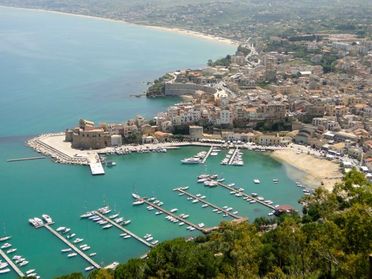 Castellammare.
Castellammare.
Tuesday 20 May 2014
After a lazy start, emptying, dumping and filling, we went to the southern entrance of the Zingaro Nature Reserve. The route took us past some lovely coves and secluded beaches but the road surface was bad. We have seen collapsed roads before and these were just hanging on by their finger tips. Anyway, when we got there the car park was packed solid. There was no option but to turn around and retrace our steps.
So we pointed towards Segesta where there are some ancient Greek ruins... yes, more Greek ruins! On the way there we stopped at a purpose built lay-by which is a good view point over Castellammare. It’s probably the first “viewpoint” we’ve found in Sicily and it really is lovely. One of our friends said they used the harbour side as a Night Stop but we could not recognise the way in.
A plus point was the mobile canteen selling delicious filled rolls and chips. We are on the 5 part of the diet some chips were essential. We also bought a €2 portion of Stigghiola which is goat intestines filled with onion cheese and parsley. It had the texture of squid and a delicious flavour... honest.
As we were approaching the ruins our SatNav lady, called Jane, told us to go left but the sign was for straight ahead. We should have listened to Jane as the road was collapsing and in some places nonexistent. We got there and then scraped our back end in the bumpy dirt car park.
Segesta ruins are OK. There is a 36-column temple that is showing its age and at the top of a long hill is the amphitheatre. As we had our usual free entry we took the 10 minute bus ride to the top for €1.50. It was worth it. The amphitheatre is quite small but the views of the surrounding countryside are excellent... vineyards, wheat, quarries, forests and the sea in the distance.
Ian asked the dishy maiden in the Information shed if it was possible to sleep in the car park. The answer was “No” but we could drive 5 km to Calatafimi-Segesta where there is a free sosta. As well as having the most beautiful eyes in Sicily, she was correct. It’s not much of a place as it is surrounded by giant walls and flats but it’s clean and has a dump and water.
After a lazy start, emptying, dumping and filling, we went to the southern entrance of the Zingaro Nature Reserve. The route took us past some lovely coves and secluded beaches but the road surface was bad. We have seen collapsed roads before and these were just hanging on by their finger tips. Anyway, when we got there the car park was packed solid. There was no option but to turn around and retrace our steps.
So we pointed towards Segesta where there are some ancient Greek ruins... yes, more Greek ruins! On the way there we stopped at a purpose built lay-by which is a good view point over Castellammare. It’s probably the first “viewpoint” we’ve found in Sicily and it really is lovely. One of our friends said they used the harbour side as a Night Stop but we could not recognise the way in.
A plus point was the mobile canteen selling delicious filled rolls and chips. We are on the 5 part of the diet some chips were essential. We also bought a €2 portion of Stigghiola which is goat intestines filled with onion cheese and parsley. It had the texture of squid and a delicious flavour... honest.
As we were approaching the ruins our SatNav lady, called Jane, told us to go left but the sign was for straight ahead. We should have listened to Jane as the road was collapsing and in some places nonexistent. We got there and then scraped our back end in the bumpy dirt car park.
Segesta ruins are OK. There is a 36-column temple that is showing its age and at the top of a long hill is the amphitheatre. As we had our usual free entry we took the 10 minute bus ride to the top for €1.50. It was worth it. The amphitheatre is quite small but the views of the surrounding countryside are excellent... vineyards, wheat, quarries, forests and the sea in the distance.
Ian asked the dishy maiden in the Information shed if it was possible to sleep in the car park. The answer was “No” but we could drive 5 km to Calatafimi-Segesta where there is a free sosta. As well as having the most beautiful eyes in Sicily, she was correct. It’s not much of a place as it is surrounded by giant walls and flats but it’s clean and has a dump and water.
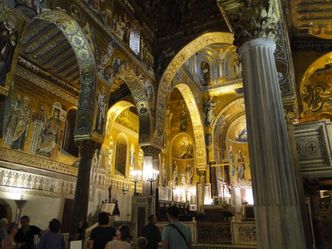 Church in the Royal Palace.
Church in the Royal Palace.
Wednesday 21 May 2014
Although our surroundings were not very beautiful we did have a very peaceful night. Even the dustbin men were quiet at 07:30.
Almost next door to the sosta is a Conad supermarket. In reality a sort of TESCO Express so the choice was limited and the prices seemed higher than in the big shops. By the way, they had no whisky!
Only 500 meters away was an ERG filling station where we topped up. The young man serving was ever so keen for us to visit the area and went to a lot of trouble, drawing maps and so on, to direct us to various beauty spots.
But the plan was to sort out Palermo and put big cities behind us for the rest of the trip. The whole run was rather lovely. Even our paper map had the route marked as picturesque on the motorway. Even better there was no toll.
Italy is famous for bad driving and Palermo has a bad reputation among the locals, so it was sobering to see two motorcyclist splattered across the opposite carriageway with police and ambulance in attention.
Although the road into Palermo was chaotic we arrived at the right car park with no problem. Well, just a little one because some prat had parked his car halfway across the entrance. A little bit of wiggling and we were in. The attendant, Raymondo, was very keen and helpful and soon had us parked nicely out of the way. The fee is €20 a night and includes, water (non-drinking), a dump, electricity and free wifi. We are about 500 meters from the city centre so what more could you ask. In fact the wifi is the best we’ve experienced in Italy; so well done Palermo.
After a triple decker sandwich experiment (which we will not repeat) we walked into town. Crossing roads is quite exciting. First stop was the Royal Palace. Normal price is €14 but because we are old we only paid €5. But if we had been a student aged 18 it would have been free. Oh well.
The main attraction was the magnificently decorated church. It really is a gem with gold all over the place. Downstairs was an exhibition but we would have had to pay extra for that so we went down into the cellars to see some more stones from the Punic and Roman eras. Not very exciting.
Our route then took us through the gate to the older part of the city. By the way, just about every street seemed to have a Carabiniere headquarters. They didn’t seem to do much, just stand around in groups having a chat.
Although our surroundings were not very beautiful we did have a very peaceful night. Even the dustbin men were quiet at 07:30.
Almost next door to the sosta is a Conad supermarket. In reality a sort of TESCO Express so the choice was limited and the prices seemed higher than in the big shops. By the way, they had no whisky!
Only 500 meters away was an ERG filling station where we topped up. The young man serving was ever so keen for us to visit the area and went to a lot of trouble, drawing maps and so on, to direct us to various beauty spots.
But the plan was to sort out Palermo and put big cities behind us for the rest of the trip. The whole run was rather lovely. Even our paper map had the route marked as picturesque on the motorway. Even better there was no toll.
Italy is famous for bad driving and Palermo has a bad reputation among the locals, so it was sobering to see two motorcyclist splattered across the opposite carriageway with police and ambulance in attention.
Although the road into Palermo was chaotic we arrived at the right car park with no problem. Well, just a little one because some prat had parked his car halfway across the entrance. A little bit of wiggling and we were in. The attendant, Raymondo, was very keen and helpful and soon had us parked nicely out of the way. The fee is €20 a night and includes, water (non-drinking), a dump, electricity and free wifi. We are about 500 meters from the city centre so what more could you ask. In fact the wifi is the best we’ve experienced in Italy; so well done Palermo.
After a triple decker sandwich experiment (which we will not repeat) we walked into town. Crossing roads is quite exciting. First stop was the Royal Palace. Normal price is €14 but because we are old we only paid €5. But if we had been a student aged 18 it would have been free. Oh well.
The main attraction was the magnificently decorated church. It really is a gem with gold all over the place. Downstairs was an exhibition but we would have had to pay extra for that so we went down into the cellars to see some more stones from the Punic and Roman eras. Not very exciting.
Our route then took us through the gate to the older part of the city. By the way, just about every street seemed to have a Carabiniere headquarters. They didn’t seem to do much, just stand around in groups having a chat.
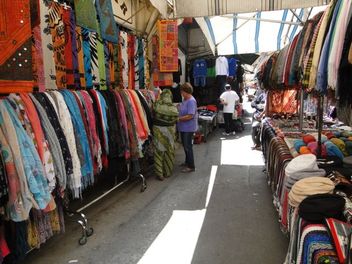 Judit and Indian stallholder, Palermo Market.
Judit and Indian stallholder, Palermo Market.
Just down the Via Vittorio Emanuele we were surprised at the style of the cathedral. A real mix of arabic and European. We must add that the outside is more spectacular than the inside.
From the cathedral we went into the back streets which reminded us of the markets in Cairo. Narrow and selling all sorts. In this area they seemed to concentrate on textiles. A lot of stall owners were Indian.
The market area spat us out onto Via Maqueda which we followed to the Massimo Theatre. At the cross roads we turned right onto Via Camillo Benso Cavour looking for an ATM. It was only when we were turning to Via Roma that we spotted one. Ah, cash at last. On Via Roma we stopped for a refreshing soft drink; it’s been very hot and sticky today. Officially 25°C but on the streets it must have been more.
We left Via Roma for some more backstreets but they were disappointing; everyone packing up for the afternoon. Back to Via Roma and a right turn back onto Via Vittorio Emanuele. Just round the corner was a surprise church called St Matteo. Doors wide open, enter for free and listen to some nice choral music while admiring the excellent interior. Nice place.
Not much further up the road was the Pretoria Fountain. The locals called it the Fountain of Shame because it had nude statues. The shame is that today there is a fence around it so you can only admire the wobbly bits from a distance. Next street along is Piazza Bellini with another two churches. We had to pay for this one, the church of Santa Maria del’Ammiraglio. It is described as Vibrant Byzantine, but according to our books it used to have wonderful mosaics. When the nuns took over the place they covered up all the mosaics with baroque workings. However we baulked at paying to enter the next door church of San Catoldo. It is 12th century and has 3 red domes on top. We’ve seen photos of the interior and it is definitely not worth paying for.
Then it was the long drag in the heat back to our car park. It was very warm in Bessy but with windows open it’s not so bad. There is even a cool breeze at 19:30.
From the cathedral we went into the back streets which reminded us of the markets in Cairo. Narrow and selling all sorts. In this area they seemed to concentrate on textiles. A lot of stall owners were Indian.
The market area spat us out onto Via Maqueda which we followed to the Massimo Theatre. At the cross roads we turned right onto Via Camillo Benso Cavour looking for an ATM. It was only when we were turning to Via Roma that we spotted one. Ah, cash at last. On Via Roma we stopped for a refreshing soft drink; it’s been very hot and sticky today. Officially 25°C but on the streets it must have been more.
We left Via Roma for some more backstreets but they were disappointing; everyone packing up for the afternoon. Back to Via Roma and a right turn back onto Via Vittorio Emanuele. Just round the corner was a surprise church called St Matteo. Doors wide open, enter for free and listen to some nice choral music while admiring the excellent interior. Nice place.
Not much further up the road was the Pretoria Fountain. The locals called it the Fountain of Shame because it had nude statues. The shame is that today there is a fence around it so you can only admire the wobbly bits from a distance. Next street along is Piazza Bellini with another two churches. We had to pay for this one, the church of Santa Maria del’Ammiraglio. It is described as Vibrant Byzantine, but according to our books it used to have wonderful mosaics. When the nuns took over the place they covered up all the mosaics with baroque workings. However we baulked at paying to enter the next door church of San Catoldo. It is 12th century and has 3 red domes on top. We’ve seen photos of the interior and it is definitely not worth paying for.
Then it was the long drag in the heat back to our car park. It was very warm in Bessy but with windows open it’s not so bad. There is even a cool breeze at 19:30.
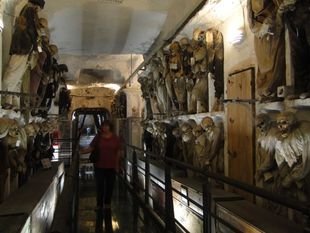 Judit in the catacombs.
Judit in the catacombs.
Thursday 22 May 2014
From our sosta in the car park we are only 300 meters from the Palermo Catacombs. Even then we missed the entrance and found ourselves in the cemetery instead. In its own way this was interesting with massive tombs for the rich and simpler graves for the poor. One or two of the big ones looked like they built in Mussolini’s time; very bold and simple. The smaller graves have framed photographs of the family members on top of the marble slab, looking very much like the top of a table in the sitting room.
The catacombs are next door in a sneaky corner. Palermo’s Capuchin monastery outgrew it’s original cemetery so in the 16th century the monks excavated crypts below it.
Originally the catacombs were intended only for the dead monks. Later it became a status symbol to be entombed in the catacombs. In their wills, local big wigs would ask to be preserved in certain clothes. Priests wore their vestments, and others were clothed according to the fashion at the time. Each new body was placed in a temporary niche and later placed into a more permanent place. As long as the money poured in the body remained in its proper place but when the relatives stopped sending money, the body was put aside on a shelf until they resumed payment.
To be honest a walk around the catacombs is a little bizarre and not for the squeamish.
From our sosta in the car park we are only 300 meters from the Palermo Catacombs. Even then we missed the entrance and found ourselves in the cemetery instead. In its own way this was interesting with massive tombs for the rich and simpler graves for the poor. One or two of the big ones looked like they built in Mussolini’s time; very bold and simple. The smaller graves have framed photographs of the family members on top of the marble slab, looking very much like the top of a table in the sitting room.
The catacombs are next door in a sneaky corner. Palermo’s Capuchin monastery outgrew it’s original cemetery so in the 16th century the monks excavated crypts below it.
Originally the catacombs were intended only for the dead monks. Later it became a status symbol to be entombed in the catacombs. In their wills, local big wigs would ask to be preserved in certain clothes. Priests wore their vestments, and others were clothed according to the fashion at the time. Each new body was placed in a temporary niche and later placed into a more permanent place. As long as the money poured in the body remained in its proper place but when the relatives stopped sending money, the body was put aside on a shelf until they resumed payment.
To be honest a walk around the catacombs is a little bizarre and not for the squeamish.
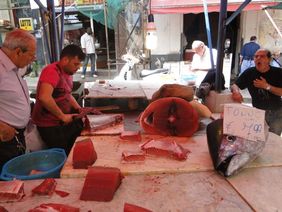 We bought two slices of tuna.
We bought two slices of tuna.
Once in the open air we walked into the city looking for the famous Ballaro market. It is supposed to combine clothing and food, but we only saw food on display. The atmosphere is like an English market with stallholders shouting their wares and it is quite lively. We bought a couple of tuna steaks from one fishmonger. Maybe it will serve as part of our diet day.
The market finally faded away and we found ourselves looking at a brass band assembling. All this in a very busy back street with traffic whizzing past. When they piped up it became clear they were playing for a funeral procession. They sounded really good and the poor person in the coffin got a good send off.
It was getting hot by now so we stopped at a cafe on the park near the palace. We really confused the poor waitress as we fancied a cold coffee like the frappe in Greece. She asked if we wanted granita. In our experience we had only seen fruit flavoured granita, so we said no. What fools we are. Judit finally sorted it out by going inside the cafe and pointing. Yes, they do make a crushed ice coffee... called granita coffee. Very tasty too.
Then back to the van to sort out some notes. Tonight is very hot.
The market finally faded away and we found ourselves looking at a brass band assembling. All this in a very busy back street with traffic whizzing past. When they piped up it became clear they were playing for a funeral procession. They sounded really good and the poor person in the coffin got a good send off.
It was getting hot by now so we stopped at a cafe on the park near the palace. We really confused the poor waitress as we fancied a cold coffee like the frappe in Greece. She asked if we wanted granita. In our experience we had only seen fruit flavoured granita, so we said no. What fools we are. Judit finally sorted it out by going inside the cafe and pointing. Yes, they do make a crushed ice coffee... called granita coffee. Very tasty too.
Then back to the van to sort out some notes. Tonight is very hot.
 Driving in Palermo is an adventure.
Driving in Palermo is an adventure.
Friday 23 May 2014
Leaving Palermo was not too bad because we found ourselves at a cross roads and a massive container truck with a container trailer was turning in front of us. Everybody had to get out of his way so we tagged along just behind him. There should be more of these trucks in Sicily!
Just a few kilometers away we stocked up at LIDL, and this time nobody was begging at the door. Fully laden for the weekend we headed for Cefalu where we have had reports of a good Night Stop on the harbour. The road was good but somehow it turned into an empty toll road which cost us the grand sum of €0.90. We must do it again.
Cefalu appears to be a nice place but there was so much traffic it looked like Blackpool on a Bank Holiday. Ian had no problem deciding to move on. This we did and stopped at Rais Gerbi Camp just 15 Km further east along the coast. The camp has a good write up but we soon found that the internet is the worst we’ve had. After a few minutes it simply switches off and stays off for for the day. The camp receptionist said they had just replaced the old system and this is worse. I can have my €5.00 back. I really want to update the website and this weekend looks the best time. According to weather reports it will rain Friday night and all day Saturday.
Well, the rain started with a bang Friday tea time and we had thunder, high winds and heavy rain all night as predicted.
Leaving Palermo was not too bad because we found ourselves at a cross roads and a massive container truck with a container trailer was turning in front of us. Everybody had to get out of his way so we tagged along just behind him. There should be more of these trucks in Sicily!
Just a few kilometers away we stocked up at LIDL, and this time nobody was begging at the door. Fully laden for the weekend we headed for Cefalu where we have had reports of a good Night Stop on the harbour. The road was good but somehow it turned into an empty toll road which cost us the grand sum of €0.90. We must do it again.
Cefalu appears to be a nice place but there was so much traffic it looked like Blackpool on a Bank Holiday. Ian had no problem deciding to move on. This we did and stopped at Rais Gerbi Camp just 15 Km further east along the coast. The camp has a good write up but we soon found that the internet is the worst we’ve had. After a few minutes it simply switches off and stays off for for the day. The camp receptionist said they had just replaced the old system and this is worse. I can have my €5.00 back. I really want to update the website and this weekend looks the best time. According to weather reports it will rain Friday night and all day Saturday.
Well, the rain started with a bang Friday tea time and we had thunder, high winds and heavy rain all night as predicted.
Saturday 24 May 2014
So it was the long walk to reception and then a long slow slog with the internet to update the site. The boss says he has spent €15,000 on updating the wifi for the camp. He probably means €1,500 but even that is too much. He’s a bit of a grumpy old sod and says that the new system is worse than the old. Answer: do something about it!
That was our day.
So it was the long walk to reception and then a long slow slog with the internet to update the site. The boss says he has spent €15,000 on updating the wifi for the camp. He probably means €1,500 but even that is too much. He’s a bit of a grumpy old sod and says that the new system is worse than the old. Answer: do something about it!
That was our day.
 Return from church. Cefalu.
Return from church. Cefalu.
Sunday 25 May 2014
Mr Grumpy took us to the station in the neighbouring village called Finale. He stopped in the village where Ian had to get out and purchase return train tickets to Cefalu. Then to the station, which is not in the village. In fact it is nowhere near anywhere. That’s forward planning.
The train was on time and clean, arriving in Cefalu in about 20 minutes. Lovely views of the sea interrupted by several tunnels. Cefalu new town is pretty grotty and boring but the old town is delightful. It is built on a grid system of very narrow streets and is said to be the prettiest town in Sicily after Taormina. Judit wanted to climb the mountain towering over the town because there was a Greek ruin at the top. Thankfully, we found that the shortest walk would be at least one hour to the top and the longest three hours; so we turned round and went for a snack. The nice shop/bar owner sold us a selection of 10 different plates of bread with Sicilian things on them, including a glass of wine. When we chatted with him about his favourite place in England, Liverpool, he started to pour more wine and a strange almond flavoured liqueur.
Of course Judit had to enter the bar/shop and buy some pistachio pesto and other things. We had a delicious espresso on the house.
After more nosing around the grid system we returned to the station and took the train back to Finale. Mr Grumpy was supposed to be waiting for us. After 45 minutes several families arrived at the station to put their daughters on the train to Palermo University. One of them kindly telephoned Mr Grumpy and he arrived within 10 minutes without a word of apology.
Mr Grumpy took us to the station in the neighbouring village called Finale. He stopped in the village where Ian had to get out and purchase return train tickets to Cefalu. Then to the station, which is not in the village. In fact it is nowhere near anywhere. That’s forward planning.
The train was on time and clean, arriving in Cefalu in about 20 minutes. Lovely views of the sea interrupted by several tunnels. Cefalu new town is pretty grotty and boring but the old town is delightful. It is built on a grid system of very narrow streets and is said to be the prettiest town in Sicily after Taormina. Judit wanted to climb the mountain towering over the town because there was a Greek ruin at the top. Thankfully, we found that the shortest walk would be at least one hour to the top and the longest three hours; so we turned round and went for a snack. The nice shop/bar owner sold us a selection of 10 different plates of bread with Sicilian things on them, including a glass of wine. When we chatted with him about his favourite place in England, Liverpool, he started to pour more wine and a strange almond flavoured liqueur.
Of course Judit had to enter the bar/shop and buy some pistachio pesto and other things. We had a delicious espresso on the house.
After more nosing around the grid system we returned to the station and took the train back to Finale. Mr Grumpy was supposed to be waiting for us. After 45 minutes several families arrived at the station to put their daughters on the train to Palermo University. One of them kindly telephoned Mr Grumpy and he arrived within 10 minutes without a word of apology.
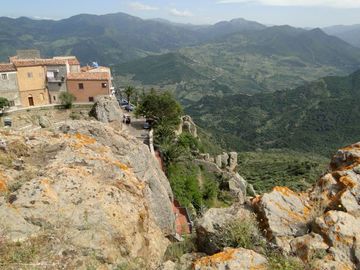 View from the town of Pollino.
View from the town of Pollino.
Monday 26 May 2014
We note with delight that the Euro is down in value to €1.21 to the Pound after the results of the EU election. Now we get more Euros for our Pound.
After deciding what we would do with our windfall, we took the bus up the very twisting hill to the village of Pollina. This hilltop town is not pretty but it is interesting with its narrow winding, steep streets. Surprisingly a small van was selling veg and driving through the streets meant for donkeys yelling his head off.
The views from the top were outstanding, and we were at the very top. An old boy insisted on dragging us up the bits of rock he probably jumped around on 80 year ago. He was still more agile than us. Luckily the place had an ATM so we were able to stock up on cheaper Euros before taking the bus down the mountain.
The driver seemed to be having a competition with himself as to how fast he could negotiate hairpin bends while using his mobile with one hand and gesticulating with the other. Thankfully we arrived OK.
It’s worth pointing out that road signs in Sicily are purely for decoration. If you see a number you should double it and drive at that speed. Scooters must pass on both sides at three times the speed of other traffic. They delight in making surprise attacks from all angles. Parking is best done by just pointing the front of your vehicle at the kerb, stopping one meter away and leaving the tail of the car in the driving lane thus making it impossible for other traffic to pass. Some may think this is funny but it begins to grate after a while.
We note with delight that the Euro is down in value to €1.21 to the Pound after the results of the EU election. Now we get more Euros for our Pound.
After deciding what we would do with our windfall, we took the bus up the very twisting hill to the village of Pollina. This hilltop town is not pretty but it is interesting with its narrow winding, steep streets. Surprisingly a small van was selling veg and driving through the streets meant for donkeys yelling his head off.
The views from the top were outstanding, and we were at the very top. An old boy insisted on dragging us up the bits of rock he probably jumped around on 80 year ago. He was still more agile than us. Luckily the place had an ATM so we were able to stock up on cheaper Euros before taking the bus down the mountain.
The driver seemed to be having a competition with himself as to how fast he could negotiate hairpin bends while using his mobile with one hand and gesticulating with the other. Thankfully we arrived OK.
It’s worth pointing out that road signs in Sicily are purely for decoration. If you see a number you should double it and drive at that speed. Scooters must pass on both sides at three times the speed of other traffic. They delight in making surprise attacks from all angles. Parking is best done by just pointing the front of your vehicle at the kerb, stopping one meter away and leaving the tail of the car in the driving lane thus making it impossible for other traffic to pass. Some may think this is funny but it begins to grate after a while.
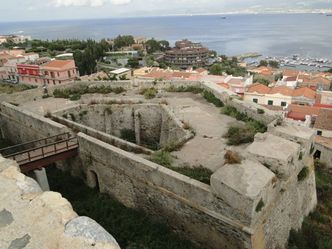 View from Milazzo castle.
View from Milazzo castle.
Tuesday 27 May 2014
We left Rais Gerbi and travelled on the motorway across deep dramatic valleys and through dark tunnels to Milazzo. It was surprisingly easy to drive through the town as a dual carriageway goes almost to the centre. We found the Night Stop with no problems. It’s not much more than a sloping dirt car park, full of the usual Sicilian rubbish but we have lovely views of the harbour comings and goings. At night the oil terminal on the opposite shore twinkled rather nicely.
But before night we went for a stroll. Why does Judit always want to “stroll” up 500 steps to a castle? This we did and we were rewarded with lovely views of the town and surroundings.
We left Rais Gerbi and travelled on the motorway across deep dramatic valleys and through dark tunnels to Milazzo. It was surprisingly easy to drive through the town as a dual carriageway goes almost to the centre. We found the Night Stop with no problems. It’s not much more than a sloping dirt car park, full of the usual Sicilian rubbish but we have lovely views of the harbour comings and goings. At night the oil terminal on the opposite shore twinkled rather nicely.
But before night we went for a stroll. Why does Judit always want to “stroll” up 500 steps to a castle? This we did and we were rewarded with lovely views of the town and surroundings.
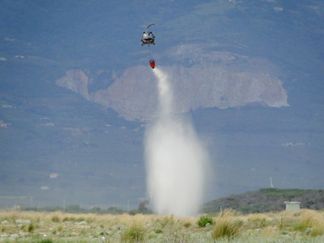 Practice water bombing.
Practice water bombing.
Wednesday 28 May 2014
Once again we drove on the motorway through tunnels and across viaducts. Italy will be in trouble in 20 year’s time because many of the concrete structures have concrete rot. Entry to Messina was easier on this route and we were soon on the port waiting to board. We chatted in our best Italian to the Port car parking attendant and gave him a cup of coffee. Nice old boy called Pietro.
The boat arrived one hour later and we were soon boarded for the 30 minute crossing. This time it was much smoother, but Judit was feeling the cold.
The general plan is to head north and then across the toes of Italy to the instep. However we decided to stop on the beach again north of Pizzo. Not the same place but another road to the beach a couple of miles further north. It was quiet and level. However people seem to drive to this point, turn round and go back... why? Dozens of people made the same trip during the afternoon.
Later we had two exciting helicopter incidents. First was a Huey carrying a big orange container. It all became clearer when he descended to sea level and filled up the container with sea water. He then climbed over the trees and dumped the lot. During the afternoon they made several similar trips. There was no fire so we guessed it was an exercise.
Second incident was quite different. We heard a helicopter buzz approaching and then realised he was following the shoreline at about 6 feet above the water, going like a bat out of hell. It appeared to say something about forestry on the side. The low level and speed was probably doing his flying the Italian way.
Once again we drove on the motorway through tunnels and across viaducts. Italy will be in trouble in 20 year’s time because many of the concrete structures have concrete rot. Entry to Messina was easier on this route and we were soon on the port waiting to board. We chatted in our best Italian to the Port car parking attendant and gave him a cup of coffee. Nice old boy called Pietro.
The boat arrived one hour later and we were soon boarded for the 30 minute crossing. This time it was much smoother, but Judit was feeling the cold.
The general plan is to head north and then across the toes of Italy to the instep. However we decided to stop on the beach again north of Pizzo. Not the same place but another road to the beach a couple of miles further north. It was quiet and level. However people seem to drive to this point, turn round and go back... why? Dozens of people made the same trip during the afternoon.
Later we had two exciting helicopter incidents. First was a Huey carrying a big orange container. It all became clearer when he descended to sea level and filled up the container with sea water. He then climbed over the trees and dumped the lot. During the afternoon they made several similar trips. There was no fire so we guessed it was an exercise.
Second incident was quite different. We heard a helicopter buzz approaching and then realised he was following the shoreline at about 6 feet above the water, going like a bat out of hell. It appeared to say something about forestry on the side. The low level and speed was probably doing his flying the Italian way.
Thursday 29 May 2014
We were woken during the night by heavy rain and it continued almost all day. Luckily we had no problem moving from the sand and headed north through lovely scenery to the turn off through a low level pass to the east coast. Our information pointed to a sosta but it turned out to be a campsite called Thurium. It’s a lovely place with lousy internet and we decided to stay. The camp is right on the beach and we are parked under very tall pines with lots of shade. However it still rained on and off.
Although the internet was crap Jo managed to get through with FaceTime and we had a good chat.
We were woken during the night by heavy rain and it continued almost all day. Luckily we had no problem moving from the sand and headed north through lovely scenery to the turn off through a low level pass to the east coast. Our information pointed to a sosta but it turned out to be a campsite called Thurium. It’s a lovely place with lousy internet and we decided to stay. The camp is right on the beach and we are parked under very tall pines with lots of shade. However it still rained on and off.
Although the internet was crap Jo managed to get through with FaceTime and we had a good chat.
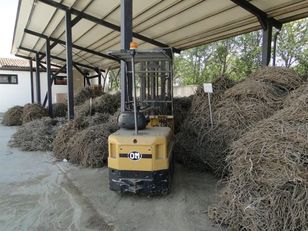 Freshly collected liquorice root.
Freshly collected liquorice root.
Friday 30 May 2014
After breakfast and a bit of laundry we went to reception to take their outing to the liquorice factory. About 10 of us went in the camp minibus to the factory about 15 Km away.
It’s the first and oldest liquorice factory in Europe and we had a great guided tour by a lovely Italian girl. The plant is not cultivated in fields like it used to be in Pontefract, it is completely wild. Every three or four years the locals dig up the roots; leaving just a small section of root in the ground for the plant to regrow.
The roots are then ground into a powder before being boiled to extract the black liquid liquorice juice. The water is boiled away leaving a sticky paste.For variety some of the liquorice is mixed with Gum Arabic from Sudan to make chewy sweets.
They produce a large range of sweets: some plain, with mint, with orange and various other flavours.
After breakfast and a bit of laundry we went to reception to take their outing to the liquorice factory. About 10 of us went in the camp minibus to the factory about 15 Km away.
It’s the first and oldest liquorice factory in Europe and we had a great guided tour by a lovely Italian girl. The plant is not cultivated in fields like it used to be in Pontefract, it is completely wild. Every three or four years the locals dig up the roots; leaving just a small section of root in the ground for the plant to regrow.
The roots are then ground into a powder before being boiled to extract the black liquid liquorice juice. The water is boiled away leaving a sticky paste.For variety some of the liquorice is mixed with Gum Arabic from Sudan to make chewy sweets.
They produce a large range of sweets: some plain, with mint, with orange and various other flavours.
Saturday 31 May 2014
The day started sunny but was overcast later and then the strong wind burst upon us. It was a quick dash to get the awning in before it tore from the side of Bessy.
While it was sunny we sunbathed on the spotless beach and even had a paddle but it was damned cold. We saw one brave/foolish woman leap into the sea and swim around for half an hour. We never saw her get out but she must have been blue.
Sunday 1 June 2014
Another lazy day after we were woken at 05:00 by wind, rain and giant pine cones dropping on the roof. It had to be a lazy day because it was raining most of the time.
The day started sunny but was overcast later and then the strong wind burst upon us. It was a quick dash to get the awning in before it tore from the side of Bessy.
While it was sunny we sunbathed on the spotless beach and even had a paddle but it was damned cold. We saw one brave/foolish woman leap into the sea and swim around for half an hour. We never saw her get out but she must have been blue.
Sunday 1 June 2014
Another lazy day after we were woken at 05:00 by wind, rain and giant pine cones dropping on the roof. It had to be a lazy day because it was raining most of the time.
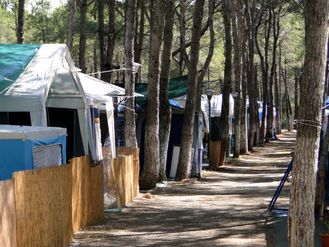 Cramped camp Julia.
Cramped camp Julia.
Monday 2 June 2014
Time to move on. But first we had to motor around the campsite to find the chemical toilet dump in one place, the grey water in another and near reception one fresh water tap. It took us most of an hour to sort that lot out before moving down the road to a giant Auchan shopping centre. They really had lots of stuff but Ian could not find Stinco. This is a marinated piece of meat, a little like a lamb shank. We’ve found it in northern Italy and it really is delicious.
Nearby was a large Chinese shop where we hoped to find fly curtains. Every house and every shop has them but they can’t be found anywhere. Judit wanted them for the Almadi house.
At last we made a move northward along the instep of Italy to a campsite we found on our way to Malta. Well, we found it but it has changed. Before there were motorhomes and tents scattered around under the pine trees. It was a lovely atmosphere.
Now it is a typical Italian semi-permanent campsite. People have a caravan. Attached to that is a so-called Safari Room made of tent material. In front of that will be two or three more tents. One will be a store, another a kitchen. Around all this is always a fence of some sort, usually windbreak material or reed matting, and underneath everything is a giant tarpaulin to walk on. Then the open area will be covered with a gazebo of sorts for the sitting room. Over the whole lot is often a metal frame work supporting another roof. Naturally each “homestead” is different to the neighbour; different layout, different colours, different quality. To complete the picture you should know that these caravans and tents are only inches away from the neighbour. It could be described as colourful but in reality they resemble an Ethiopian refugee camp.
However, we move on tomorrow and try to find the cave dwellings in Matera.
Time to move on. But first we had to motor around the campsite to find the chemical toilet dump in one place, the grey water in another and near reception one fresh water tap. It took us most of an hour to sort that lot out before moving down the road to a giant Auchan shopping centre. They really had lots of stuff but Ian could not find Stinco. This is a marinated piece of meat, a little like a lamb shank. We’ve found it in northern Italy and it really is delicious.
Nearby was a large Chinese shop where we hoped to find fly curtains. Every house and every shop has them but they can’t be found anywhere. Judit wanted them for the Almadi house.
At last we made a move northward along the instep of Italy to a campsite we found on our way to Malta. Well, we found it but it has changed. Before there were motorhomes and tents scattered around under the pine trees. It was a lovely atmosphere.
Now it is a typical Italian semi-permanent campsite. People have a caravan. Attached to that is a so-called Safari Room made of tent material. In front of that will be two or three more tents. One will be a store, another a kitchen. Around all this is always a fence of some sort, usually windbreak material or reed matting, and underneath everything is a giant tarpaulin to walk on. Then the open area will be covered with a gazebo of sorts for the sitting room. Over the whole lot is often a metal frame work supporting another roof. Naturally each “homestead” is different to the neighbour; different layout, different colours, different quality. To complete the picture you should know that these caravans and tents are only inches away from the neighbour. It could be described as colourful but in reality they resemble an Ethiopian refugee camp.
However, we move on tomorrow and try to find the cave dwellings in Matera.
 A small part of the Sassi in Matera.
A small part of the Sassi in Matera.
Tuesday 3 June 2014
It’s only a one hour drive north to Matera. The guide books give this place such a build up we have to see it. The city is famous for the cave dwellings along the walls of a gorge.
9,000 years ago, maybe much earlier, humans settled in caves in the gorge walls, extending them until thousands of them honeycombed the town. The caves make up Italy’s oldest continually inhabited dwellings and, according to Unesco, “the most outstanding example of a troglodyte settlement in the Mediterranean”.
The caves are known as Sassi. In the 1930s around 20,000 people were crammed into the sassi. They had no heat, light or sanitation. Humans and animals slept together. Literacy was 10 per cent, infant mortality 50 per cent. Malaria was rife. The south of Italy was always impoverished but the Sassi dwellers suffered most.
In the 1950s the State was shamed into action and everyone was moved from the caves into new housing. The caves were empty for years until squatters and film makers started to make the place famous. Mel Gibson’s “The Passion of the Christ” was shot in the surroundings.
Now many of the Sassi are occupied. Some are hotels, some restaurants and souvenir shops. Many are churches... you can’t have enough churches in Italy.
You get the idea. It’s a great place to meander around. Avoid paying €15 to €20 per person for a guided tour. It’s a maze but not difficult to find your way around. Our first thoughts were that the caves would be something like holes in the cliff face. In reality 99% of the dwellings are fairly normal looking houses. They probably have a cave at the back or a cave cellar. Do visit and enjoy the place we had a lovely meander and found ourselves in a square filled with the sound of music. (Not Julie Andrews). The music came from rooms above the street used for practice by the young students at the Conservatory of Music.
One thing the guide books do not mention is the lack of parking. The locals want tourism but can’t be bothered helping the tourists. At the entrance to the city are signs for parking and even special signs for motorhome parking. We drove the length and breadth of Matera looking for parking... there is none. We witnessed 3 different traffic jams because buses and vans could not pass each other thanks to stupid idiots parking nose in instead of parallel parking like everyone else. Best thing is to be lowered from a helicopter. Eventually we found a reasonably quiet street to the south west of the station. Not good for sleeping but OK for parking. It’s about one kilometer to the Sassi.
One nice chap in a travel agents gave us directions to a small campsite south on the outskirts of the city and we drove there for the night.
It’s only a one hour drive north to Matera. The guide books give this place such a build up we have to see it. The city is famous for the cave dwellings along the walls of a gorge.
9,000 years ago, maybe much earlier, humans settled in caves in the gorge walls, extending them until thousands of them honeycombed the town. The caves make up Italy’s oldest continually inhabited dwellings and, according to Unesco, “the most outstanding example of a troglodyte settlement in the Mediterranean”.
The caves are known as Sassi. In the 1930s around 20,000 people were crammed into the sassi. They had no heat, light or sanitation. Humans and animals slept together. Literacy was 10 per cent, infant mortality 50 per cent. Malaria was rife. The south of Italy was always impoverished but the Sassi dwellers suffered most.
In the 1950s the State was shamed into action and everyone was moved from the caves into new housing. The caves were empty for years until squatters and film makers started to make the place famous. Mel Gibson’s “The Passion of the Christ” was shot in the surroundings.
Now many of the Sassi are occupied. Some are hotels, some restaurants and souvenir shops. Many are churches... you can’t have enough churches in Italy.
You get the idea. It’s a great place to meander around. Avoid paying €15 to €20 per person for a guided tour. It’s a maze but not difficult to find your way around. Our first thoughts were that the caves would be something like holes in the cliff face. In reality 99% of the dwellings are fairly normal looking houses. They probably have a cave at the back or a cave cellar. Do visit and enjoy the place we had a lovely meander and found ourselves in a square filled with the sound of music. (Not Julie Andrews). The music came from rooms above the street used for practice by the young students at the Conservatory of Music.
One thing the guide books do not mention is the lack of parking. The locals want tourism but can’t be bothered helping the tourists. At the entrance to the city are signs for parking and even special signs for motorhome parking. We drove the length and breadth of Matera looking for parking... there is none. We witnessed 3 different traffic jams because buses and vans could not pass each other thanks to stupid idiots parking nose in instead of parallel parking like everyone else. Best thing is to be lowered from a helicopter. Eventually we found a reasonably quiet street to the south west of the station. Not good for sleeping but OK for parking. It’s about one kilometer to the Sassi.
One nice chap in a travel agents gave us directions to a small campsite south on the outskirts of the city and we drove there for the night.
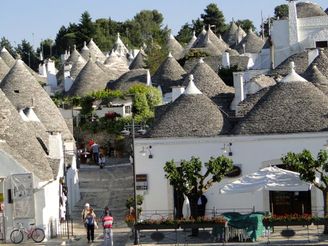 Charming rooftops in Alberobello.
Charming rooftops in Alberobello.
Wednesday 4 June 2014
The sun was up and a cool breeze blowing, the road was in good nick and we were on our way to Alberobello. It really was a pleasant ride through lush farmland. The countryside was sliced up into fields with lovely grey stone walls. We even saw several teams repairing the walls.
Alberobello is famous for Trulli houses. These are generally circular dry stone houses with a conical dry stone roof. The reason given for this interesting and rather pretty construction goes back hundreds of years. To avoid taxes a certain local Lord of the Manor made his peasants build the houses in this way. Then when the taxman came round the locals would be told to knock down the houses and thus avoid the tax.
The motorhome parking area is very close to the Trulli area of town and is very good. For €18 we had a pitch, dump, water, electric and probably the best wifi we’ve had in Italy. In addition the area was a very clean olive grove.
Our stroll through the Trulli area took us down the main Trulli street. It is packed with souvenir shops selling trash. However, get off that street and the whole place is absolutely charming. People live in these houses and keep them in excellent condition.
The new part of town is also very attractive and we enjoyed our stroll through the streets. In the main square was a lovely collection of shade trees making a perfect “box” for the old boys to sit under and chew the fat.
There is a second trulli area and we found this to be charming because there were no shops at all. The whole town is well worth a visit.
The sun was up and a cool breeze blowing, the road was in good nick and we were on our way to Alberobello. It really was a pleasant ride through lush farmland. The countryside was sliced up into fields with lovely grey stone walls. We even saw several teams repairing the walls.
Alberobello is famous for Trulli houses. These are generally circular dry stone houses with a conical dry stone roof. The reason given for this interesting and rather pretty construction goes back hundreds of years. To avoid taxes a certain local Lord of the Manor made his peasants build the houses in this way. Then when the taxman came round the locals would be told to knock down the houses and thus avoid the tax.
The motorhome parking area is very close to the Trulli area of town and is very good. For €18 we had a pitch, dump, water, electric and probably the best wifi we’ve had in Italy. In addition the area was a very clean olive grove.
Our stroll through the Trulli area took us down the main Trulli street. It is packed with souvenir shops selling trash. However, get off that street and the whole place is absolutely charming. People live in these houses and keep them in excellent condition.
The new part of town is also very attractive and we enjoyed our stroll through the streets. In the main square was a lovely collection of shade trees making a perfect “box” for the old boys to sit under and chew the fat.
There is a second trulli area and we found this to be charming because there were no shops at all. The whole town is well worth a visit.
 A machine to clean your toilet cassette.
A machine to clean your toilet cassette.
Thursday 5 June 2014
Our first task in the morning was to work out how to use the machine next to the dump. If you put your toilet cassette in there it washes and cleans the cassette. Luckily the parking attendant had to come and do it because there was a special switch at the back! We’d never seen one of these amazing machines.
Then Judit dashed off to the local market, coming back with spuds, celery and tons of olives. She has a thing about olives.
The ride through the countryside was pleasant and people seemed to care. But not around Bari which was chaotic and the road junction devil had been at work making highly complex junctions.
We even came across two roundabouts on a nice pleasant road. Nothing wrong with that you may say; but there was no other road just ours.... work that one out. Imagine the situation in the town planning department. “Giorgio I am planning to build two roundabouts. You can have the building contract. I’ll meet you at the usual place for the brown envelope.”
On arriving at Castel del Monte a nice guy told us not to park at the roadside as the Police will fine us. Down the hill was a massive grass car park with motorhome facilities. For €7 we could stop, and use the electric, water, toilets and even a dump. Not a high tech place but very pleasant to be in the countryside.
Ian spent the afternoon preparing one of our diet meals; a sort of chicken cassoulet. Very tasty and very filling, but low on calories.
Our first task in the morning was to work out how to use the machine next to the dump. If you put your toilet cassette in there it washes and cleans the cassette. Luckily the parking attendant had to come and do it because there was a special switch at the back! We’d never seen one of these amazing machines.
Then Judit dashed off to the local market, coming back with spuds, celery and tons of olives. She has a thing about olives.
The ride through the countryside was pleasant and people seemed to care. But not around Bari which was chaotic and the road junction devil had been at work making highly complex junctions.
We even came across two roundabouts on a nice pleasant road. Nothing wrong with that you may say; but there was no other road just ours.... work that one out. Imagine the situation in the town planning department. “Giorgio I am planning to build two roundabouts. You can have the building contract. I’ll meet you at the usual place for the brown envelope.”
On arriving at Castel del Monte a nice guy told us not to park at the roadside as the Police will fine us. Down the hill was a massive grass car park with motorhome facilities. For €7 we could stop, and use the electric, water, toilets and even a dump. Not a high tech place but very pleasant to be in the countryside.
Ian spent the afternoon preparing one of our diet meals; a sort of chicken cassoulet. Very tasty and very filling, but low on calories.
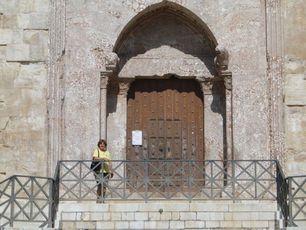 Castel del Monte.
Castel del Monte.
Friday 6 June 2014
Today we had an early rise, prepared for the off and then took the free shuttle bus to the castle. It was built by Frederick II in 1897 (about) and has never been lived in. As it would not open until 10:00 we settled for a walk around, admired the view out to the coast and Bari, then walked back down the hill to Bessy.
From the castle we pointed north with the idea of stopping at Lucera. Our list of places to park motorhomes for the night in Italy is basically rubbish and cannot be relied upon. The place we found in Lucera was the bus station and car park.
We ate lunch in the bus station and moved on. Dear Jane (who sits inside our SatNav) wanted a joke and took us through the middle of Foggia, even though there was a ring road. Mind you, a sign for “Ring Road” would have been useful.
But at San Severo she did the right thing and took us round the town. Again, not one sign for a “Ring Road”. Soon we were following the non-toll coast road in the direction of Termoli. Even without the “Ring Road” sign the trucks in front seemed to know and we followed them. That was a wise move as it took us all the way past the town.
Today we had an early rise, prepared for the off and then took the free shuttle bus to the castle. It was built by Frederick II in 1897 (about) and has never been lived in. As it would not open until 10:00 we settled for a walk around, admired the view out to the coast and Bari, then walked back down the hill to Bessy.
From the castle we pointed north with the idea of stopping at Lucera. Our list of places to park motorhomes for the night in Italy is basically rubbish and cannot be relied upon. The place we found in Lucera was the bus station and car park.
We ate lunch in the bus station and moved on. Dear Jane (who sits inside our SatNav) wanted a joke and took us through the middle of Foggia, even though there was a ring road. Mind you, a sign for “Ring Road” would have been useful.
But at San Severo she did the right thing and took us round the town. Again, not one sign for a “Ring Road”. Soon we were following the non-toll coast road in the direction of Termoli. Even without the “Ring Road” sign the trucks in front seemed to know and we followed them. That was a wise move as it took us all the way past the town.
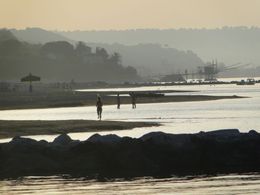 Le Morge beach in the evening.
Le Morge beach in the evening.
At San Salvo Marine our list gave us three possible places to stop. First thing to note was a sign banning motorhomes from the town. The first place we came to was a large empty car park. Spotting two Traffic Warden ladies Ian went for a chat. The ladies were very kind and told us there was no parking in the town only in campsites. One of our points was a campsite but it was closed. Our famous list gets worse. So it was “Goodbye” to San Salvo Marina. They can clearly manage without our business.
The next option further north was Le Morge where we stopped two year ago when driving to Bari for the Greek ferry. At that time it was absolutely empty. Not today. Passing under the railway bridge was a sign prohibiting motorhomes but Judit went into a beach cafe and returned with good news. We can park for the whole day for €3. With tokens we can have a hot shower on the beach and there are toilets. We decided to stay.
The next option further north was Le Morge where we stopped two year ago when driving to Bari for the Greek ferry. At that time it was absolutely empty. Not today. Passing under the railway bridge was a sign prohibiting motorhomes but Judit went into a beach cafe and returned with good news. We can park for the whole day for €3. With tokens we can have a hot shower on the beach and there are toilets. We decided to stay.
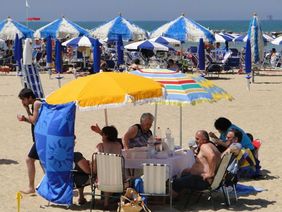 A family day out at Le Morge.
A family day out at Le Morge.
Weekend 7 and 8 June 2014
It was sunbathing time. The sea was warm and the cafe sold chips. One cafe in the middle of the beach even had free wifi.
It was sunbathing time. The sea was warm and the cafe sold chips. One cafe in the middle of the beach even had free wifi.
Observation on driving in Italy
Italy has a wonderful network of roads. Almost any destination is easy to find but there are some problems.
Italy has a wonderful network of roads. Almost any destination is easy to find but there are some problems.
- tunnels and viaducts. There seems to be an obsession to use expensive road building techniques. In some areas tunnels and viaducts are necessary, but not everywhere. Today many viaducts are suffering from “concrete rot” and many tunnels have peeling walls. Some of the tunnels have no lighting at all and when entering them on a bright sunny day it is like someone has dropped a bucket over your head. Very disturbing. The other problem with viaducts and bridges is the very large gaps where a good expansion joint should be. Every single one produces a massive clunk from Bessy’s suspension and our spines.
- The road surface is in a terrible state in many parts of the country and where the road has been repaired it has often been repaired badly.
- Road signs. There is an excess of road signs that don’t really help. Italy also use the silly French system where on the right of the road will be a sign for “Roma” pointing left. Beware, because on the left of the road junction will be a sign for “Roma” pointing right. What the hell is wrong with one “up arrow”?
- Road signs seem to be for decoration because few drivers take any notice at all. The same goes for double white lines, “No parking” signs, etc.
- Motorway signs can be confusing. When approaching a motorway junction to Rome, for example, the left hand lane will point straight ahead and the right hand lane will have an arrow indicating that this lane turns off for Rome. But it is not true. Both lanes are for straight ahead. But not always.
- Acceleration and Deceleration lanes on motorways are not long enough and sometimes non-existent.
- ARMCO crash barriers are everywhere and it is virtually impossible to pull off a road for a quiet 5 minutes. The amount of steel on the roadsides could have been partly responsible for Italy’s debt problems.
- Parking is really difficult. Even towns promoting a wonderful tourist attraction are unlikely to have a dedicated car park. We have found them in the Valley of the Temples in Sicily and a few other places but it is often easier to just drive on a forget the place.
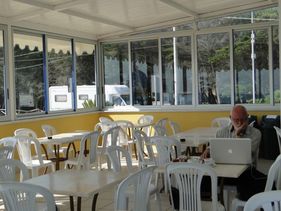 Ian checks emails in beach cafe.
Ian checks emails in beach cafe.
Monday 9 June 2014
First job this morning was to check emails at the friendly cafe 15 minutes walk along the beach. And we had one, from Fabio. He said it would be good to visit them 20/22 June in Udine. We can’t wait to see our lovely Italian friends.
Today would be a long drive along the non-toll roads of the Italian East Coast.
There were many small towns to negotiate; but no real problems. Our first stop was near Pescara where we knew of a LIDL. We took the opportunity to stock up on some cheap booze for when friends visit us in Hungary. Decent whisky, gin and vodka cost about €5 a bottle. Why are we paying £15 to £20 a bottle in the UK?
Our first stop was at Grottammare where we knew of a good car park. Sadly the town does not want motorhomes parking anywhere from June to September. But just down the road was the campsite “Don Diego” and surely well worth a visit. After going through all the details on our ACSI card the lady informed us that there was no ACSI discount and the cost would be €33.
We left rather quickly.
First job this morning was to check emails at the friendly cafe 15 minutes walk along the beach. And we had one, from Fabio. He said it would be good to visit them 20/22 June in Udine. We can’t wait to see our lovely Italian friends.
Today would be a long drive along the non-toll roads of the Italian East Coast.
There were many small towns to negotiate; but no real problems. Our first stop was near Pescara where we knew of a LIDL. We took the opportunity to stock up on some cheap booze for when friends visit us in Hungary. Decent whisky, gin and vodka cost about €5 a bottle. Why are we paying £15 to £20 a bottle in the UK?
Our first stop was at Grottammare where we knew of a good car park. Sadly the town does not want motorhomes parking anywhere from June to September. But just down the road was the campsite “Don Diego” and surely well worth a visit. After going through all the details on our ACSI card the lady informed us that there was no ACSI discount and the cost would be €33.
We left rather quickly.
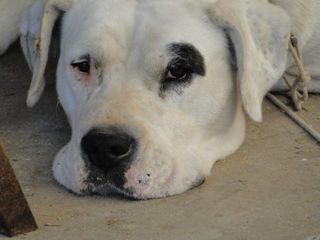 Tasha keeps his eye on us.
Tasha keeps his eye on us.
Only 20 Km up the road was a place we had stayed two year ago. It was winter and the sosta was closed so we parked on the beach. It was then that another GB motorhome arrived with Geoff and Corrie on board. From that moment we became friends; later meeting them at Igoumenitsa and also at Camping Finikes.
Anyway, back to today. The sosta was open and looking much tidier than before. The reception is not open all the time and we had to wait one hour. It was then that we met a charming 79 year old sailor from Milan. Giorgio was busy rebuilding a wooden sailing boat with the help of a man from the Ukraine. We were shown around and heard all the stories. We even met the brutish looking guard dog, Tasha, who turned out to be rather nice, lounging on the carpenter’s floor and keeping a watchful black-ringed eye on us.
Back to the sosta. By now a young man called Gianluca (sorry about the spelling) was keen to help us and surprised that we had come all the way from England. He said that normally only Italians came here. Anyway the price for one day was €12 but as we were only overnighting the cost would be €7. That included electricity, water, dump, showers but no toilets. The beach only a stroll down the short lane. What’s the problem? We stayed the night.
Our stupid Orange telephone really does cause problems. We can get internet in many places for free but you have to register. That means sending an SMS with a name and they will send an SMS with a password... but the damned Orange mobile will not work in Italy.
Anyway, back to today. The sosta was open and looking much tidier than before. The reception is not open all the time and we had to wait one hour. It was then that we met a charming 79 year old sailor from Milan. Giorgio was busy rebuilding a wooden sailing boat with the help of a man from the Ukraine. We were shown around and heard all the stories. We even met the brutish looking guard dog, Tasha, who turned out to be rather nice, lounging on the carpenter’s floor and keeping a watchful black-ringed eye on us.
Back to the sosta. By now a young man called Gianluca (sorry about the spelling) was keen to help us and surprised that we had come all the way from England. He said that normally only Italians came here. Anyway the price for one day was €12 but as we were only overnighting the cost would be €7. That included electricity, water, dump, showers but no toilets. The beach only a stroll down the short lane. What’s the problem? We stayed the night.
Our stupid Orange telephone really does cause problems. We can get internet in many places for free but you have to register. That means sending an SMS with a name and they will send an SMS with a password... but the damned Orange mobile will not work in Italy.
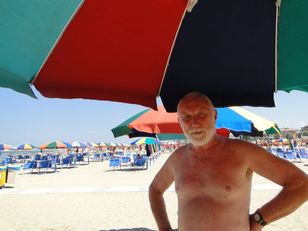 Ian poses on Rimini beach.
Ian poses on Rimini beach.
Tuesday 10 June 2014
After making full use of the facilities available at Fermo sosta we wound our way through the backstreets, and under the railway, to the main road where we turned right for Rimini.
We decided it would be best to take the toll road and avoid Ancona. After Ancona we made another decision to stay on the toll road and avoid all the small towns along the coast road.
Although the weather was very warm we had an easy run, only spoilt by the expansion gaps on bridges trying to shake Bessy to pieces.
On leaving the toll road, which had cost us €10, we headed for LIDL because Ian forgot to buy eggs yesterday. There was one sign and after that we were in a maze of backstreets without signs. We gave up and headed for the sea front.
Rimini is a sort of Italian Benidorm. Not so many tower blocks but still a well packed town catering for mass tourism. The first camp we came across was mentioned in Lonely Planet... probably another reason not to believe everything you read in a book. Camp Italia is an old campsite that shows its age. The price is €32 a night and wifi is an extortionate €1 an hour or €6 for 12 hours. We took the accommodation but not the wifi.
The camp has two redeeming features, the sea is just across the road and there are lots of shade trees. We might add that the fee entitles you to a beach umbrella on the sand.
In early June the beach was quiet but we were surrounded by millions of beach umbrellas and sun beds. Making beach umbrellas must be a good business.
In the evening we enjoyed chatting to a couple from Amsterdam. Hans told us they drove through Albania last year... it’s given us an idea for a run to Greece.
After making full use of the facilities available at Fermo sosta we wound our way through the backstreets, and under the railway, to the main road where we turned right for Rimini.
We decided it would be best to take the toll road and avoid Ancona. After Ancona we made another decision to stay on the toll road and avoid all the small towns along the coast road.
Although the weather was very warm we had an easy run, only spoilt by the expansion gaps on bridges trying to shake Bessy to pieces.
On leaving the toll road, which had cost us €10, we headed for LIDL because Ian forgot to buy eggs yesterday. There was one sign and after that we were in a maze of backstreets without signs. We gave up and headed for the sea front.
Rimini is a sort of Italian Benidorm. Not so many tower blocks but still a well packed town catering for mass tourism. The first camp we came across was mentioned in Lonely Planet... probably another reason not to believe everything you read in a book. Camp Italia is an old campsite that shows its age. The price is €32 a night and wifi is an extortionate €1 an hour or €6 for 12 hours. We took the accommodation but not the wifi.
The camp has two redeeming features, the sea is just across the road and there are lots of shade trees. We might add that the fee entitles you to a beach umbrella on the sand.
In early June the beach was quiet but we were surrounded by millions of beach umbrellas and sun beds. Making beach umbrellas must be a good business.
In the evening we enjoyed chatting to a couple from Amsterdam. Hans told us they drove through Albania last year... it’s given us an idea for a run to Greece.
 Baptistry of neoniano, Rvenna.
Baptistry of neoniano, Rvenna.
Wednesday 11 June 2014
Ravenna is, quite rightly, famous for the mosaics in the several churches and other religious buildings. We found a car park in the centre with no real problems other than we were baking. The temperature is around 35°C.
Thankfully the churches were nice and cool.
The first place was just 100 yards away, St Vitale Basilica. It was consecrated in 547. There are scenes from the Old Testament on the walls near the altar. Our Old Testament is not what it used to be; we could recognize Abraham preparing to sacrifice Isaac... with three angels watching over the proceedings. On the other wall was the death of Abel.
The roof and walls are magnificent.
In the same grounds is the Galla Placidia Mausoleum. This contains the oldest mosaics in Ravenna, dating from AD430.
The centre of Ravenna is not extensive and it was only a short walk to Battistero Neoniano. which is next to the duomo. This place was built on top of the remains of a Roman bath. The mosaics show Jesus being baptised in the Jordan river.
The other site of great note is the St Apollinare Basilica. There is a legend that Pope Gregory the Great ordered the mosaics to be blackened as they were a distraction from prayer. They are certainly impressive. On one side of the aisle are 26 martyrs walking to christ and his apostles, while on the other side are 26 virgins heading for the madonna.
We missed a couple of sites, but headed back to the Archeological Museum to see a throne made from ivory. But photographs are not allowed.
If you like slabs of stone with inscriptions this is the place for you. If you love elephants it is not.
It really was a warm day and we treated ourselves to a cold drink. Sadly we should have carried our own water. The prices were Roman.
When we got back to the car park it was clear that there would never be any shade so we drove south a few kilometers to Casse and bedded down there.
In the evening a nice neighbour called Pasquale (?spelling) gave us directions to a place to stay further north and where we could get the boat to Venice.
Ravenna is, quite rightly, famous for the mosaics in the several churches and other religious buildings. We found a car park in the centre with no real problems other than we were baking. The temperature is around 35°C.
Thankfully the churches were nice and cool.
The first place was just 100 yards away, St Vitale Basilica. It was consecrated in 547. There are scenes from the Old Testament on the walls near the altar. Our Old Testament is not what it used to be; we could recognize Abraham preparing to sacrifice Isaac... with three angels watching over the proceedings. On the other wall was the death of Abel.
The roof and walls are magnificent.
In the same grounds is the Galla Placidia Mausoleum. This contains the oldest mosaics in Ravenna, dating from AD430.
The centre of Ravenna is not extensive and it was only a short walk to Battistero Neoniano. which is next to the duomo. This place was built on top of the remains of a Roman bath. The mosaics show Jesus being baptised in the Jordan river.
The other site of great note is the St Apollinare Basilica. There is a legend that Pope Gregory the Great ordered the mosaics to be blackened as they were a distraction from prayer. They are certainly impressive. On one side of the aisle are 26 martyrs walking to christ and his apostles, while on the other side are 26 virgins heading for the madonna.
We missed a couple of sites, but headed back to the Archeological Museum to see a throne made from ivory. But photographs are not allowed.
If you like slabs of stone with inscriptions this is the place for you. If you love elephants it is not.
It really was a warm day and we treated ourselves to a cold drink. Sadly we should have carried our own water. The prices were Roman.
When we got back to the car park it was clear that there would never be any shade so we drove south a few kilometers to Casse and bedded down there.
In the evening a nice neighbour called Pasquale (?spelling) gave us directions to a place to stay further north and where we could get the boat to Venice.
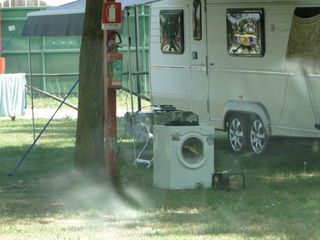 Essential equipment for motorhomers.
Essential equipment for motorhomers.
Thursday 12 June 2014
On the way north we stopped at an Iperstore in a shopping complex. It really has to be one of the biggest hypermarkets we’ve ever seen. They had everything except fly-curtains. Why is it that every house in Italy has a fly-curtain of some sort, but nobody sells them?
Shortly after we were at Pasquale’s designated camp site. We showed the man at reception the note from Pasquale and he was delighted. In his best Italian/English he then tried to describe a problem with the campsite. It had been taken over by about 20 Irish Traveller caravans. He was afraid of them as he had heard many stories from the UK and other places.
We told him we would be OK and set up camp.
It is very educational and an anthropologist would have had a field day. Every caravan was big and long and pulled by a very luxurious car such as a Volvo, BMW, Mercedes or a Toyota. Outside every caravan was a washing machine, quietly trundling away. When we arrived there were no men in the camp at all. The woman were either cleaning house, doing the washing or collected in groups having a good natter. The accent was as thick as a peat bog, accented with squawks to the children to get out of the sand, stop tormenting the dog, etc.
It was only around 18:00 that the men returned, dressed very smartly. One man explained that they came from Limerick and had been in Italy for one month, but would be leaving the camp on Saturday. The receptionist was praying for this as the campsite was beginning to get covered in discarded shampoo bottles and other rubbish. But to be fair, a couple of teenage lads were tarting themselves up in the washroom and were bemoaning the fact that the place was like a tip. A woman came to do her washing up and spent a considerable time cleaning the area. In other words, someone dropped rubbish and others didn’t like it. But probably dare not say so.
We sat around for three days and relaxed a bit. Meanwhile the camp became scruffier and noisier. On Friday night one of the travellers asked the nice man at reception if they could stay another week. My Italian is rubbish but I got the impression he said “No” because another group was booked in!
The men stood in the open in a group and spent some hours discussing where to go.
Saturday morning arrived and the men formed a group again, still discussing the target for tonight. The women were packing very slowly as if they seemed to knew how long the discussions last.
Around 15:00 two or three cars set off, presumably on a recce, and came back an hour later. Then the action started, Transit vans appeared from nowhere, caravans were hooked up and off the went in a massive convoy.
Peaceful at last.
Ian stayed up after midnight to watch Italy beat England 2-1 in the World Cup.
On the way north we stopped at an Iperstore in a shopping complex. It really has to be one of the biggest hypermarkets we’ve ever seen. They had everything except fly-curtains. Why is it that every house in Italy has a fly-curtain of some sort, but nobody sells them?
Shortly after we were at Pasquale’s designated camp site. We showed the man at reception the note from Pasquale and he was delighted. In his best Italian/English he then tried to describe a problem with the campsite. It had been taken over by about 20 Irish Traveller caravans. He was afraid of them as he had heard many stories from the UK and other places.
We told him we would be OK and set up camp.
It is very educational and an anthropologist would have had a field day. Every caravan was big and long and pulled by a very luxurious car such as a Volvo, BMW, Mercedes or a Toyota. Outside every caravan was a washing machine, quietly trundling away. When we arrived there were no men in the camp at all. The woman were either cleaning house, doing the washing or collected in groups having a good natter. The accent was as thick as a peat bog, accented with squawks to the children to get out of the sand, stop tormenting the dog, etc.
It was only around 18:00 that the men returned, dressed very smartly. One man explained that they came from Limerick and had been in Italy for one month, but would be leaving the camp on Saturday. The receptionist was praying for this as the campsite was beginning to get covered in discarded shampoo bottles and other rubbish. But to be fair, a couple of teenage lads were tarting themselves up in the washroom and were bemoaning the fact that the place was like a tip. A woman came to do her washing up and spent a considerable time cleaning the area. In other words, someone dropped rubbish and others didn’t like it. But probably dare not say so.
We sat around for three days and relaxed a bit. Meanwhile the camp became scruffier and noisier. On Friday night one of the travellers asked the nice man at reception if they could stay another week. My Italian is rubbish but I got the impression he said “No” because another group was booked in!
The men stood in the open in a group and spent some hours discussing where to go.
Saturday morning arrived and the men formed a group again, still discussing the target for tonight. The women were packing very slowly as if they seemed to knew how long the discussions last.
Around 15:00 two or three cars set off, presumably on a recce, and came back an hour later. Then the action started, Transit vans appeared from nowhere, caravans were hooked up and off the went in a massive convoy.
Peaceful at last.
Ian stayed up after midnight to watch Italy beat England 2-1 in the World Cup.
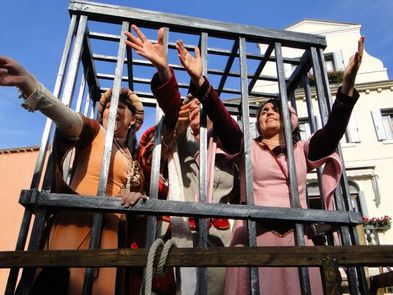
Sunday 15 June 2014
Heading for Chioggia where we can camp and take a boat to Venice. But first we drove around the Po delta. We had a walk around Gorino and found another sosta on the harbour. The area is criss-crossed with canals, ditches and dykes; in some way resembling parts of Nederland. After leaving Gorino we had to cross a wooden pontoon bridge and pay the €3 toll. Soon we were on the main road north and stopped again at Porto Viro to visit a Chinese shop in case they had fly curtains. No such luck. Round the corner was a LIDL so we did a bit of stocking up on essentials, such as cheap whisky. Why are UK residents paying massive taxes on booze so that Italians and Spanish can buy it cheap?
The road was good and we were soon in Chioggia, but the first “sosta” was a car park with big signs telling MHs to go away.
No real problem as the roads were wide, even though they were filled with suicidal cyclists. Soon we were at the sosta in Sottomarina. The two towns are almost the same but Sottomarina is new and touristy while Chioggia is old and traditional.
Heading for Chioggia where we can camp and take a boat to Venice. But first we drove around the Po delta. We had a walk around Gorino and found another sosta on the harbour. The area is criss-crossed with canals, ditches and dykes; in some way resembling parts of Nederland. After leaving Gorino we had to cross a wooden pontoon bridge and pay the €3 toll. Soon we were on the main road north and stopped again at Porto Viro to visit a Chinese shop in case they had fly curtains. No such luck. Round the corner was a LIDL so we did a bit of stocking up on essentials, such as cheap whisky. Why are UK residents paying massive taxes on booze so that Italians and Spanish can buy it cheap?
The road was good and we were soon in Chioggia, but the first “sosta” was a car park with big signs telling MHs to go away.
No real problem as the roads were wide, even though they were filled with suicidal cyclists. Soon we were at the sosta in Sottomarina. The two towns are almost the same but Sottomarina is new and touristy while Chioggia is old and traditional.
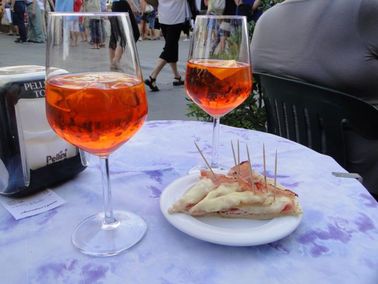
In the evening we did a test walk to the jetty for the boat to Venice. However it rapidly became obvious that some sort of event was taking place. The roads were blocked by policemen and the streets were lined with stalls. At the stalls were people in medieval costumes making things or demonstrating things, such as bread making, archery, copper work and a thousand other pastimes of that period.
The streets were packed with the great and the good of the city slowly drifting up and down the main street occasionally nipping off to the opposite side of the street for a drink of the local brew. After barging our way through the crowds we eventually found the jetty for the boat. It was at that point we decided that the walk to the boat, before and after walking round Venice would be too much It would add another three miles to the Venice ramblings.
On our return route we asked about the strange orange coloured drink everyone was consuming. It’s called Aporelo Spritzer and was accompanied by a few small slices of pizza. The drink itself is very refreshing and has a distinct bitterness that is very pleasant. Later we looked it up and found that it is made from sparkling wine, sparkling water and a dash of the Aporelo, finished off with a slice of orange and lots of ice.
The streets were packed with the great and the good of the city slowly drifting up and down the main street occasionally nipping off to the opposite side of the street for a drink of the local brew. After barging our way through the crowds we eventually found the jetty for the boat. It was at that point we decided that the walk to the boat, before and after walking round Venice would be too much It would add another three miles to the Venice ramblings.
On our return route we asked about the strange orange coloured drink everyone was consuming. It’s called Aporelo Spritzer and was accompanied by a few small slices of pizza. The drink itself is very refreshing and has a distinct bitterness that is very pleasant. Later we looked it up and found that it is made from sparkling wine, sparkling water and a dash of the Aporelo, finished off with a slice of orange and lots of ice.
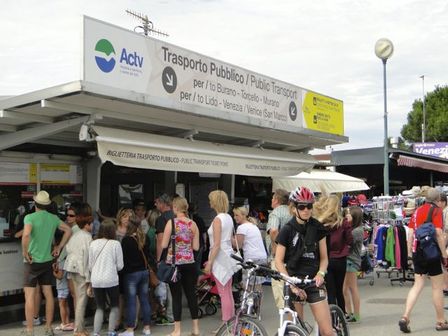 Public boat to Venice. Beware of imitations.
Public boat to Venice. Beware of imitations.
Monday 16 June 2014
Although our target stop was only 17 miles away it took almost two hours to get there. The reason being that the 17 miles is by water and we had to drive the long way around Venice and then along the Jesolo peninsula. The roads were throng with German tourists and the traffic was moving very slowly.
The camp is called Da Scarpa and is very pleasant indeed. In the afternoon we did another test walk to the boat. We were confused at first because there are hundreds of signs to the boats. However we met a nice Romanian guy at a restaurant and he told us that they were all private boats and we should move down the coast a few hundred yards to the public transport service.
While buying two 36-hour tickets for €25 each Judit spotted an advert for a special offer of another €25 each that would give us entry to various museums. The cashier took about 10 minutes to print out three A4 sheets which would be our tickets for the museum. Everything sorted we went back to the camp. It was strange that only one sheet had been printed and the other two were blank.
Although our target stop was only 17 miles away it took almost two hours to get there. The reason being that the 17 miles is by water and we had to drive the long way around Venice and then along the Jesolo peninsula. The roads were throng with German tourists and the traffic was moving very slowly.
The camp is called Da Scarpa and is very pleasant indeed. In the afternoon we did another test walk to the boat. We were confused at first because there are hundreds of signs to the boats. However we met a nice Romanian guy at a restaurant and he told us that they were all private boats and we should move down the coast a few hundred yards to the public transport service.
While buying two 36-hour tickets for €25 each Judit spotted an advert for a special offer of another €25 each that would give us entry to various museums. The cashier took about 10 minutes to print out three A4 sheets which would be our tickets for the museum. Everything sorted we went back to the camp. It was strange that only one sheet had been printed and the other two were blank.
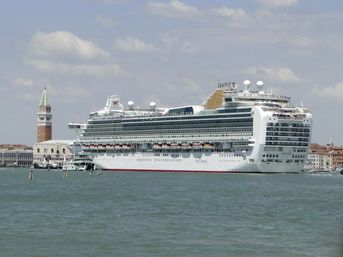 Ventura approaches Venice.
Ventura approaches Venice.
VENICE Tuesday 17 June 2014
After a good breakfast, to keep us going all day, we walked to the jetty, validated our tickets and boarded one of the boats. It’s a little confusing because there are signs for two jetties, each one stating “Venice”. Clearly not true, but we finally got on the correct boat. The journey to Venice takes about 30 minutes and stops at San Marco. Could not be better.
Of we went through the crowds to the first museum, the Doge’s Palace. The ticket man told us that the printed sheet was not enough and we should have other sheets with barcodes. Great!
Back to the jetty, onto the boat for the journey back to Punto Sabbioni.
We went to the first office where we had bought the tickets and the woman refused to help at all. We stood our ground and soon a massive queue of German tourists was behind us. She still would not budge so Ian did a bit of shouting and foot stamping. This brought a threat of the Police, but we were happy with that. After about 30 minutes telling us we had to talk to the lady who had printed the tickets last night the lady herself appeared, took us to another office where she printed the two missing pages. What a palaver!
So we soon had our second visit to Venice that morning.
Ian’s best Venice moment was when our boat followed the P&O cruise liner Ventura as it inched it’s way to the dockside. Quite majestic.
After a good breakfast, to keep us going all day, we walked to the jetty, validated our tickets and boarded one of the boats. It’s a little confusing because there are signs for two jetties, each one stating “Venice”. Clearly not true, but we finally got on the correct boat. The journey to Venice takes about 30 minutes and stops at San Marco. Could not be better.
Of we went through the crowds to the first museum, the Doge’s Palace. The ticket man told us that the printed sheet was not enough and we should have other sheets with barcodes. Great!
Back to the jetty, onto the boat for the journey back to Punto Sabbioni.
We went to the first office where we had bought the tickets and the woman refused to help at all. We stood our ground and soon a massive queue of German tourists was behind us. She still would not budge so Ian did a bit of shouting and foot stamping. This brought a threat of the Police, but we were happy with that. After about 30 minutes telling us we had to talk to the lady who had printed the tickets last night the lady herself appeared, took us to another office where she printed the two missing pages. What a palaver!
So we soon had our second visit to Venice that morning.
Ian’s best Venice moment was when our boat followed the P&O cruise liner Ventura as it inched it’s way to the dockside. Quite majestic.
 Inside the Doge's Palace.
Inside the Doge's Palace.
Sure enough the barcodes worked and we were in the Doge’s Palace.
The whole place is full of painted walls and ceilings. The ceiling paintings are surrounded by what can only be described as gigantic gilt picture frames. It is quite amazing. For a full description you need a guide book because the whole effect is overload.
A fascinating feature is a slot in a wall where you can slip a note about treason to the Council of 10. These 10 secret individuals pass sentence and the guilty are sent across the Bridge of Sighs to the prison, complete with cells and graffiti protesting innocence.
Next stop was the Museo Correr which is really a royal palace. Room after room where the titled folk of Europe stayed, including the Austro-Hungarian team. Napoleon filled the place with lots of goodies by Tintoretto, Titian and other old masters.
Back across the square to Basilica San Marco filled with Byzantine gold mosaics; 8500 square meters of it. Ian commented that he had seen better and that the place looked like it could do with a good dusting.
Then we had a good walk, stopping at three other churches before crossing the Academia Bridge. Our aim was to find the Palace Rezzonico but we got lost. We did find it and also discovered that it was closed on Tuesdays!
We were pleased to find that our travel tickets worked on vaporetto (boat/buses) and sailed down the grand canal to St Marc’s again where we changed to the bigger boat back to Punto Sabbioni and a much needed Aporelo Spriz.
The whole place is full of painted walls and ceilings. The ceiling paintings are surrounded by what can only be described as gigantic gilt picture frames. It is quite amazing. For a full description you need a guide book because the whole effect is overload.
A fascinating feature is a slot in a wall where you can slip a note about treason to the Council of 10. These 10 secret individuals pass sentence and the guilty are sent across the Bridge of Sighs to the prison, complete with cells and graffiti protesting innocence.
Next stop was the Museo Correr which is really a royal palace. Room after room where the titled folk of Europe stayed, including the Austro-Hungarian team. Napoleon filled the place with lots of goodies by Tintoretto, Titian and other old masters.
Back across the square to Basilica San Marco filled with Byzantine gold mosaics; 8500 square meters of it. Ian commented that he had seen better and that the place looked like it could do with a good dusting.
Then we had a good walk, stopping at three other churches before crossing the Academia Bridge. Our aim was to find the Palace Rezzonico but we got lost. We did find it and also discovered that it was closed on Tuesdays!
We were pleased to find that our travel tickets worked on vaporetto (boat/buses) and sailed down the grand canal to St Marc’s again where we changed to the bigger boat back to Punto Sabbioni and a much needed Aporelo Spriz.
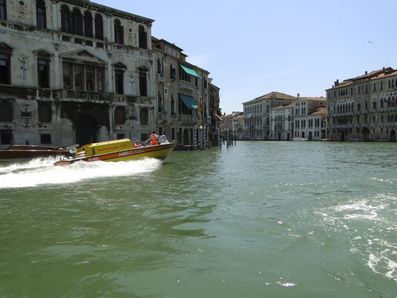 A water Ambulance speeds along the Grand Canal.
A water Ambulance speeds along the Grand Canal.
VENICE Wednesday 18 June 2014
Back to Venice. First job was to find the Palace Rezzonico which was closed yesterday. Judit bought a €5.50 reduced ticket and Ian waited outside having had his fill of paintings of the Madonna in unlikely surroundings accompanied by people he’d never read about in the Bible.
It turned out to be a good choice because the lady in the coffee shop had lots of information about Venice. For example, look closely at the menu outside a cafe. It may inform you, in very small type, that there is a surcharge for sitting at a table. Sneaky.
She also told me that St Marc’s square was the lowest point in Venice “and it floods if a baby has a pee-pee.”
Judit meanwhile enjoyed her walk around the museum.
We took the vaporetto further along the Grand Canal to Palace Fontana Ca’ d’Ora. The triple Gothic facade hides many priceless masterpieces looted by Napoleon: Mantegna’s arrow riddled Saint Sebastian.
A highlight was watching an egret fishing in the canal entrance. Very beautiful and elegant.
Now began another meander through streets narrow and narrower to Palazzo Querini Stampalia, stopping on the way to view another church.
The Stampalia place is very confusing with corridors and steps making the place very handicapped unfriendly and with very few signs saying where to go. After much buggering about listening to ancient Japanese “music” we found a lift that went up two floors. Even Lonely Planet spent 20 lines saying nothing special about the place.
Now we were in a walking mood and took more twists and turns before finding ourselves at the jetty for our boat back to Punta Sabbioni.
Back to Venice. First job was to find the Palace Rezzonico which was closed yesterday. Judit bought a €5.50 reduced ticket and Ian waited outside having had his fill of paintings of the Madonna in unlikely surroundings accompanied by people he’d never read about in the Bible.
It turned out to be a good choice because the lady in the coffee shop had lots of information about Venice. For example, look closely at the menu outside a cafe. It may inform you, in very small type, that there is a surcharge for sitting at a table. Sneaky.
She also told me that St Marc’s square was the lowest point in Venice “and it floods if a baby has a pee-pee.”
Judit meanwhile enjoyed her walk around the museum.
We took the vaporetto further along the Grand Canal to Palace Fontana Ca’ d’Ora. The triple Gothic facade hides many priceless masterpieces looted by Napoleon: Mantegna’s arrow riddled Saint Sebastian.
A highlight was watching an egret fishing in the canal entrance. Very beautiful and elegant.
Now began another meander through streets narrow and narrower to Palazzo Querini Stampalia, stopping on the way to view another church.
The Stampalia place is very confusing with corridors and steps making the place very handicapped unfriendly and with very few signs saying where to go. After much buggering about listening to ancient Japanese “music” we found a lift that went up two floors. Even Lonely Planet spent 20 lines saying nothing special about the place.
Now we were in a walking mood and took more twists and turns before finding ourselves at the jetty for our boat back to Punta Sabbioni.
Thursday 19 June 2014
No more museums today. Get tidy, clean up and relax. Ian made some website notes and Judit threw some clothes in the camp washing machine. Only €2 a load.
We also went for a walk to the beach. It’s big and covered in Germans.
Near the beach is a campsite that, according to Roberta, is one of the biggest in Europe. She used to work there and said they normally have 15,000 happy campers on site. Three or four motorhomes were parked in the street waiting to be allowed to enter and five people were guiding the traffic at the gates. Roberta said that in the high season MHs are parked outside for up to three days waiting to get in. Those people are not like us... thank goodness.
In the evening Roberta’s mum invited Ian into the house to watch England play Uruguay. England played badly and lost! Out of the World Cup in the first round!
A fellow camper, Hubert from Frankfurt, told us that they had parked near the beach yesterday and had all their documents, keys, jewels and money stolen from the van. The thieves put a screwdriver in the lock and forced it open.
Later in the day they went back to the area and found the documents and spare keys in the nearby forest.
In the evening Hubert and wife went to the nearby lighthouse and met another couple. That couple had parked their MH and walked 100 meters to the lighthouse. They had been gone 10 minutes and their van was broken into. Clearly this is not a good place to leave a MH alone.
No more museums today. Get tidy, clean up and relax. Ian made some website notes and Judit threw some clothes in the camp washing machine. Only €2 a load.
We also went for a walk to the beach. It’s big and covered in Germans.
Near the beach is a campsite that, according to Roberta, is one of the biggest in Europe. She used to work there and said they normally have 15,000 happy campers on site. Three or four motorhomes were parked in the street waiting to be allowed to enter and five people were guiding the traffic at the gates. Roberta said that in the high season MHs are parked outside for up to three days waiting to get in. Those people are not like us... thank goodness.
In the evening Roberta’s mum invited Ian into the house to watch England play Uruguay. England played badly and lost! Out of the World Cup in the first round!
A fellow camper, Hubert from Frankfurt, told us that they had parked near the beach yesterday and had all their documents, keys, jewels and money stolen from the van. The thieves put a screwdriver in the lock and forced it open.
Later in the day they went back to the area and found the documents and spare keys in the nearby forest.
In the evening Hubert and wife went to the nearby lighthouse and met another couple. That couple had parked their MH and walked 100 meters to the lighthouse. They had been gone 10 minutes and their van was broken into. Clearly this is not a good place to leave a MH alone.
Udine, Friday 20 June 2014
Heading for Udine. On our way we saw some fly curtains at last, but they were very expensive so maybe we have to make our own.
We arrived at Udine in the afternoon and were greeted in the usual warm and friendly way by Giuseppe and family. While dinner was being prepared Giuseppe and Fabio took us for a walk around the town where we sat beside a river and enjoyed a cool beer.
As we anticipated, dinner was excellent and we chatted for ages before retiring.
Heading for Udine. On our way we saw some fly curtains at last, but they were very expensive so maybe we have to make our own.
We arrived at Udine in the afternoon and were greeted in the usual warm and friendly way by Giuseppe and family. While dinner was being prepared Giuseppe and Fabio took us for a walk around the town where we sat beside a river and enjoyed a cool beer.
As we anticipated, dinner was excellent and we chatted for ages before retiring.
Saturday 21 June 2014
After a reasonably early start we pointed towards Slovenia and Hungary. Fabio had mentioned the damage caused by freezing rain in Slovenia. He was right... for miles each side of Postojne the tops of trees had been ripped off with the weight of ice.
Around mid-afternoon we arrived in Letenye to the nice little camp we’d tried before. We took the opportunity to try the thermal pools while there. It was even possible to buy some chips to take to the MH to supplement the dinner... wonderful.
After a reasonably early start we pointed towards Slovenia and Hungary. Fabio had mentioned the damage caused by freezing rain in Slovenia. He was right... for miles each side of Postojne the tops of trees had been ripped off with the weight of ice.
Around mid-afternoon we arrived in Letenye to the nice little camp we’d tried before. We took the opportunity to try the thermal pools while there. It was even possible to buy some chips to take to the MH to supplement the dinner... wonderful.
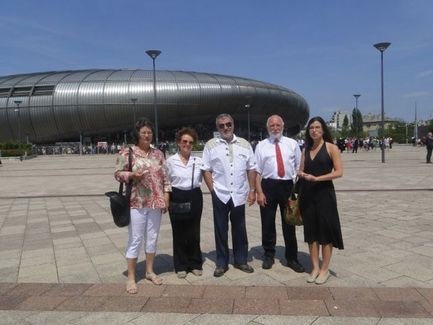 Panka (Right) after graduating as a doctor. Well done.
Panka (Right) after graduating as a doctor. Well done.
Sunday 22 June 2014
Back in Almadi. The grass needs a trim, the weeds need pulling out and one of the walnut trees looks like it’s in need of felling.
In fact it was one of the first jobs. The two guys were very efficient and demolished the tree in 90 minutes for approximately £50. Take note St Albans residents!
Other events included visits from and to old friends and family and, of course, the graduation ceremony when Judit’s niece became a doctor.
Back in Almadi. The grass needs a trim, the weeds need pulling out and one of the walnut trees looks like it’s in need of felling.
In fact it was one of the first jobs. The two guys were very efficient and demolished the tree in 90 minutes for approximately £50. Take note St Albans residents!
Other events included visits from and to old friends and family and, of course, the graduation ceremony when Judit’s niece became a doctor.
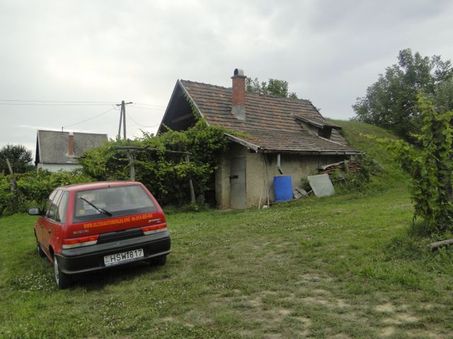 Our rented Suzuki outside the family wine cellar.
Our rented Suzuki outside the family wine cellar.
We rented a car for a period and found that you do NOT have to use expensive AVIS or HERTZ. Some Hungarians rent out cheap and cheerful cars for 10% of the price big boys charge. (about £12.50 a day)The people we used were very helpful and polite. They even drove to us after a few weeks to check the car was OK.
http://www.olcsoautoberles.org/
It’s all in Hungarian, but don’t worry, many Hungarians speak English or German.
Naturally Ian took advantage of the dental service in Hungary. Luckily in Almadi we have a nice 70 year old dentist who charges sensible prices and he has a sense of humour.
Strangely the Hungarian Summer has not been as scorching as previous years. In fact it has rained most of the days for a short period. During Pat’s visit to us we had a thunderstorm every day for two weeks
http://www.olcsoautoberles.org/
It’s all in Hungarian, but don’t worry, many Hungarians speak English or German.
Naturally Ian took advantage of the dental service in Hungary. Luckily in Almadi we have a nice 70 year old dentist who charges sensible prices and he has a sense of humour.
Strangely the Hungarian Summer has not been as scorching as previous years. In fact it has rained most of the days for a short period. During Pat’s visit to us we had a thunderstorm every day for two weeks
Summer in Hungary
After visiting Italy we headed for Hungary to see Judit’s family. In addition Ian seemed to spend too much time at the dentists. That meant remaining in Hungary a few weeks longer than intended.
Ian’s dentist in Almadi is a really nice semi-retired gentleman, good fun, witty and professional. The dentists in Budapest all seem to be young girls wanting to be rich quickly. Last time in Budapest the young tooth fairy insisted that Ian needed implants. The Almadi dentist pointed out that his jawbone was too narrow and he would need a bone transplant from his pelvis, plus months of follow up, and very importantly... it would be very expensive.
Our man should be compared with a UK dentist as well. Last time Ian had a crown fitted in the UK it cost £800. In Almadi, Ian had two extractions, two root canal treatments and two crowns. Total cost about £160. No contest.
But going to the dentist cannot be described as pleasant. Fortunately we did have other much more pleasant things to occupy our time. First of all our good friend Pat came to stay with us for two weeks and we were able to show her around and relax. It was a break for us as well.
We also had visitors from Canada; Judit’s cousin Elizabeth with her husband Benoit and daughters Zoe and Sarah. We only saw them for two days but we really enjoyed their visit.
So what do you do in the Lake Balaton area for over two months?
Ian’s dentist in Almadi is a really nice semi-retired gentleman, good fun, witty and professional. The dentists in Budapest all seem to be young girls wanting to be rich quickly. Last time in Budapest the young tooth fairy insisted that Ian needed implants. The Almadi dentist pointed out that his jawbone was too narrow and he would need a bone transplant from his pelvis, plus months of follow up, and very importantly... it would be very expensive.
Our man should be compared with a UK dentist as well. Last time Ian had a crown fitted in the UK it cost £800. In Almadi, Ian had two extractions, two root canal treatments and two crowns. Total cost about £160. No contest.
But going to the dentist cannot be described as pleasant. Fortunately we did have other much more pleasant things to occupy our time. First of all our good friend Pat came to stay with us for two weeks and we were able to show her around and relax. It was a break for us as well.
We also had visitors from Canada; Judit’s cousin Elizabeth with her husband Benoit and daughters Zoe and Sarah. We only saw them for two days but we really enjoyed their visit.
So what do you do in the Lake Balaton area for over two months?
Telephone tantrums
Well, there’s the usual cleaning up and tidying the garden and visiting family and friend. Several came to us and we had barbecues. Then we did a bit of cooking with the excess fruit in the garden; chutneys and jams in particular. Also a few breads, from plain loaves to muffins... real muffins, not the sweet things that used to be called buns. Amazingly TESCO started to sell oxtail and this became a firm favourite; each time slightly modified to find the best recipe... yummy.
Keeping up with the Internet was a pain as the house does not have internet. That meant going to T-mobil and topping up last year’s dongle. However T-Mobil will only supply 6 Gb for 10,000 Ft (around £25). It is possible to top it up at the post office like a mobile phone. However one day the gigabytes had expired so Ian topped up the dongle at the Post Office but found it still would not work. T-Mobil told him that you can only top up once every 44 days and 25 days remained. It took a lot of foot stamping before they eventually made a new contract for the 10,000 Ft Ian had paid.
Naturally he then went to another supplier, Telenor, who sold a dongle and a top-up of 6,000 Ft for 5 Gb. In addition it is possible to top up when you wish at a Telenor shop. Much better service than T-Mobil and much nicer people to deal with.
Well, there’s the usual cleaning up and tidying the garden and visiting family and friend. Several came to us and we had barbecues. Then we did a bit of cooking with the excess fruit in the garden; chutneys and jams in particular. Also a few breads, from plain loaves to muffins... real muffins, not the sweet things that used to be called buns. Amazingly TESCO started to sell oxtail and this became a firm favourite; each time slightly modified to find the best recipe... yummy.
Keeping up with the Internet was a pain as the house does not have internet. That meant going to T-mobil and topping up last year’s dongle. However T-Mobil will only supply 6 Gb for 10,000 Ft (around £25). It is possible to top it up at the post office like a mobile phone. However one day the gigabytes had expired so Ian topped up the dongle at the Post Office but found it still would not work. T-Mobil told him that you can only top up once every 44 days and 25 days remained. It took a lot of foot stamping before they eventually made a new contract for the 10,000 Ft Ian had paid.
Naturally he then went to another supplier, Telenor, who sold a dongle and a top-up of 6,000 Ft for 5 Gb. In addition it is possible to top up when you wish at a Telenor shop. Much better service than T-Mobil and much nicer people to deal with.
|
A highlight of our stay was to attend the graduation ceremony of Judit’s niece Panka. She is now a fully qualified doctor. The event was in a large indoor arena and hundreds of people graduated. Sadly there are very few jobs available for junior doctors in Hungary. Even then the salary is around £325 a month.. before tax! It is no surprise that graduates are leaving Hungary in their droves.
|
To simplify our “in-Hungary” travels we rented a small car for about £7.50 a day. On car related matters we had to repair a puncture for about £5 and also a wheel stud had to be replaced as some idiot had cross-threaded it. Cost with parts and labour about £4.
And while on the subject of repairs, our trusty Baby Belling cooker decided to pack in after 30 years. We took it to the local domestic appliance repair man. He replaced an element and ALL the old brittle wiring for about £10. And it was ready the next day. Beat that!
This summer has been one of the coolest and wettest for many years. This was good motivation to back up our 20,000 photos from the Mac to DVDs.
We discovered a good way to clean our cheap carpets from the motorhome; simply pressure wash them.
And while on the subject of repairs, our trusty Baby Belling cooker decided to pack in after 30 years. We took it to the local domestic appliance repair man. He replaced an element and ALL the old brittle wiring for about £10. And it was ready the next day. Beat that!
This summer has been one of the coolest and wettest for many years. This was good motivation to back up our 20,000 photos from the Mac to DVDs.
We discovered a good way to clean our cheap carpets from the motorhome; simply pressure wash them.
|
Timber
Three times we had crop dusters spraying anti mosquito chemicals. It was very effective but as soon as the holiday season ended the mozzies came back. Luckily Judit is a mosquito magnet and Ian was never bitten. We had an exciting morning when two men came to fell a large walnut tree in the garden. It had seen better days and could have been a danger. Take note all tree surgeons and similar over-priced people. The tree was felled in only 90 minutes and cost less than £50. Ukraine is next door and there may be a connection with recent Hungarian fighter aircraft activity. For over two weeks they have been thundering around in their half dozen Saab Drakens which were bought years ago. One assumes they do fly now and again but this is the first time we have seen such activity. |
|
Apart from domestic matters there are things to do and see in the area. While Pat was staying with us we visit Kapolcs valley. It is an annual event for arty crafty people.
From Almadi it is possible to take a boat to various parts of the Lake. We took Pat to Tihany. The journey takes 90 minutes each way. The weather was kind to us and the trip was very pleasant and relaxing. Not far from Almadi is a Roman villa that is worth a visit, even though we’ve seen quite a lot on our travels. There are art galleries in Balaton Füred and museums in the Badacsony area. Zirc and Csesznek Castle are worth a day out. In the same area is Herend where the famous Herendi Porcelain is made. The factory has been renovated and guided tours are available. All the ceramics are hand painted and it is wonderful to see such craftsmanship. |
|
Fly me to the moon...
The museum that Ian enjoyed most was the Observatory at Bakonybél. There we could watch high definition movies of space and the night sky in the planetarium, static exhibitions and the telescopes themselves. We even had a peep at the sun and could see the solar flares and spots. Very good indeed. For a bit of fun shopping visit the gypsy market on Sundays in Veszprem. Hundreds of stalls selling things you never knew you needed. Every summer there are concerts in the small village of Vaszoly and we were able to attend one evening to watch Panka playing her oboe. The adventurous types will enjoy a visit to Balaton Bob near Fuzfö. This is a so-called bobsleigh run down a wooded hillside. The facilities have really been modernized with two tracks, a children's adventure playground (free) and a very exciting adult adventure playground, plus a climbing wall. Worth a visit and it’s open every day. You will be interested to know that your EU contributions not only go towards providing water, electricity and roads to Eastern Europe, we also subsidise businesses. This is one of them. Can a person in the UK obtain an EU grant to start up a business? |
The coolest wettest summer in Hungary for many years. During the three month “holiday season” we experienced 24 days of rain and/overcast, 15 days of thunderstorms. In addition we could see storms going on around us.
Szia Magyarország, Tuesday 7 October 2014
After what seemed like ages we finished some last minute cleaning and packing. But the water system had to be drained and winterized before we could finally leave Alamdi at 11-30. Now that all the tourists have gone we had a lovely quiet run down the side of Lake Balaton before turning right at Zanka towards Tapolca. After Tapolca we turned North onto the No.8 road towards Körmend and Szentgotthard.
Hungary is well known for having some long place names, such as Satoralyaújhely. We were therefore surprised to pass through a village called simply, “Ukk”.
Near the Austrian border we stopped for lunch at a restaurant called Desperados. It really does look like a cowboy place and they served steaks. Normally ordering beef in Hungary is not very good idea, but Ian had a pepper steak and it was delicious.
We stopped down the road at Lukoil and topped up with diesel. We were trying to use up 10,000 Ft notes. The government are planning to change the note and our left overs may be useless next year.
Being part of the Schengen group the border was no obstacle at all and soon after we turned off the main road to an aire at LAMMER. It had no facilities but was supposed to cost €10 a night but nobody asked for money. It was a quiet spot but in the evening 4 cars driven by Austrian louts invaded the area and started spinning the cars and doing handbrake turns. One came within 2 feet of the back of Bessy. Ian’s presence with a large black Maglite torch seemed to put them off and the quickly departed... thank goodness.
Hungary is well known for having some long place names, such as Satoralyaújhely. We were therefore surprised to pass through a village called simply, “Ukk”.
Near the Austrian border we stopped for lunch at a restaurant called Desperados. It really does look like a cowboy place and they served steaks. Normally ordering beef in Hungary is not very good idea, but Ian had a pepper steak and it was delicious.
We stopped down the road at Lukoil and topped up with diesel. We were trying to use up 10,000 Ft notes. The government are planning to change the note and our left overs may be useless next year.
Being part of the Schengen group the border was no obstacle at all and soon after we turned off the main road to an aire at LAMMER. It had no facilities but was supposed to cost €10 a night but nobody asked for money. It was a quiet spot but in the evening 4 cars driven by Austrian louts invaded the area and started spinning the cars and doing handbrake turns. One came within 2 feet of the back of Bessy. Ian’s presence with a large black Maglite torch seemed to put them off and the quickly departed... thank goodness.
|
Foggy, Wednesday 8 October 2014
After a bit of hassle with the GPS wishing to take us down some very narrow roads we ignored it and went back to the main road for GRAZ. We do not wish to use motorways because we are over 3.5 ton and therefore treated as a lorry in Austria. To use motorways we would have to buy a Go-Box and preload it with Euros. A quick calculation showed that to cross Austria we would be charged about €100. So we are on the old roads. We stopped for lunch in a shopping centre car park near Köflach. Luckily they had a BILLA supermarket where we bought a few fresh items. It was very clean and tidy with lots of very fresh stock. The scenic route took us past JUDENBURG. The route was very pleasant but steep and winding in parts. Just after the town we turned a corner and immediately in front of us was a strange junction. A last second decision took us onto the autobahn! We had to continue and got off at the next junction having gone backwards about 8 Km. Luckily we were not stopped. Soon we were back on another scenic route to TRIEBEN and were getting a bit tired as we’d been on the road for about 8 hours. LIEZEN was just a few K away and we stopped in the stellplatz behind the Sports Hall. Free but no facilities other than water. We wound down with a walk around the area and watched the locals playing a sort of dry-land curling outside the sports hall. |
The disappearing Stellplatz, Thursday 9 October 2014
After a good sleep we were ready for the 90 minute drive to Wolfgangsee (Lake) and the stellplatz at Sankt Gilgen. The area is very pretty and much like the Lake District. When we arrived at the stellplatz the car park was packed solid with cars and there was a sign “No Camping”.
OK we’ll go the the next nearest stellplatz at Mondsee. Again, the car park was full and there was no indication that it was a stellplatz. We were disappointed by the Austrian attitude to motorhomes and in particular motorhomes over 3.5 ton, so it was “Goodbye Austria”.
We drove slowly through Salzburg because of the extensive roadworks and into Germany at FREILASSING. There was a stellplatz and we settled in. We had time for a walk around the pleasant small town centre and even bought some kebap meat for dinner from the Turkish kebap shop.
One of the other motorhomers was a German ex-helicopter pilot called Joe. He told us we could dump just round the corner at the local sewerage works. The following morning we did that and they were very helpful.
After a good sleep we were ready for the 90 minute drive to Wolfgangsee (Lake) and the stellplatz at Sankt Gilgen. The area is very pretty and much like the Lake District. When we arrived at the stellplatz the car park was packed solid with cars and there was a sign “No Camping”.
OK we’ll go the the next nearest stellplatz at Mondsee. Again, the car park was full and there was no indication that it was a stellplatz. We were disappointed by the Austrian attitude to motorhomes and in particular motorhomes over 3.5 ton, so it was “Goodbye Austria”.
We drove slowly through Salzburg because of the extensive roadworks and into Germany at FREILASSING. There was a stellplatz and we settled in. We had time for a walk around the pleasant small town centre and even bought some kebap meat for dinner from the Turkish kebap shop.
One of the other motorhomers was a German ex-helicopter pilot called Joe. He told us we could dump just round the corner at the local sewerage works. The following morning we did that and they were very helpful.
|
Bavaria, Friday 10 October 2014
After dumping we took the FREE autobahn in the direction of Lake Constance. That meant negotiating Munich. There is a ring road around the north but not at the south. They are building a southern inner ring but traffic management was awful and it took ages to get through. Finally we were on our way again, but were held up by two more roadworks. But we got to the lake only to find that so-called stellplatz were either expensive or literally at the side of a main road. The decision was made to go another 40 km to Radolfzell where were have stayed before. Once again, man-made hold ups. The local official idiots had made a 30 km/hour speed limit through two of the small towns. Cameras everywhere to make sure you kept to this 2nd gear limit. The result was that there was a mile long queue at each side of the town. The places stank of exhaust gases and the main roads were very crowded and noisy. Take note, you greenies... it does not work. We were lucky at RADOLFZELL as there was space and the electricity was free because the machine had broken... yippee. Our new neighbours were a wonderful couple from Australia, Kate and Michael. We enjoyed a very long evening chatting about our different adventures. |
|
Shopping and sunset, Saturday 11 October 2014
Radolfzell has a small but perfectly formed street market which really suited the old town. Fresh eggs, fresh veg, good looking meat. That was dinner organised. A walk by the lake is also very pleasant. As there was not much point in driving today, we stayed another night. Thanks Radolfzell. We think that this will become one of our “key” stop overs on routes in this direction. |
Diesel Hunting, Sunday 12 October 2014
Our first task this morning was to head for Steisslingen where we had found cheap diesel on a previous journey. However, we had forgotten it was Sunday. The only way to pay was with with plastic and we don’t fancy the idea of having a valuable card eaten by a machine because we misread the instructions.
Onwards and round in circles looking for another filling station, but no joy. We abandoned the diesel idea and headed north. After a couple of hours we were at Niederwurzbach where we had information of a stellplatz by a lake. Sadly it was no more than a car park with no facilities. The other down size was that every car in the nearby towns was trying to park in the place. It was throbbing, so we drove on and through Saarbrucken to Saarlouis where there is a pretty good Stellplatz. A nice Belgian motorhomer pointed out the local supermarket and told us we could go to a nearby campsite for dumping.
Our first task this morning was to head for Steisslingen where we had found cheap diesel on a previous journey. However, we had forgotten it was Sunday. The only way to pay was with with plastic and we don’t fancy the idea of having a valuable card eaten by a machine because we misread the instructions.
Onwards and round in circles looking for another filling station, but no joy. We abandoned the diesel idea and headed north. After a couple of hours we were at Niederwurzbach where we had information of a stellplatz by a lake. Sadly it was no more than a car park with no facilities. The other down size was that every car in the nearby towns was trying to park in the place. It was throbbing, so we drove on and through Saarbrucken to Saarlouis where there is a pretty good Stellplatz. A nice Belgian motorhomer pointed out the local supermarket and told us we could go to a nearby campsite for dumping.
|
Down to the Sea, Monday 13 October 2014
The nearby supermarket car park was not to our liking but the local LIDL served us well. On our way we passed another stellplatz sign and decided to have a peep. From our direction we had to drive through a park and then to a shopping and sports complex. 8 gypsy caravans were nicely settled in and no one seemed to mind. Just around the corner was the dump. People in nearby Merzig must make moonlight raids to steal other folks poo. The whole machine was surrounded by a sturdy steel mesh and had a massive padlock holding it all together. Never mind, we continued north and were soon passing the filling station in Luxembourg where they sell cheap diesel and cheap tobacco. Diesel at €1.15 per litre. NOTE: this is about 90p a litre. North towards Brussels and then hung a left near Namur, past Charleroi towards Lille and Dunkirk. Once in the port we booked the ferry for Tuesday morning. If you book 24 hours ahead the cost is much cheaper. We paid £39 to cross from Dunkirk to Dover. Being next door to Belgium we began to fantasize about chips so we drove down the road to the aire in Calais. We had a lovely view over the very rough sea and the ships using the port while we ate our evening meal. |
|
Meandering, Tuesday 14 October
Normally we just dash through places like Dunkirk so today we had a roam around the area. As we left Calais we had to wait for the longest train we've ever seen pass a level crossing. Thousands of new cars on board. We drove up the coast to De Panne and found that it is a very modern seaside resort. Clean and tidy but a bit too clinical for our liking. We headed west again through Bray-Dunes to Dunkirk and the real Dunkirk harbour. There was a beautiful tall-ship in port. We decide to allow the GPS free-rein and it took us along the coast road on the outer harbour. Sadly when we got halfway there the road bridge was lifted for repairs so it was back through the town streets again. At Loon-Plage we ate in a restaurant called Buffalo in the giant Auchan car park. The burger was actually made from pulled spare-rib meat and was delicious. It was then time for a final top up of diesel at €1.20 a litre. That is 94p a litre. Why is diesel in the UK one of the most expensive in Europe? Why is a cheap bottle of whisky £14 in the UK and only £3.90 in Italy? Are we paying massive taxes to pay the EU. They in turn subsidize Italy and others so that they can have cheap diesel and cheap whisky. Somethings wrong somewhere! After a quiet night in Dunkirk harbour we had a lovely smooth sunny crossing to Dover and home to the piles of letters and paperwork. |
